70days
Ten week extensive scoping trip from Colombia to the Guyanas, scheduled 15 Jan. to 25 March 2019.
Paramaribo, Surinam
Paramaribo, Surinam
Nieuw-Amsterdam, Commewijne, Surinam
Paramaribo, Surinam
Meten Meer Zorg East, Essequibo Islands-West Demerara, Guyana
Saint-Laurent-du-Maroni, Guyane, Französisch-Guyana
Roura, Guyane, Französisch-Guyana
Cacao, Roura, Französisch-Guyana
Remire-Montjoly, Guyane, Frankreich
Camopi, Guyane, Französisch-Guyana
Oiapoque, Amapá, Brasilien
Saint-Georges, Guyane, Französisch-Guyana
Cayenne, Guyane, Französisch-Guyana
Kourou, Guyane, Frankreich
Kourou, Guyane, Französisch-Guyana
Paramaribo, Surinam
Paramaribo, Surinam
Kaieteur, Chenapau, Potaro-Siparuni, Guyana
Georgetown, Demerara-Mahaica, Guyana
Georgetown, Demerara-Mahaica, Guyana
Lethem, Upper Takutu-Upper Essequibo, Guyana
Boa Vista, Roraima, Brasilien
Tepequém, Amajari, Roraima, Brasilien
Boa Vista, Roraima, Brasilien
Manaus, Amazonas, Brasilien
Manaus, Amazonas, Brasilien
Tabatinga, Amazonas, Brasilien
Atalaia do Norte, Amazonas, Brasilien
Benjamin Constant, Amazonas, Brasilien
Isla de los Micos, Leticia, Amazonas, Kolumbien
Puerto Nariño, Amazonas, Kolumbien
Puerto Nariño, Amazonas, Kolumbien
Leticia, Amazonas, Kolumbien
Leticia, Amazonas, Kolumbien
Bogotá, Distrito Capital de Bogotá, Kolumbien
Medellín, Antioquia, Kolumbien
Bahía Solano, Chocó, Kolumbien
El Valle, Bahía Solano, Chocó, Kolumbien
Medellín, Antioquia, Kolumbien
Pereira, Risaralda, Kolumbien
Medellín, Antioquia, Kolumbien
Hacienda Nápoles, Antioquia, Kolumbien
Doradal, Antioquia, Kolumbien
Parque Nacional del Chicamocha, Santander, Kolumbien
Bucaramanga, Santander, Kolumbien
El Banco, Magdalena, Kolumbien
Santa Cruz de Mompós, Bolívar, Kolumbien
Santa Cruz de Mompós, Bolívar, Kolumbien
Parque Tayrona, Cabo San Juan del Guia Cape, Magdalena, Kolumbien
Taganga, Magdalena, Kolumbien
Sincelejo, Sucre, Kolumbien
-
Santa Marta, Magdalena, Kolumbien
Sincelejo, Sucre, Kolumbien
El Totumo, Huila, Kolumbien
Cartagena, Bolívar, Kolumbien
Day 70
25 March 2019
On this last day, we went back to Berlin via Amsterdam. Last evening, we had to walk past a giant Russian Ilyushin Il-76 to board the KLM 747 in Paramaribo. Now, it is time for some review. We certainly won’t miss the insects that vehemently have been tormenting us this time. But we do miss the warm climate. Once more, I doubt that Europe is an ideal habitat for humans. We cannot survive there without many auxiliary means, while in the tropics, Homo sapiens can live as natural being from the fruits provided by the natural environment. It is so irrational that our globalised culture is now deleting the cultures of those, who still live these natural ways. It has been refreshing to be away from the so-called First World’s increasingly ideological public communication, and to be among people who act in more spontaneous human ways. As for future excursions, this exploratory trip has helped us to identify a few spots, where it might make sense to go again, in order to inform indigenous peoples about their rights and support their struggle for maintaining their way of living. But sadly, these few cases were more than outweighed by the vast number of those, who have been subjected to the standardised global culture. In each case of a culture being deleted, this means the loss of culture-specific knowledge. From the perspective of information theory, an enormous loss of information is taking place right now, as in each case of a culture being deleted, unique culture-specific information is replaced by the global standard information. There are still about 7000 cultures in the world, but without intervention, this number might shrink to only 10% during this 21st century. As for basic cultural research, we have been able to gather qualitative and quantitative data, which are primarily useful for cross-cultural, comparative research, thus helping to understand the inter-, intra- and trans-cultural mechanisms. When writing this blog, it was often difficult to make the choice which of the many impression of the day to highlight. This always meant to leave aside so many other impressive things. But nevertheless, take your time to start reading it from day 1, in case you have not already done so.

Day 69
24 March 2019
Now that we are on the plane, having formally
left Suriname, I might mention something about the political odds of this
country, or better to say, its ruler. President Bouterse became head of the
state as leader of a coup d’état in 1980. His soldiers then killed 15 members
of the opposition in 1982; these were the so-called December murders. They are not
forgotten until today, along with the massacre in a Ndyuka village in 1986, the
so-called Moiwana murders with 39 victims. In 2000, Bouterse has been sentenced
to eleven years imprisonment because he was involved in smuggling 474 kilograms
of cocaine into the Netherlands. Therefore, he has difficulties to leave
Suriname. There are certain parallels between Bouterse and Escobar (cf. blog
entry of 1 Feb. 2019): Both are held responsible for the death of many people,
both are big figures in drug trafficking, and both made it into politics. Only
that Bouterse managed to stay there. He even was re-elected as president in
2015, although the things he is accused of are openly spoken about in Suriname.
A few days ago, we saw a public exhibition in the New Amsterdam museum, where he
was portrayed as being responsible for the murders. His palace, though, is not
in the best shape. There are many deteriorating houses in Paramaribo, and only
a few are in excellent condition. The president’s palace is only in between.
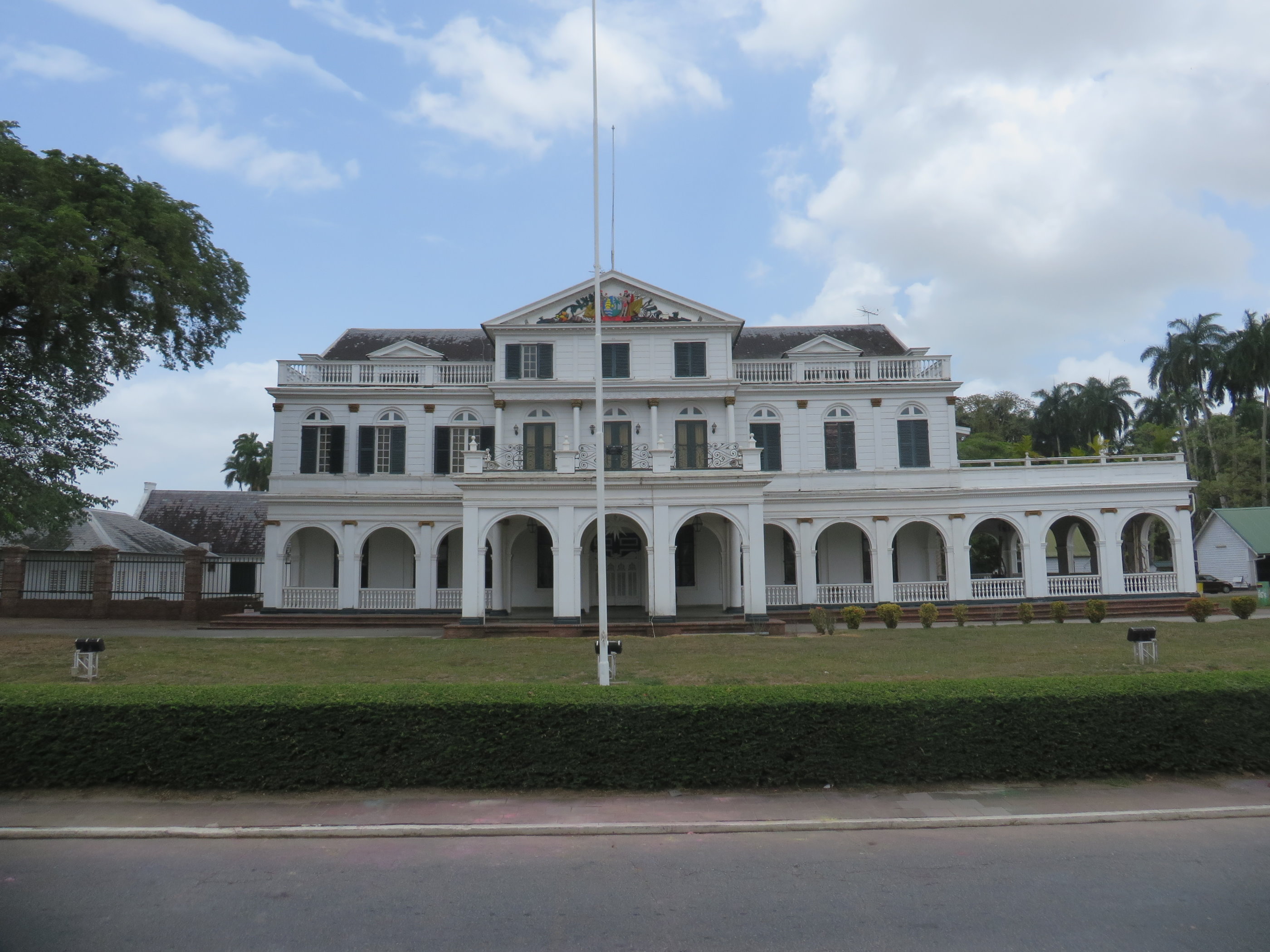
Day 68
23 March 2019
New Amsterdam was a fort that protected the mouth of two rivers that flow into the Caribbean Sea together. There is not too much left of it. However, there are cannons of various categories and size standing around and lying around, some put in place for tourists, some in front yards of apparently private houses, some on empty plots, some in the open air museum. The latter also comprises the former prison. Again, cells of solitary confinement, but not in such a large number as in French Guyana. But here, things are even more realistic, as the cells have not been renovated, and there are still traced of the smell in the air that one must have been awful, due to the horrible hygienic conditions. The fort was given up in 1907, while the prison was in use until the 1960.
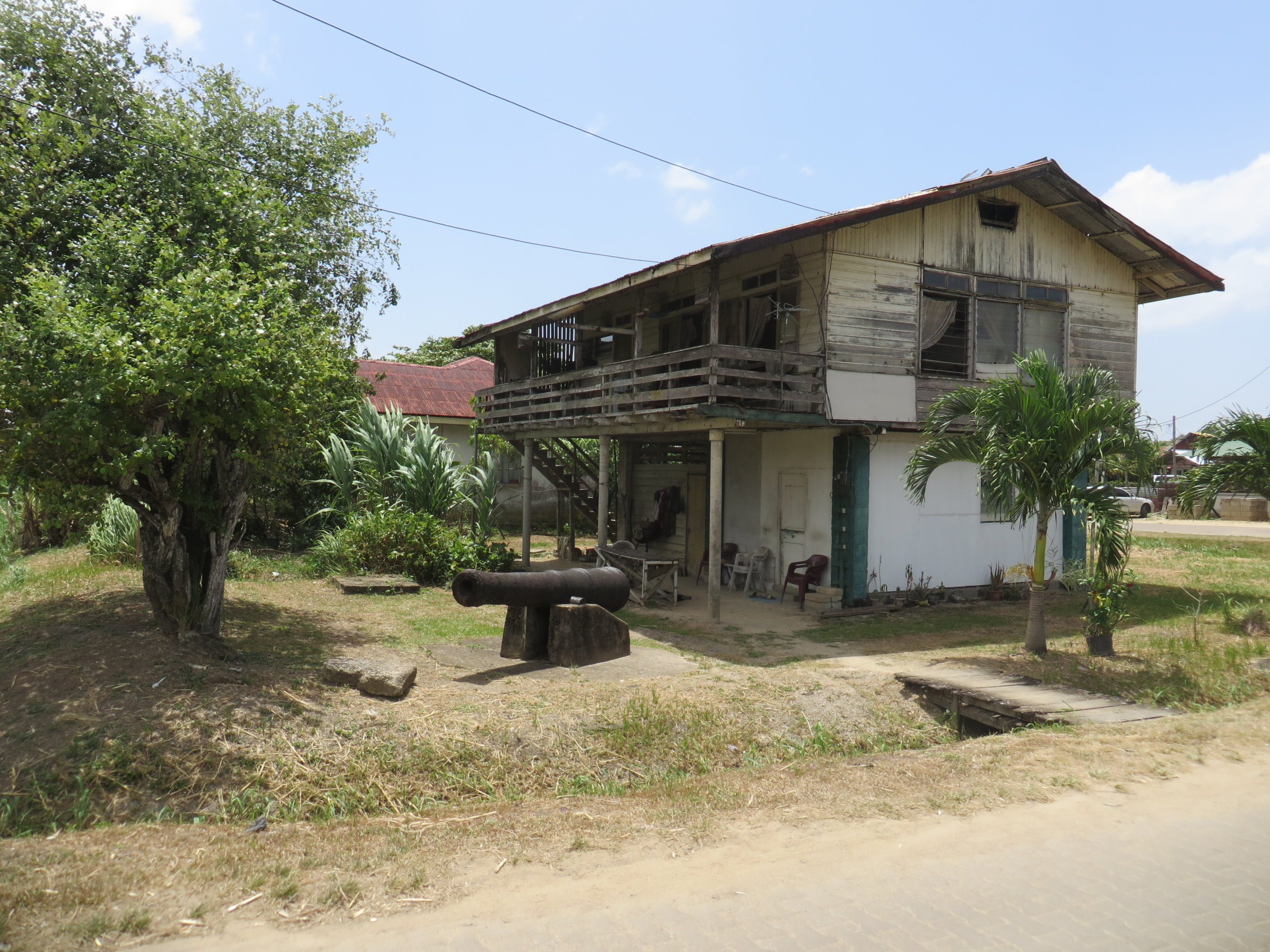
Day 67
22 March 2019
Jews were involved in the early post-Columbian history of northern South America, and this has to do with the 1492 edict of banning Jews from Spain, which was followed by likewise ruling only seven years later in Portugal. They first settled in a place they called Torarica, “Precious Bible”. They were then joined by English settlers, but there were many criminals among those, so that the Jews went to another place, which was then called Joden Savanne. There, the first synagogue of the Americas was erected. Today, only a ruin is left of it. There is a large, wooden and functioning synagogue in Paramaribo. The floor consists of sand like a beach. The building is adjoined by a quite a number of tombstones. As the head of the congregation explained to me, they had to be transferred from the former cemetery, which had to be closed for some reason. Typical for Sephardic graves, there are pictures on many of the tombstones; I found inscriptions in Portuguese, Spanish ‑ which actually might be Ladino ‑, Hebrew, and two in English. I met a German speaking member of the congregation, who spoke excellent German, as he had been educated by the Herrnhuter Chiristian missionary society. His family had been from the Spanish aristocracy, working for the crown. They were thus early informed about the 1492 edict and therefore moved to Amsterdam. Yet, they died in an epidemic, but their descendants survived and settled in Suriname in 1650. By chance, I also happened to meet Roy Lilienthal, descendant of the famous German flight pioneer Otto Lilienthal. Roy works as guard at the Paramaribo synagogue. I asked him if he was also flying, but he said no, “I stay on the ground.”

Day 66
21 March 2019
A large proportion of Suriname’s population is of Indian descent, and so, Phagwa, the Indian spring festival celebrated at full moon, is an official holiday in this country. Very soon, people threw colour powder at us. That powder is sold in plastic bottles, and throwing it at each other is the particular behaviour pattern of this feast. Not only the Indians, but also the other population groups join in. But their participation is not proportionate. Not too many Chinese, but a surprising large number of Whites are there to have fun. The music is Indian, relatively monotonous, and much too loud, as it is common practice in South America. Only a few people are dancing to it. There are many food stalls; the security guards are mounted on horseback and hide their face behind bandanas.
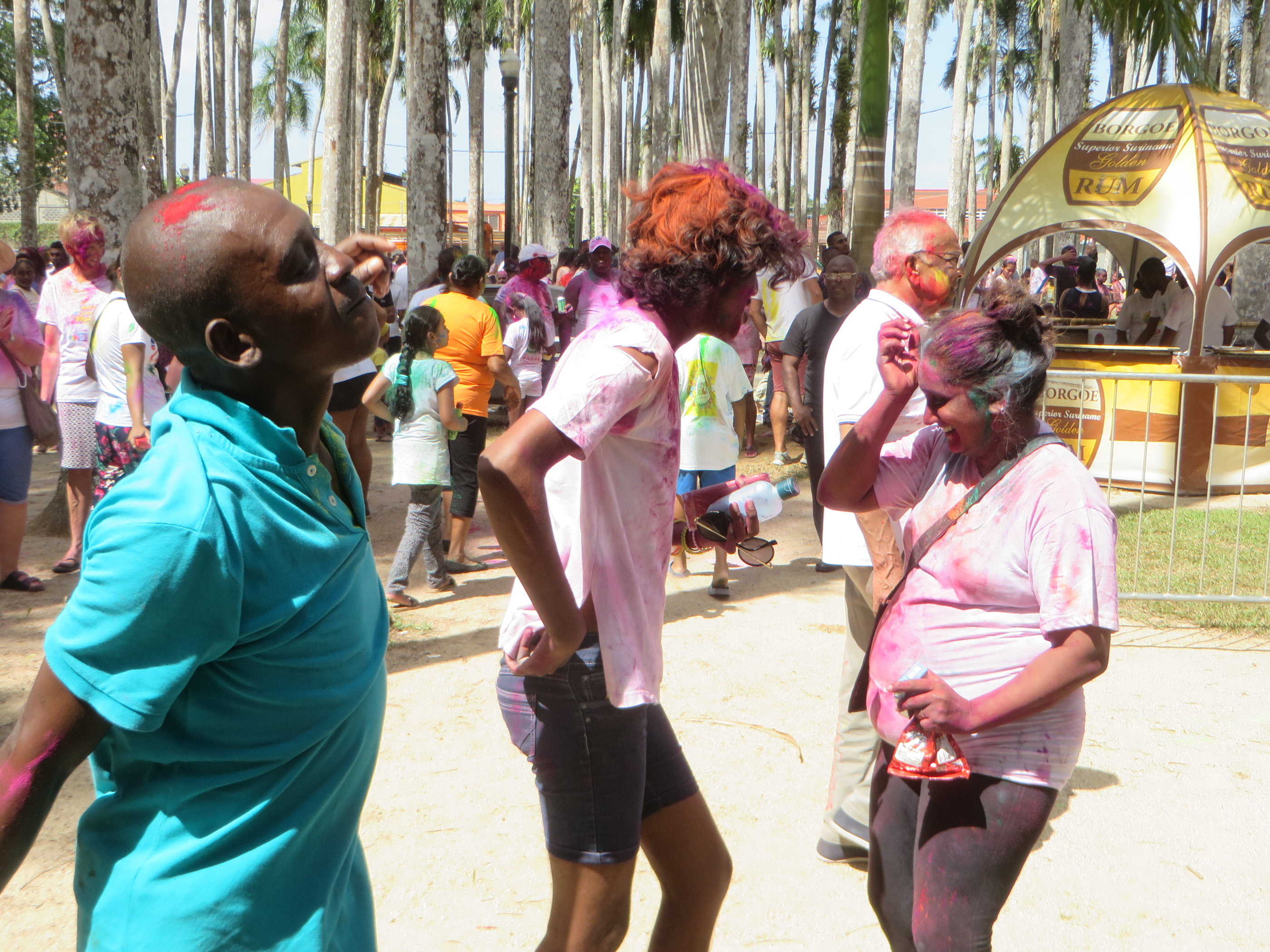
Day 65
20 March 2019
As things are very Dutch here in Suriname – we are back in Paramaribo -, we have rented Holland bikes. They have no other brakes but backpedal. One has to get accustomed to that as one also has to the left-hand drive. Yet, when the road is too small, then bicycling is nevertheless risky as cars pass you by only a hand’s width. We had a bike tour out of town, but when we wanted to cross the river near the harbour, the boatman first refused to take the bicycles aboard the taxi boat. We told him that yesterday, there was a guy who took his bike on board the taxi boat in which we crossed the other river, together with other people. But he did not give in; instead, he said if we payed 50 SRD, we could take both bikes with us (normal price is 2,50 per Person). We had no choice, so we accepted. From Meerzorg, we went on towards the Peperpot Nature Park, of which we passed the entrance and still went on until we came to the plantation with the abandoned factory. From the kind-of road, there is no plantation visible anymore, but we could still see some coffee and cacao plants, ragged and partly overgrown. We were told that only the factory had been given up, and that coffee and cacao was still produced further away from the road. Near the deteriorating buildings, there is an inn where we had some late lunch. By that time, spring tide set in, as full moon was expected for the next day, and the locks could not hold it and suddenly spilled over. The inn owner had a boat just beyond the lock, and he said it would be even worse at the next tide at night. We went back by bike and just made it through some submerged parts. The riverbanks were flooded, and from the water taxi back to Paramaribo, we came past the German shipwreck (cf. blog entry of 9 March 2019), which looked quite bizarre against the setting sun.
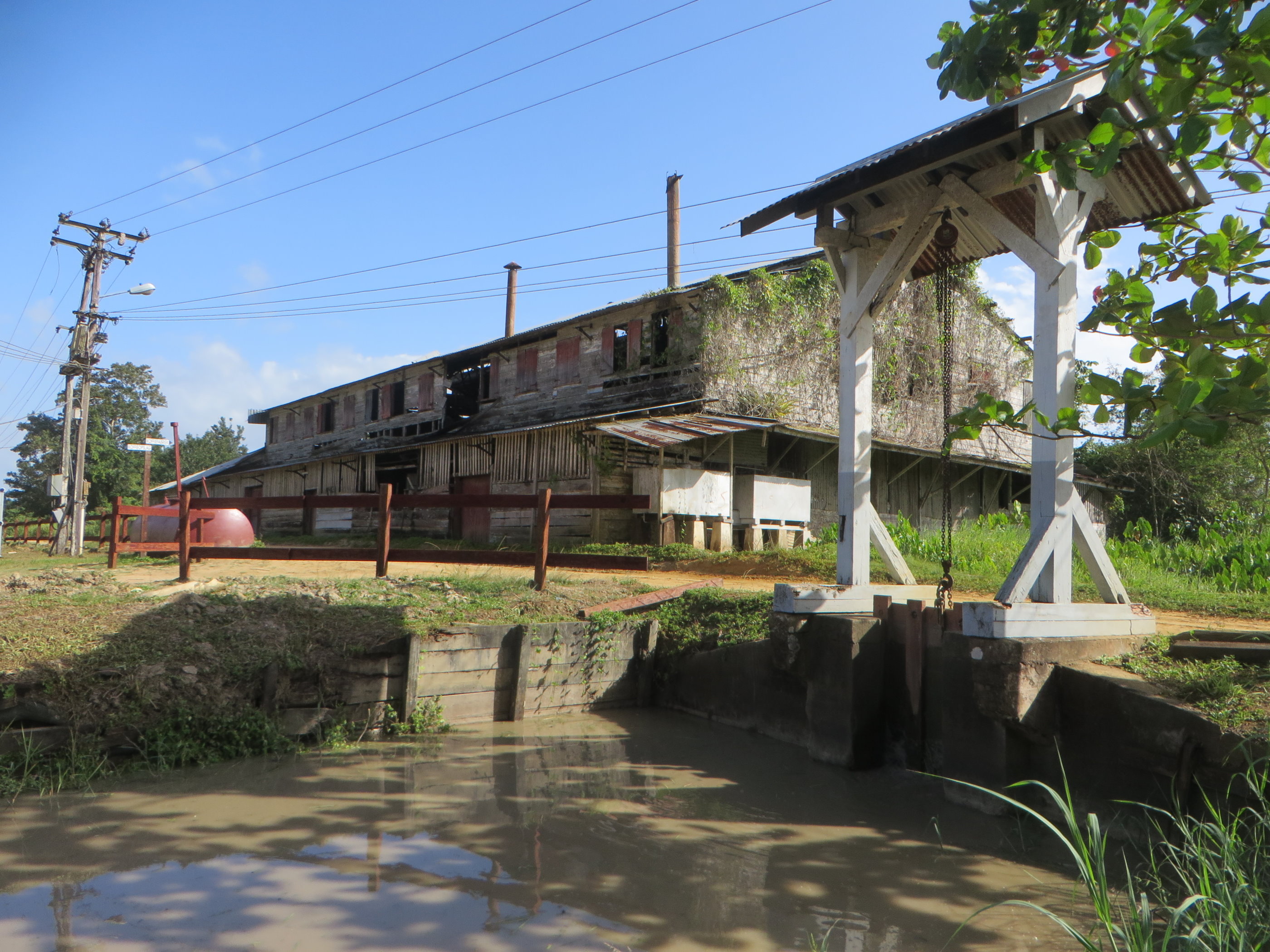
Day 64
19 March 2019
From 1852 to 1953, the French deported 70.000 convicts
to French Guyana. Their idea was to copy the British idea of colonising
Australia with criminals. However, it did not work with the French. The main
reason for this was the incredible brutality of the French system. St. Laurent
was the port where the prisoners arrived. For extra penalties, some were also
sent to the Îles du Salut (see blog entry of 11 March 2019). Those, who were
convicted to eight years or more, had to stay in French Guyana for the rest of
their life. Those, who were sentenced to less than eight years, had to stay the
same time again there after they were released. If they did not prove to have found
work and accommodation within two weeks of release, they were sentenced again
because of vagrancy. But no-one wanted to take them, neither for work, nor to give
them shelter. So, many of them were sent back into prison because of thefts and
other crimes. The prison, along with the external posts, were actually
concentration camps designed to kill people with work and inhumane conditions. In
fact, 60 % of the prisoners died. This often happened within the first
days. They had to work naked under the tropical sun. In those times, there was
no sun cream, so that they died from burned skin. Also, when they came out of
solitary confinement after months in the dark, exposure to the sun could be a death
sentence. The carts on the tracks had to be pushed daily for 15 k by prisoners
with bare feet. They were fed with water and bread, sometimes with some
additional food. Their feet were chained day and night. Those, who were not in
solitary confinement, were stuffed into overcrowded mass cells, where they had
to lie on the stone floor, with just a bevel instead of pillows. For punishment,
they had to lie there permanently for days or weeks, having to defaecate and
urinate under themselves, with the other prisoners lying tightly next to them. In
the solitary cells, there were wooden beds with wooden pillows (which were wood
pieces with triangular profile). The walls were blackened with tar, and they
were not allowed to lean against or otherwise touch them. If they did, which
could be seen from the black stains, this was a reason for extra punishment.
Scratching the wall or the floor – extra punishment for damaging it. Before the
executions, those sentenced to it had to spend three months of solitary
confinement. Before being beheaded with the guillotine in the jail’s court, so
that the other prisoners could witness it, they had to sign their death penalty
themselves. In one of the death cells, there is “ADIEU MAMAN” scratched into
the floor, and in solitary cell no. 27, we found “Papillon” twice. He was one
of only 16, who managed to escape. Less than 2000 made it back to France. The
Salvation Army paid their tickets.
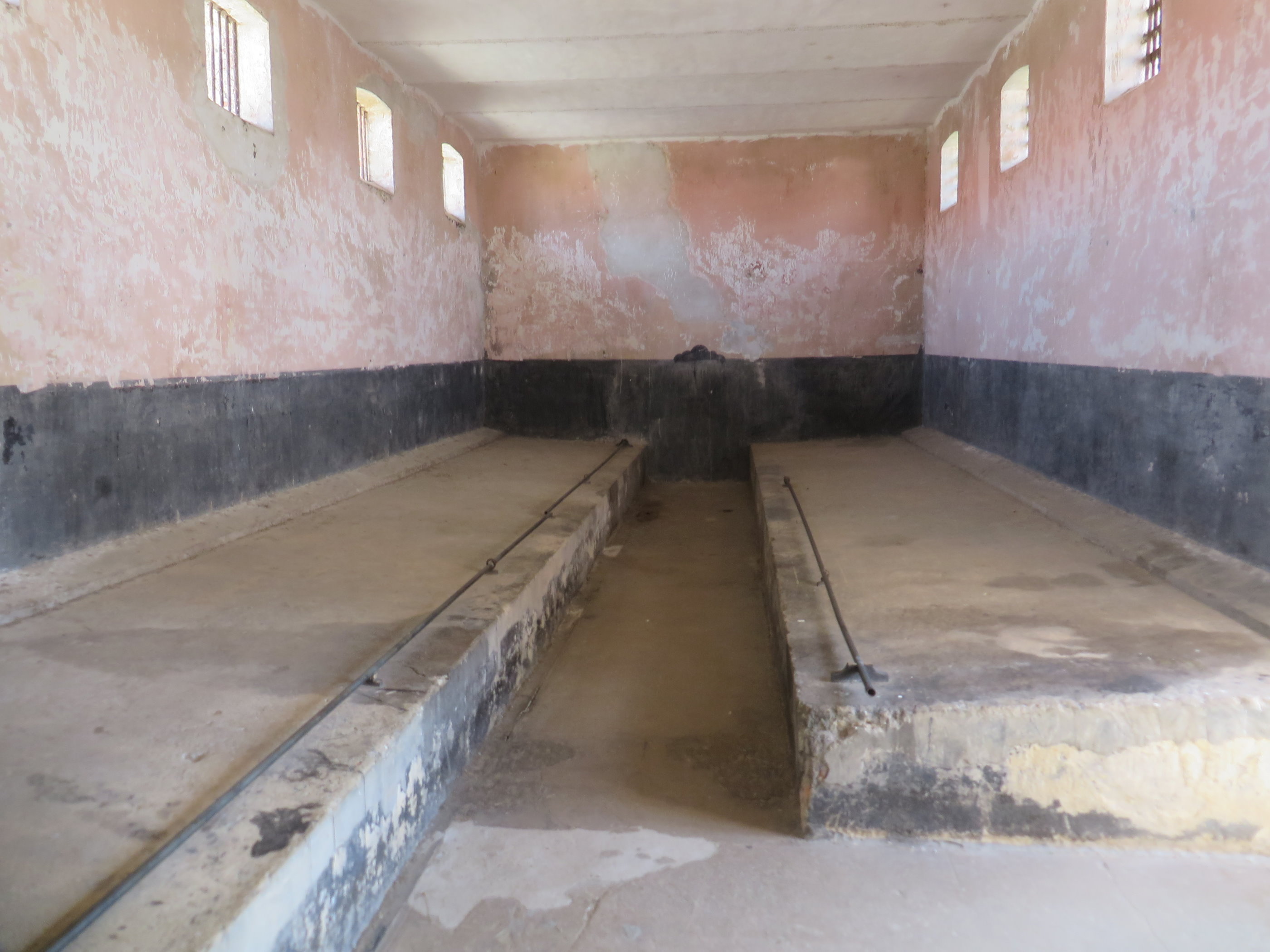
Day 63
18 March 2019
There is an area of primary rainforest between
Roura and Kaw, relatively easily accessible because a road runs through it. Since
we still had the option to use the car, we took the opportunity to go there. However,
Google maps is not correct – the road ends at the river, and Kaw is on the
other side. We went into forest trails twice, first just before the river; then
we turned and, on the way back, we took a trail that is labelled Botanique, as along it, a number of
plants are signposted with names and further explications. Earlier, we had
stopped on the road, because we saw a man in a strange position on the lawn
shoulder. It turned out that he had found a giant bird spider, which was sitting
there with its front legs lifted up, in defence position. The man had a stick
with which he eventually shoved the spider towards the bushes. Perhaps he was
something like a ranger, as he was wearing boots and warned us of snakes.
Therefore, we took extra care when walking through the jungle. Such places are
awe-inspiring, anyway. You can witness the cycles of life, trees that have
fallen and are overgrown instantly by others. Tropical primary rainforests are
the regions with the highest density of species on Earth.
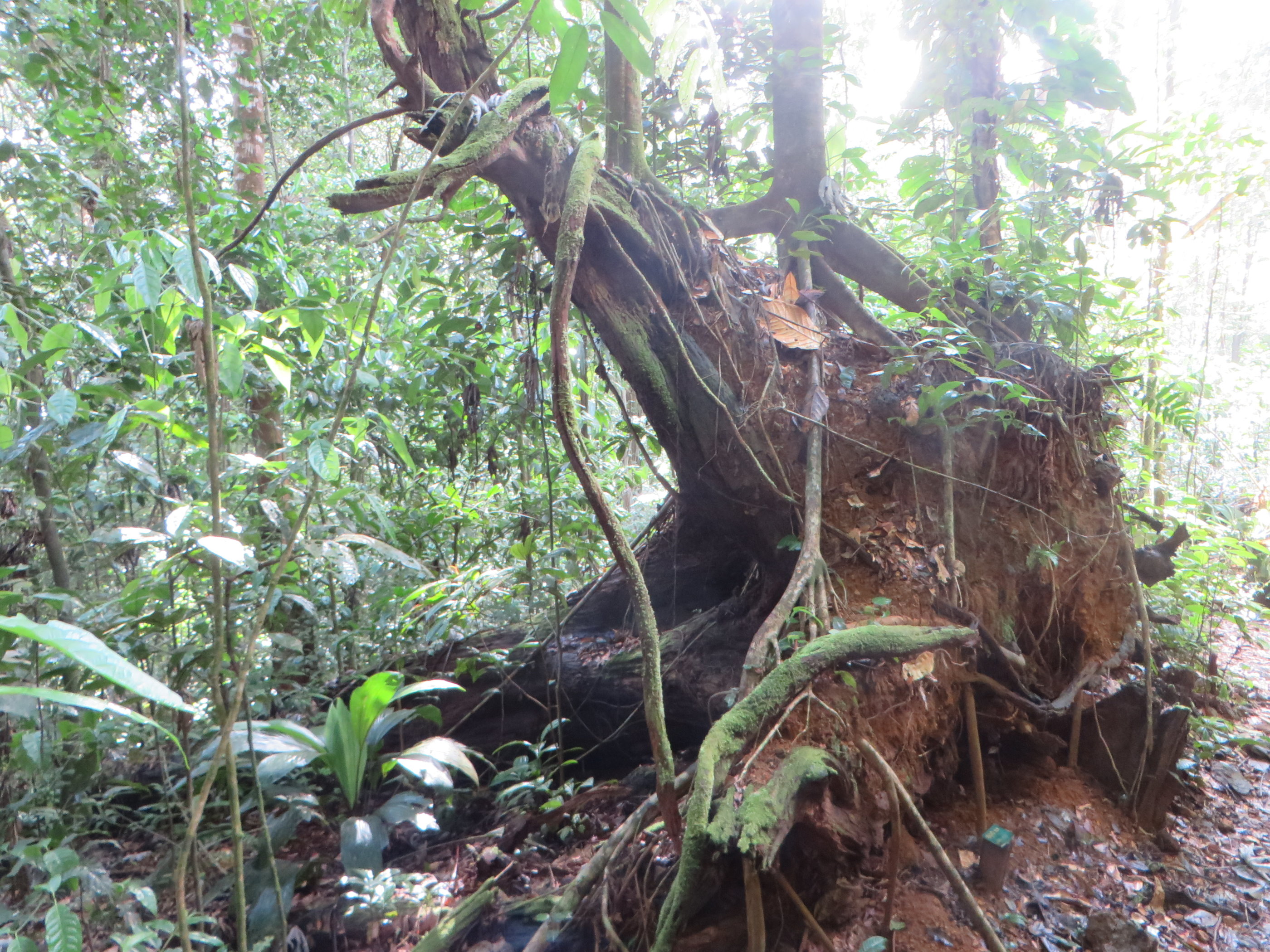
Day 62
17 March 2019
It turned out that the place where we took accommodation is a sort-of hippie place. The owner is a friendly Frenchman, and according to his age, he might still have been part of the original flower-power movement. Due to drunken driving, he is without license for three months. So, he left us his car for much less than we would have paid at the car rental. We took the chance to go to a place called Cacao. It is one of several settlements of Hmong people from Laos. They had fled from the Vietnamese to Thailand, and 500 of them were transferred to French Guyana in 1977. Today, there are 2000 Hmong in French Guyana, and they produce a considerable proportion of vegetables and other agricultural products for this region. On Sundays, there is a market in Cacao, where the Hmong not only sell fruits and vegetables, but also specialties of the South East Asian cuisine.
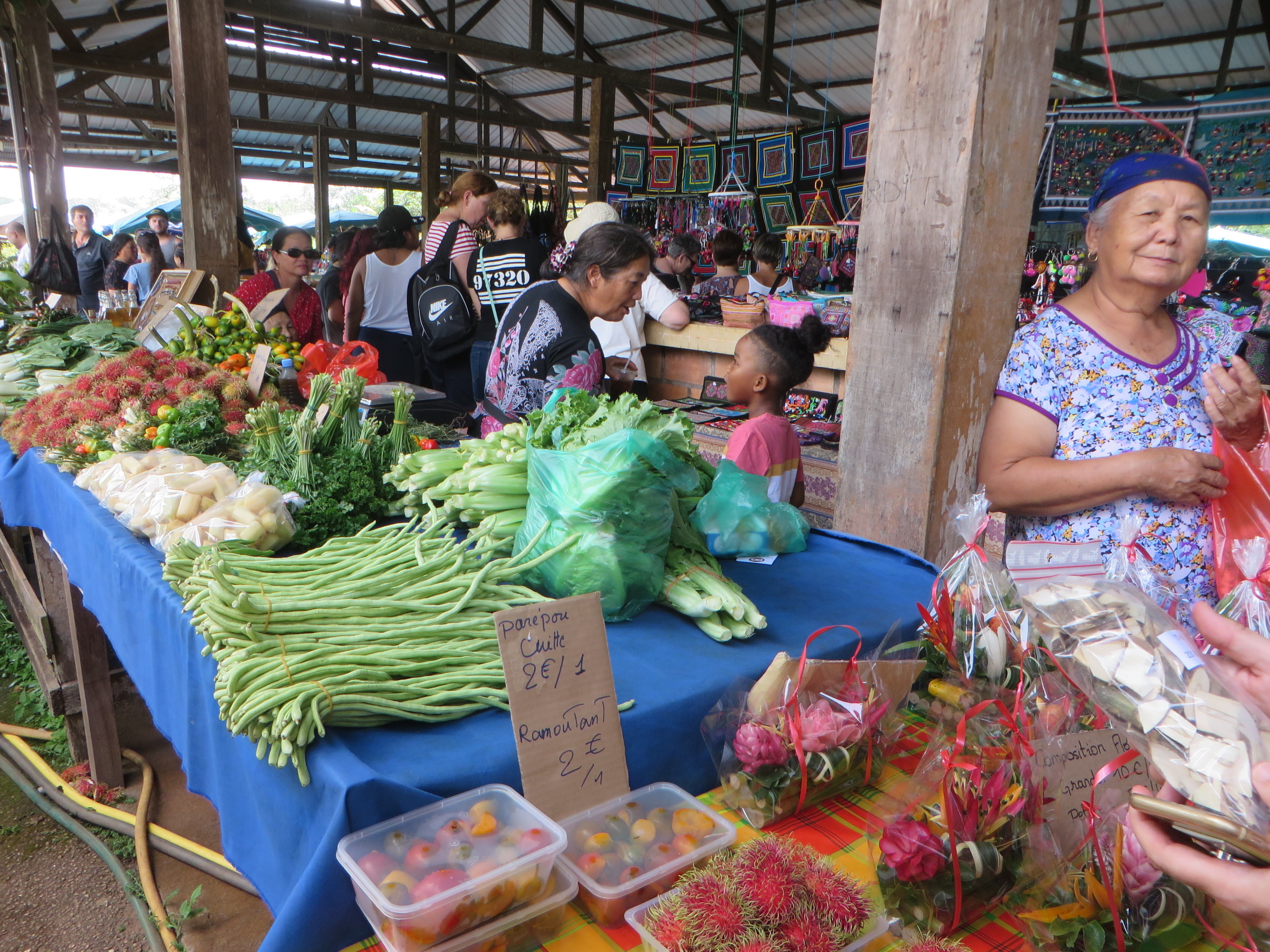
Day 61
16 March 2019
In the early morning, we took the boat downstream from Vila Brasil. This river trip was one of the most impressive we ever had. The fog was still hanging over the forest. Along with the reflections of the water in all its shapes of currents and rapids, and with the various figures of rocks, this provided a rather solemn atmosphere. We reached Saut Maripa relatively soon, as we were going with the stream. After changing boats, we stayed in Oiapoque for lunch, which was really worth it, before crossing over to St. Georges and continuing to Rémire.
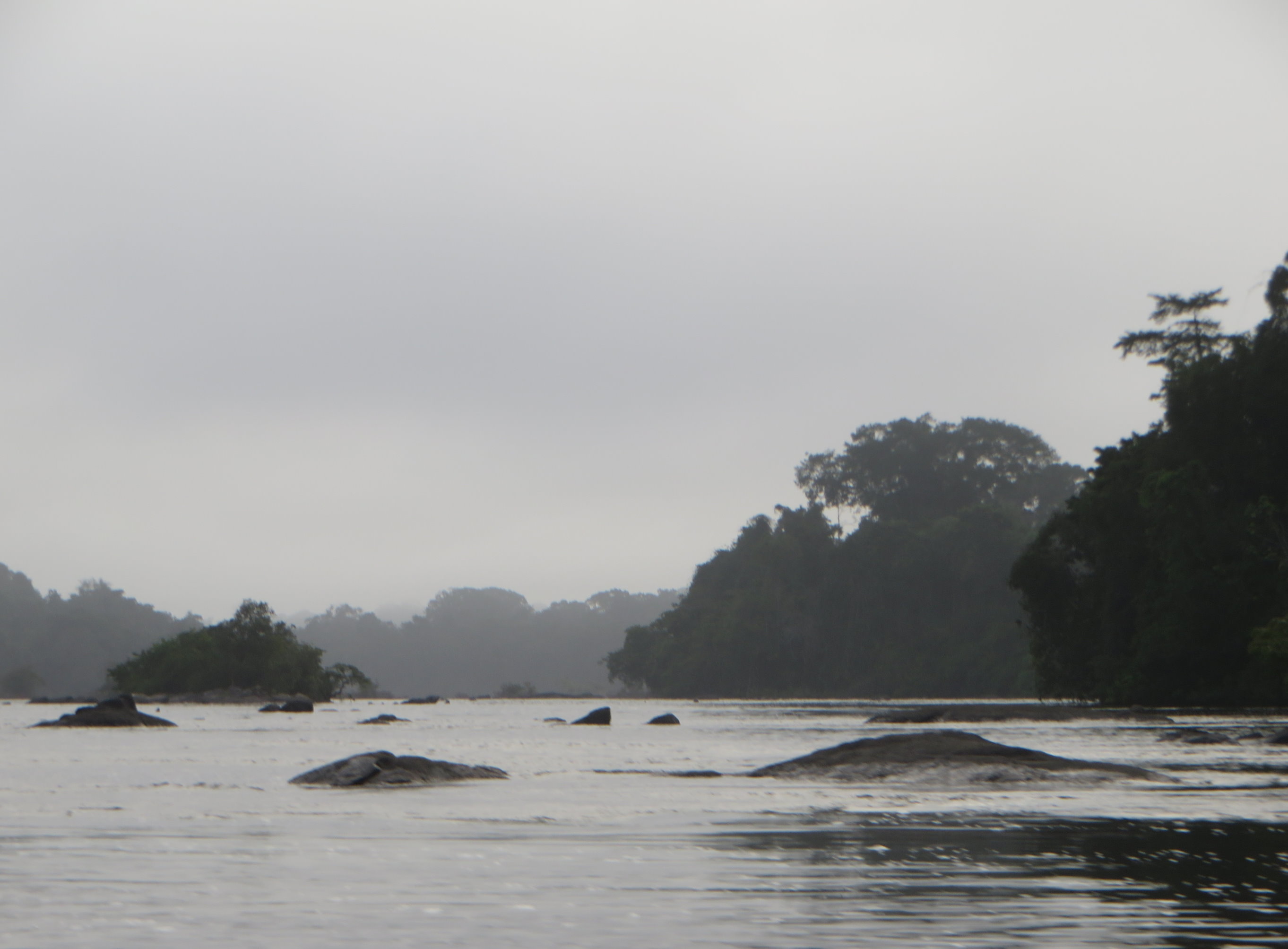
Day 60
15 March 2019
There are two indigenous peoples in the Camopi area, the Teko and the Wayampi. The Teko chief, who also presently is the local chef coutumier of the indigenous peoples, was not there, because he attended a meeting with other indigenous representatives for some days. The Wayampi chief had died last year, but until the proclamation of a new chief, there is an intermediate chief. We went to the Camopi school to meet him there. Already yesterday, a French lady, who is married to a Teko man and who is teacher at the school, had not only recommended him, but she had also told us that there was an immense loss of culture taking place. Three years ago, all of the indigenous girls had come to school with just a loincloth, and now, they all wore modern tops. I asked her, how do the teachers present themselves, as they are the role models? She quickly said there were other influences, too. When I spoke to the head of the school, another French lady, she also deplored that they had a massive problem with the loss of culture, and she welcomed that we offered to give a workshop on the UN Indigenous Rights. She introduced us to the intermediate Wayampi chief, as well as to another Wayampi man. Both had a loincloth along with a shirt. The other Wayampi man took us to a place nearby, where two women were making cachiri preparations (a local, slightly alcoholic brew is passed around in a bowl), and I briefly showed him the Tourinfo presentation on our little tablet, in which also the Indigenous Rights are explained. One of the articles I pointed out was no. 14 on indigenous peoples’ right to their own culturally specific educational system. He said that until some time ago, he had worn nothing but a loincloth, and that he felt uncomfortable and sweaty now with the shirt. I asked him why he was wearing it then, and he said that he was accustomed to it during his education. Later, we met the Wayampi intermediate chief in his village next to Camopi, where he arranged the Tourinfo presentation to take place, as well as some data collection to be done for the sound study and two questionnaires. His wife and kids were also there, and he gave a short statement for a Survival International video clip. Both indigenous peoples of the Camopi region are presently subject to the deletion of their culture. They are considered French and thus EU citizens. This attracts many indigenous families and individuals from Brazil, who pretend to be from the French side. People receive social welfare. This money is spent at the Brazilian side, where booze is cheap. Already in the morning, the indigenous are drinking, and they carry on with this into the night. There seems to be no solution at hand for this problem, as denying them social welfare would collide with French and European equality principles. At the same time, what happens here is a clear infringement of Article 8.2a. However, another infringement of that article could easily be prevented. Deploring the loss of indigenous culture while at the same time being responsible for the identity-changing influence is irrational. At school and elsewhere, the French would just have to adapt to the traditional indigenous style, then the indigenous would not adopt the modern outfit, but would rather be strengthened in their identity. People talk about equality – if they would really mean it, they would integrate into the indigenous culture, just as indigenous people integrate into global culture when they go to French cities and similar places. Already when we were approaching Camopi yesterday, we found a semiotic border just a few kilometres before the town. Indigenous women now have a hard time inside that area, as they try to proudly keep up their tradition and identity. They maintain to go topless, but they are losing ground. I feel so sorry for them, it is bitter to see how they struggle, and the ignorance of the others. Society is hierarchically split into three levels now:
– On the top, there are the globalised, in this case mostly French; they just don’t care about the fact that they destroy indigenous culture by not adapting to it; by trying to educate them to be French; and by financing their alcoholism.
– Between the globalised and the traditional indigenous, there are persons with indigenous background, who try to upgrade themselves by giving in to globalisation; they have switched sides and believe in modernity, communicating their new identity by implementing the breast taboo with fashionable tops and other trendy wear.
– And there are the remaining traditional indigenous, who are at the bottom of this stratification, even though they are the original inhabitants of the land; although they were fully naked before the arrival of the whites, they at least retain toplessness, the disappearance of which is the symptom of the deletion of indigenous identity and culture.
“O brave new world that has such people in it.”
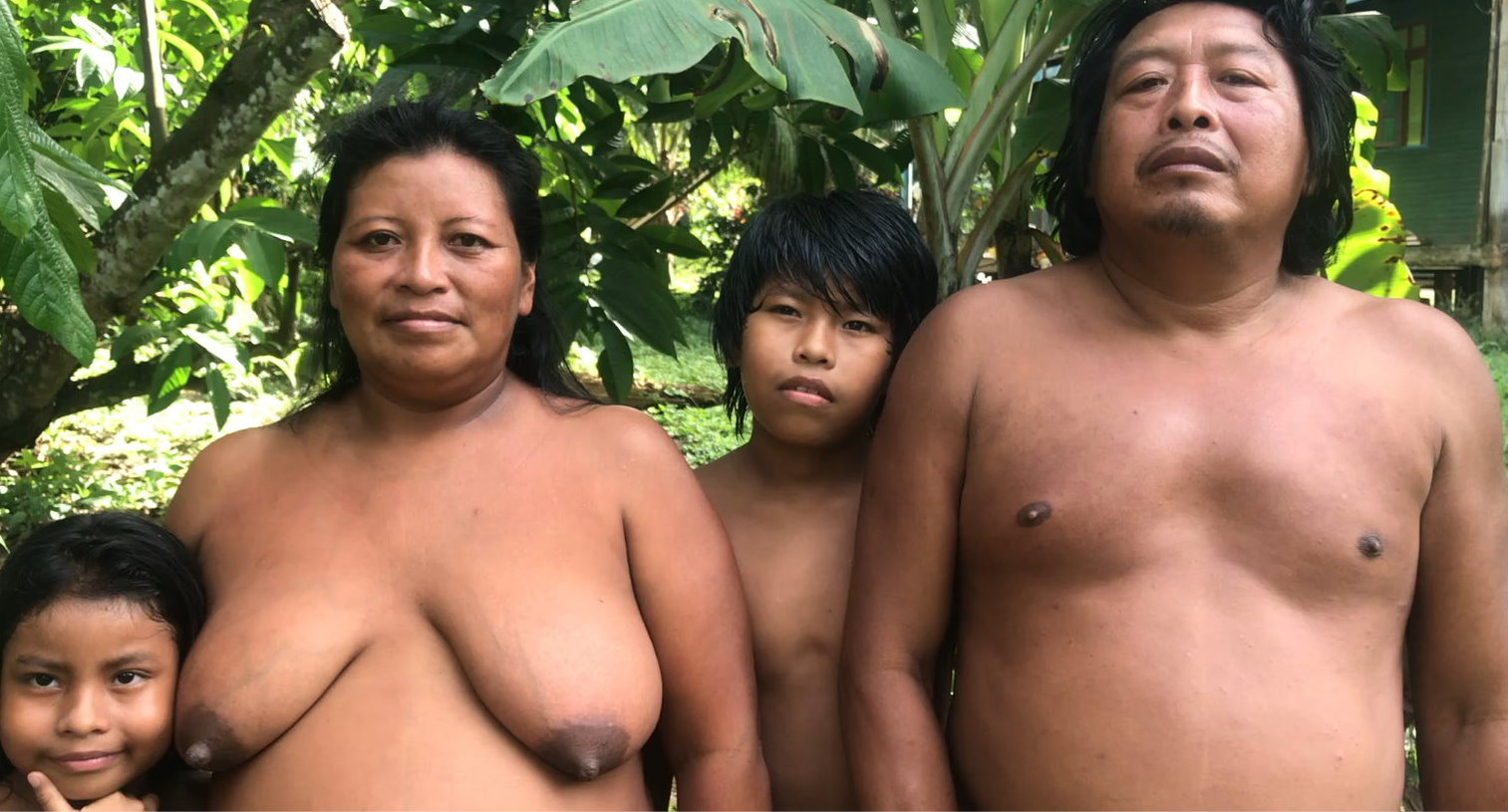
Day 59
14 March 2019
In the early morning rain, we went to the police station to have our passports stamped. At the pier, we had to wait until the small, open boat was loaded. It actually was overloaded – with fuel, water, beer, toilet paper and food. Additionally, we, together with ten others, went on board, where we barely found a place to sit. After about 20 minutes, we reached the rapids, Saut Maripa, where we had to change boats. The freight was carried across the rocks by porters, which took some time. Then, we had another four hours upstream, through many other rapids, which are somewhat navigable. It was a hard ride, though. You get wet to the skin when the water splashes in as the boat struggles against the torrents. We finally reached Vila Brasil, which can hardly be called a village. Rather, it is a settlement, consisting of just a few simple buildings along the riverside.
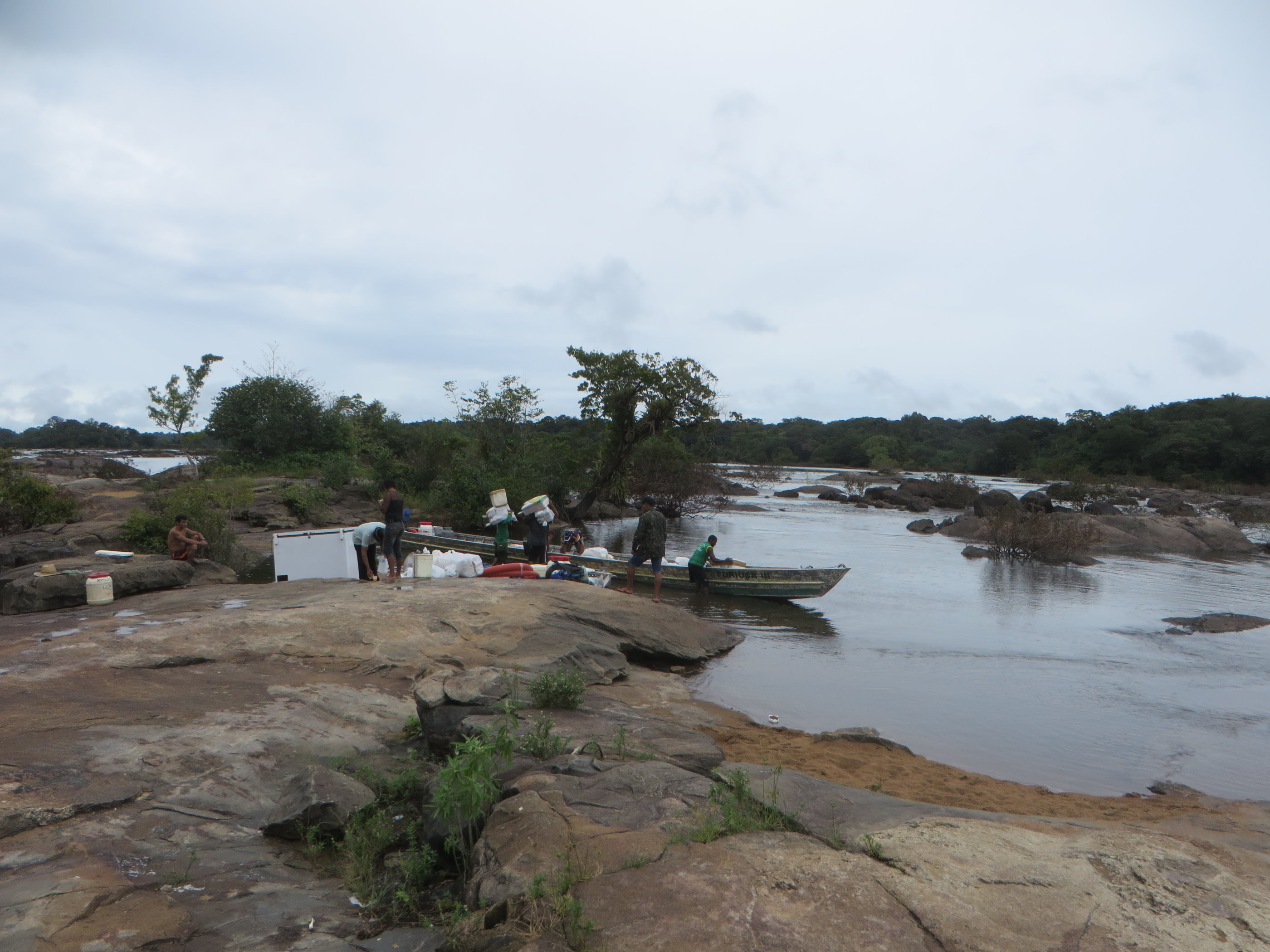
Day 58
13 March 2019
In search of the original Cayenne pepper, we went to
the Cayenne market, where we actually found some. We also went to the botanical
garden; there is a field of steles commemorating the 1848 liberation of 13000
slaves in French Guyana. Then, we took a collective taxi to St. Georges. Our
idea was to stay there overnight and then to take a boat upstream to Camopi.
St. Georges turned out to be a dullsville – ugly, dirty, overpriced. One hotel
was fully booked, and there was no-one around at the other. I went to the local
presbytery to inquire about indigenous peoples and about the onward travel. A
kind man brought me to the person in charge, who informed me that his boat
would not go to Camopi the next day. I then spoke to the boys who were hanging
around at the riverside. They gave me some good information, so that we then
decided to take a water-taxi across the river. Back in Brazil again! Compared
to St. Georges, Oiapoque is a nice town. Right the next hotel at the waterfront
is clean, good, friendly and reasonably priced. Likewise well-priced are the
many restaurants of the town. We found an appealing one, where we had a
delicious dinner. The relation between French Guyana and Brazil is somewhat
odd. The building of the bridge across the river, which in French is spelled
Oyapock, was finished in 2011. But it was not opened until 2017. Yet, that was
only an official act. In fact, the bridge is not in use. On the Brazilian side,
the last stretch of road is still missing, so that it is not really connected
to the infrastructure.
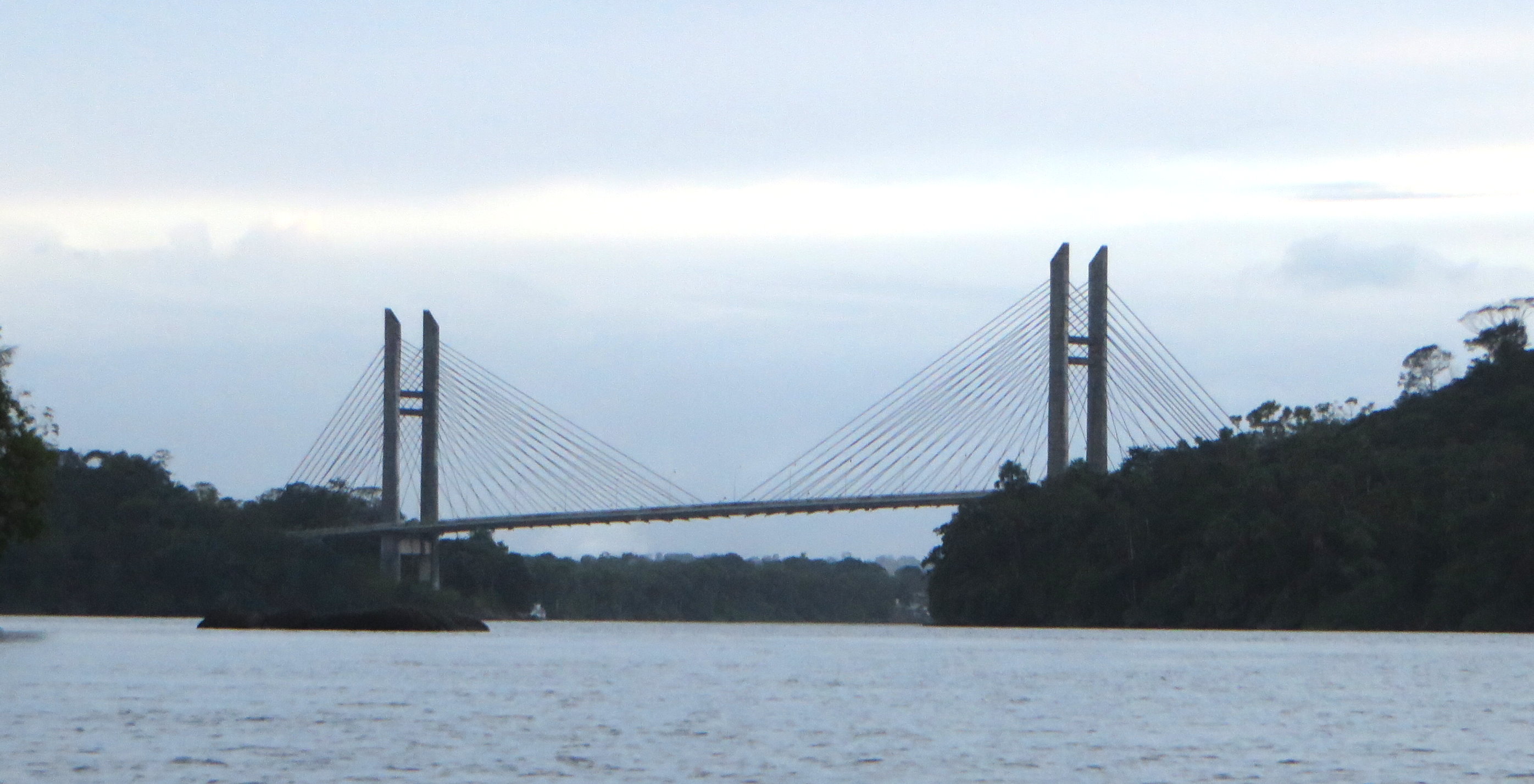
Day 57
12 March 2019
As we were in Kourou, we wanted to see the launching site of the space centre. A Vega launching had been scheduled for the 14th, and we wanted to register for being allowed to a special place to watch it, but then, the launching was postponed for one week. To visit the base itself, one has to register at least 48 hours in advance. But we had met someone, who works for the Ariane programme, who told us that we can get until the last gate, from where we can take a look until one of the launching sites. So, we went there. We could see the three towers and the building, which can also be seen on the pictures of launchings. Furthermore, there was an old stage of a rocket lying near that barrier. A local lady told us that some people suffer from respiratory problems for about one week after a launch. She said it smells much stronger that aircraft exhaust, and the windows were rattling when a rocket was launched. There is also a space museum, but I was missing any mentioning of the early Chinese rockets and those of Hermannstadt (Transylvania, now Rumania), as well as any perspectives critical of the Juri Gagarin mission.
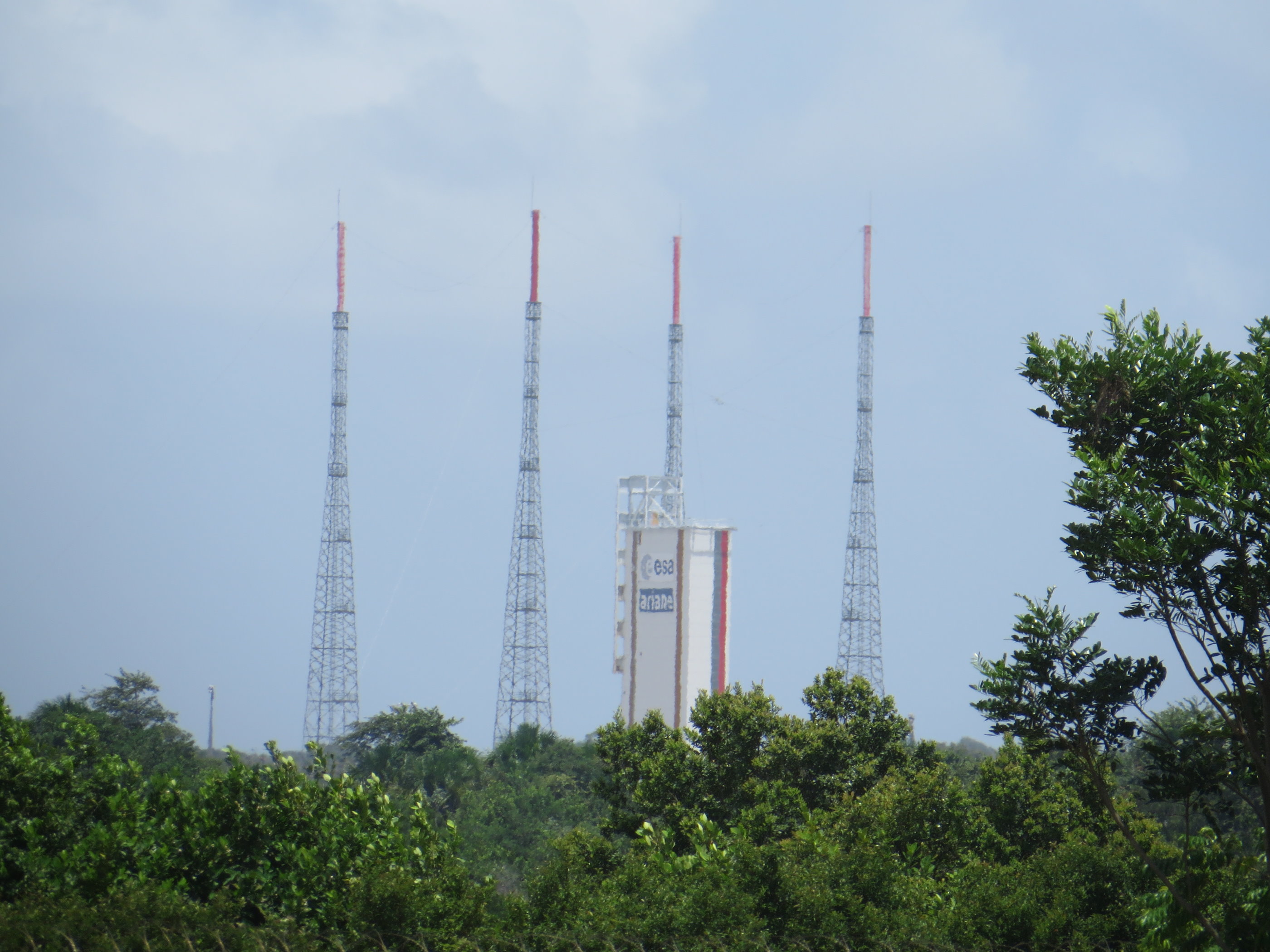
Day 56
11 March 2019
France maintained three prison islands about 15 k off the coast of French Guyana. We went to visit the largest of these islands, Île Royale. It must have sounded very cynical to the prisoners that these three islands are called Îles du Salut. They were named so because the survivors of an expedition waited to be picked up and brought back to France on these islands. Previously, there had been indigenous population there. After France decided to use the islands for keeping prisoners, people were sent there even for what is considered today as only minor trespassing, such as forging paintings. The probably most famous prisoner was Alfred Dreyfus. The prisons were given up in 1951. Now, some of the houses have collapsed and are overgrown by the jungle. A few prison cells are still intact. Especially the isolation block is not a nice place to be. Outside, nature is wonderful. The palm trees convey south sea feelings. There are monkeys, and in the bay next to the jetty, one can see sea turtles taking breath every few minutes.
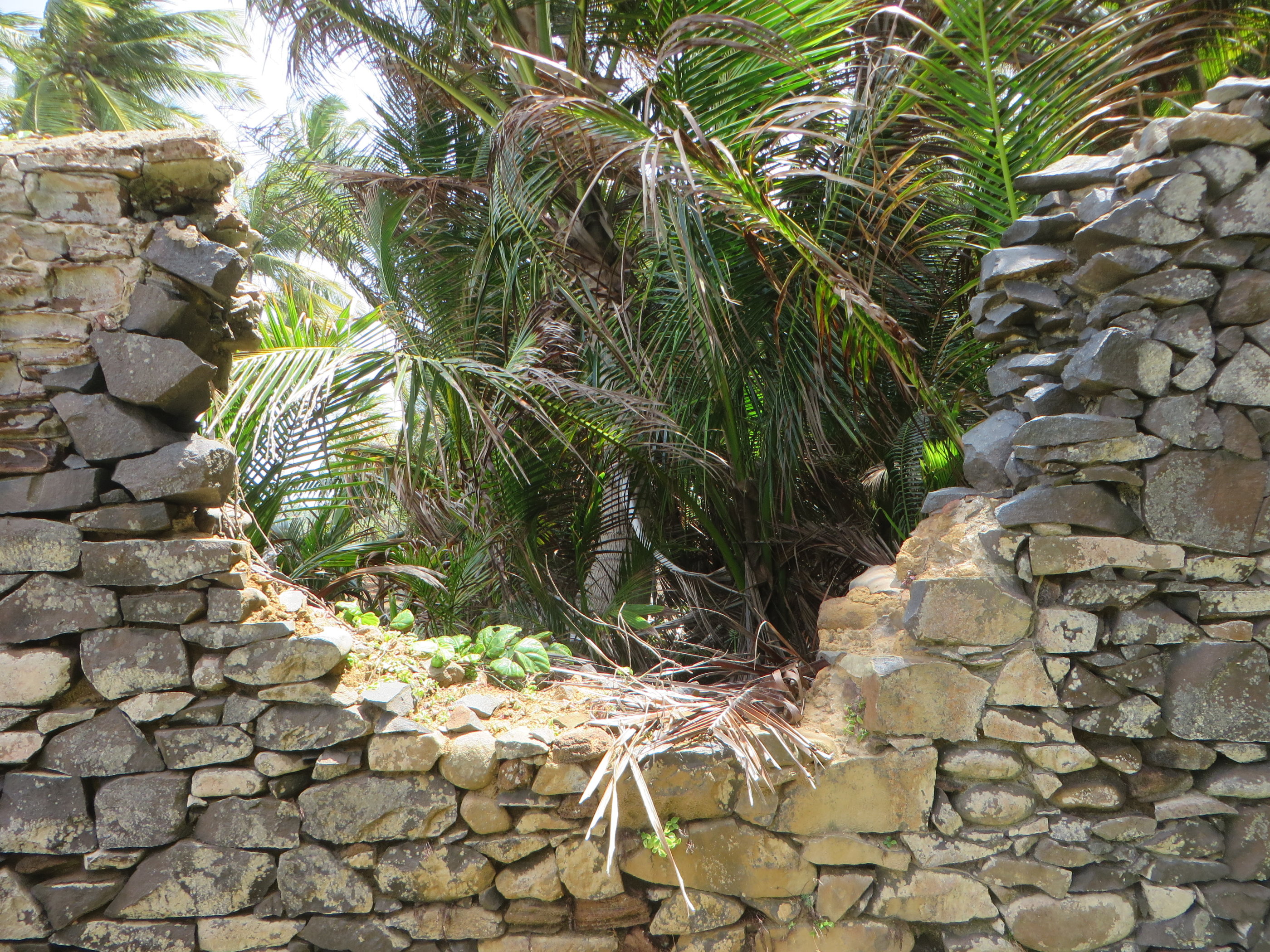
Day 55
10 March 2019
Similar to the way from former British Guyana to Suriname, we again had to cross a river, which is a border, in order to get to French Guyana. France has not given up several of its colonies, but rather given them the status of overseas departments. As EU citizens, we did not have to go through any formalities to enter the country. We do not even need a passport, an ID card is enough. Currency is the Euro, and we can use our German simcards. Due to the roaming policy, we can call home without extra costs. Interestingly, many European pine trees have been planted in French Guyana. Some of them are squatted by epiphytes, a strange sight not bare of some metaphorical content. While much of the infrastructure reminds of France, there are nevertheless many spots that remind us that we are in South America.
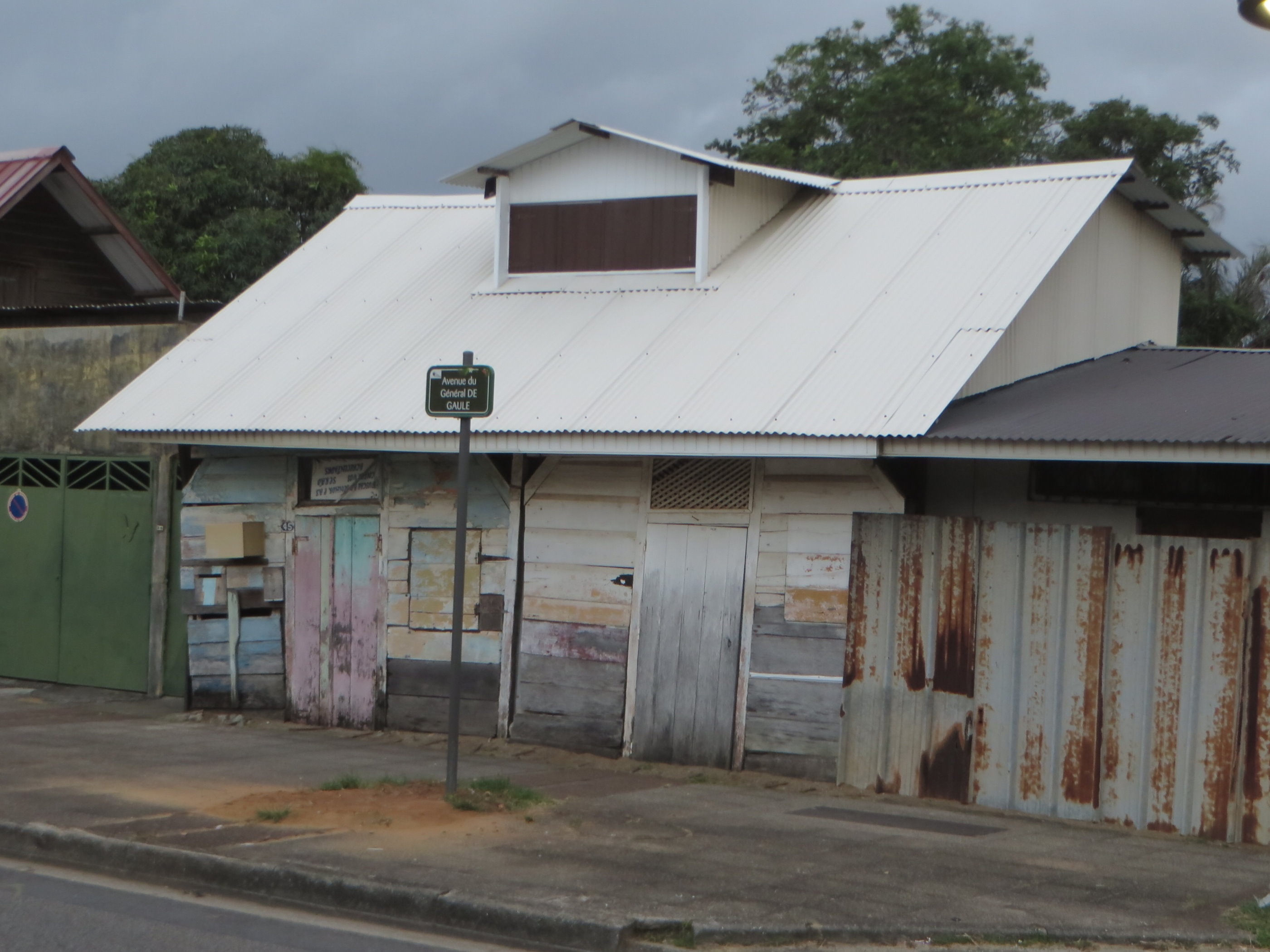
Day 54
9 March 2019
Apart from the climate, one could have the impression of being in the Netherlands at first sight in Paramaribo. The architecture is very Dutch, and so is the official language. Besides this, there are quite a number of further languages spoken in Suriname. These are several indigenous languages, as well as those of various Asian communities and creole tongues. When former Dutch Guyana became independent, it preserved left-hand driving, as it had been practice in Holland (and also Sweden) until they adapted to the rest of continental Europe’s right-hand driving. In the harbour, there is still a German shipwreck of 1940. The captain was married to a local lady, and he was friends with the governor. When the latter had to formally arrest the former due to the war situation, the captain sunk the ship at a position that more or less blocked the entry to the port. Only later, the river changed its bed, so that other ships now go past the wreck. We met with an indigenous representative for some interesting exchange that day.
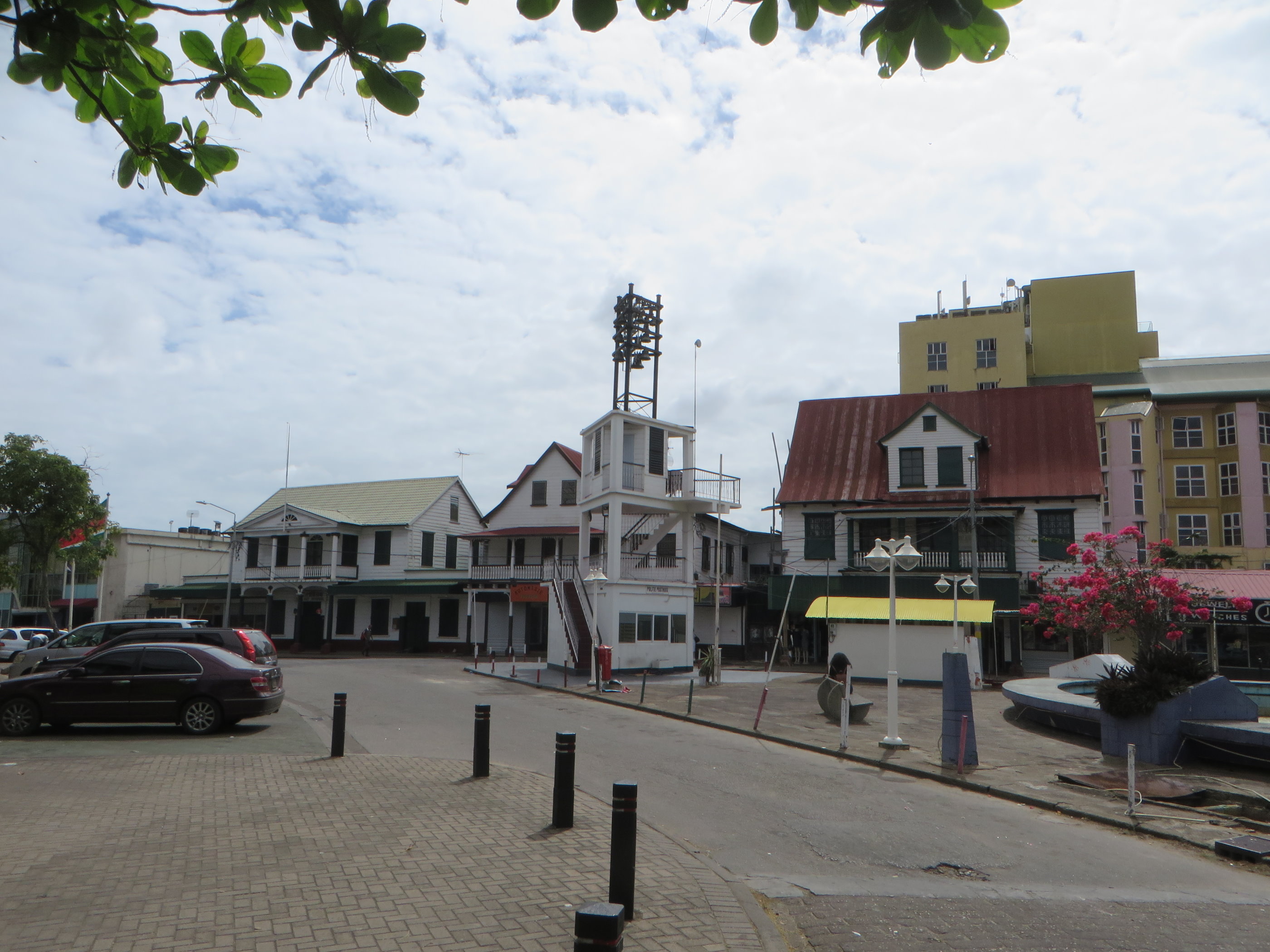
Day 53
8 March 2019
We had to get up a 4 a.m., to be picked up at
4:30 by a car that brought us to Guyana’s border with Suriname, which is a
river, and one has to take a ferry to cross over. We arrived at the ferry port
at 8 a.m., and after the formalities, we still had to wait until the ferry left
at 11 a.m. With better organisation, one would not have to get up that early.
Although we had been promised a car, we were then put on an old bus, because allegedly,
there were not enough cars. The truth was that even that old bus was broken. It
could only go about 20 k. Finally, somewhere along the way, another bus picked us
up, and we did not arrive Paramaribo in the afternoon, as expected, but rather
in the evening. The countryside we saw reminded very much of Holland.
Apparently, the colonists had adapted the country to what they were used to.
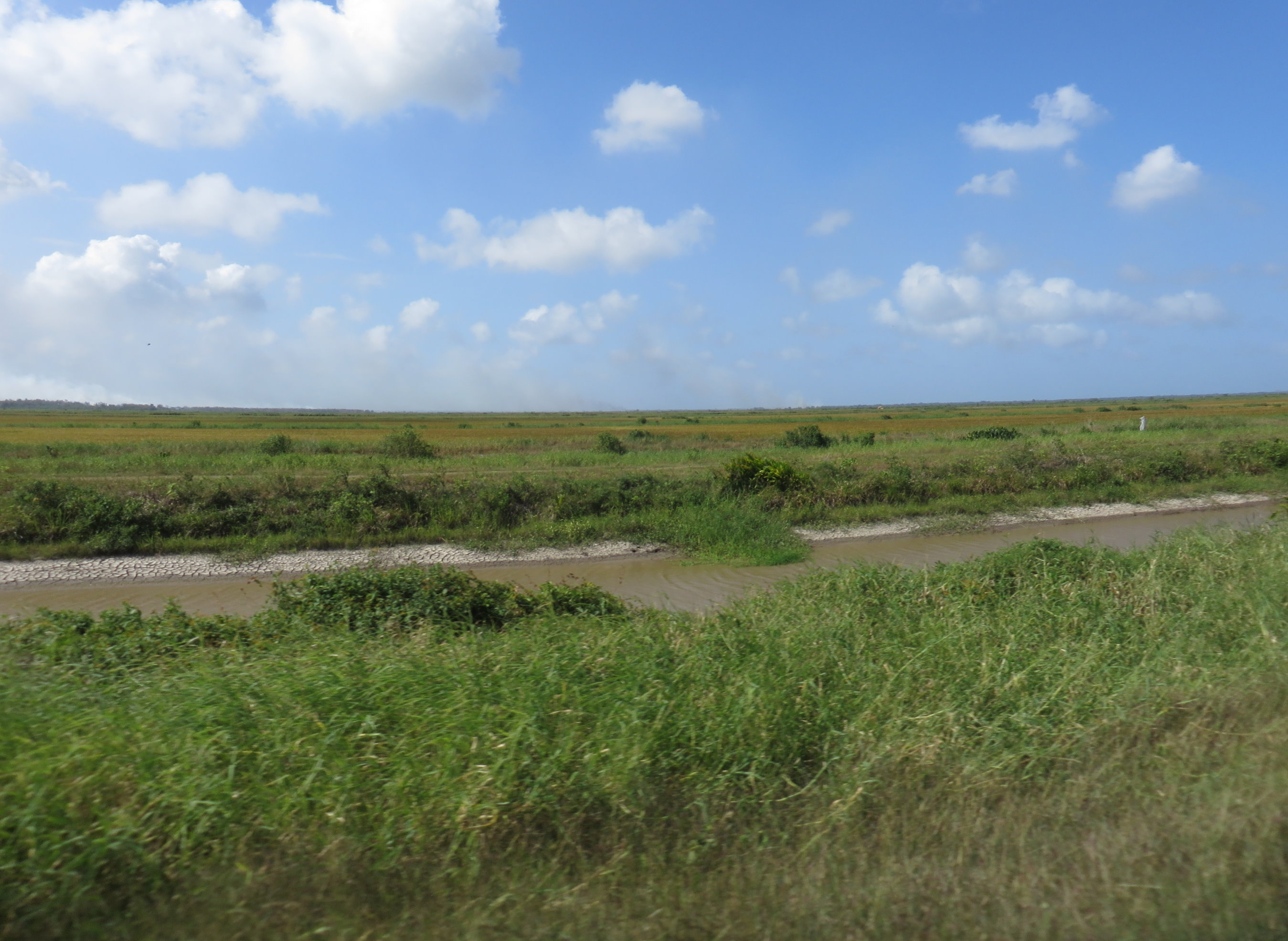
Day 52
7 March 2019
This day was a positive surprise, full of nice
impressions. We saw the Kaieteur, which is a word from the Patamona language.
Kaie was a Patamona chief, and teur means “falls” in Patamona. So, Kaieteur are
“Kaie’s Falls”. This waterfall is said to have the world’s largest single drop,
228 metres, “nearly five times the height of Niagara”, as it says in one of the
guidebooks. Already on the way, we saw manatees, or sea cows. Our local driver
showed us to the pond, where he threw some freshly torn grass into the water.
And soon they came, one after the other, until there were at least eight of
them. As the water was muddy, we could only see of them what stuck out. They
have tiny eyes, an almost half-moon shaped, horizontal tailfin, and their mouth,
with which the eat the grass, really reminds of a cow. They were so tame, I
could feed them grass directly into the mouth. Well, the waterfall is really
great. We watched it from a natural plain made of sediment rock. There are
giant bromeliads, with a stem and about three meters tall. Their rosettes are
the nesting grounds for the little golden frog, and we were lucky to see one,
not much longer than one centimetre. I had a chat with a Patamona guide, who
works at the falls; this area is his homeland. In the surrounding jungle, we
then saw two cocks-of-the-rocks, which are nice bird of orange colour. It is
hard to chose one picture for this day; but there are pictures of the Kaieteur
on the Internet, the way we saw it, as well as pictures of the golden frog and
of the cock-of-the-rocks. But the Internet pictures of sea cows are not like
what we saw. Those pictures are made in aquariums, and the subspecies shown
have different snouts.
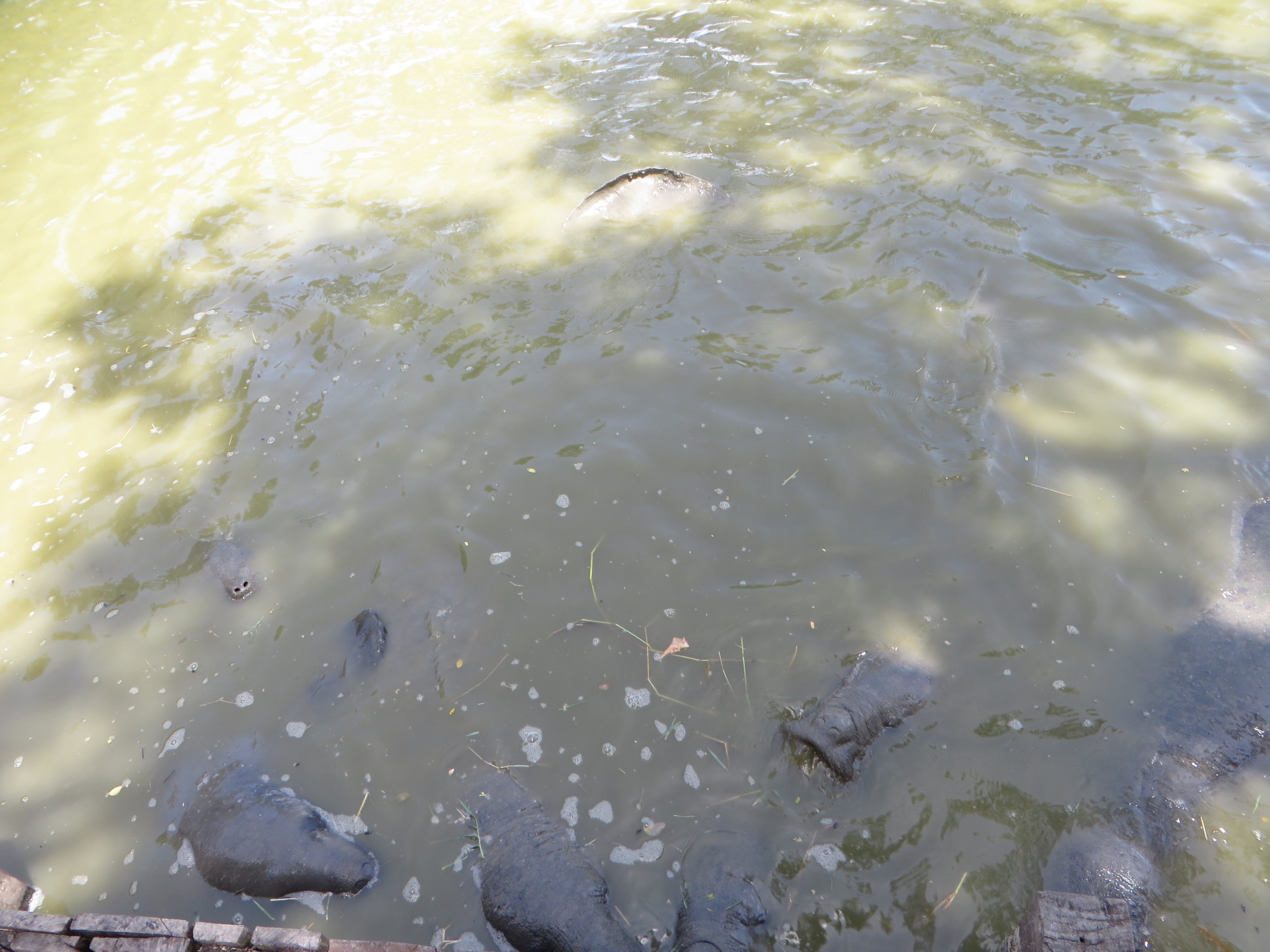
Day 51
6 March 2019
Other than in Colombia and Brazil, there is not much public presence of police or soldiers. But there are guards hired by private persons or companies. At the entrance to a supermarket, the was a guard, heavily armed with a rifle as you would only expect that if a store would be prone to be stormed by masses after a hurricane or so. But this seemed to be common practice. We were told to be careful, to avoid certain places, not to walk outside in the dark, and to carry no bags ot anything that could provoke robbery even at daytime. The people we had experienced in northern Brazil had already been less lively and friendly than those we had met in Colombia; but over here, in Guyana, changes have gone further into that direction. Things are not much cared for, not well-maintained, and not well organised. But despite that, prices are quite high.
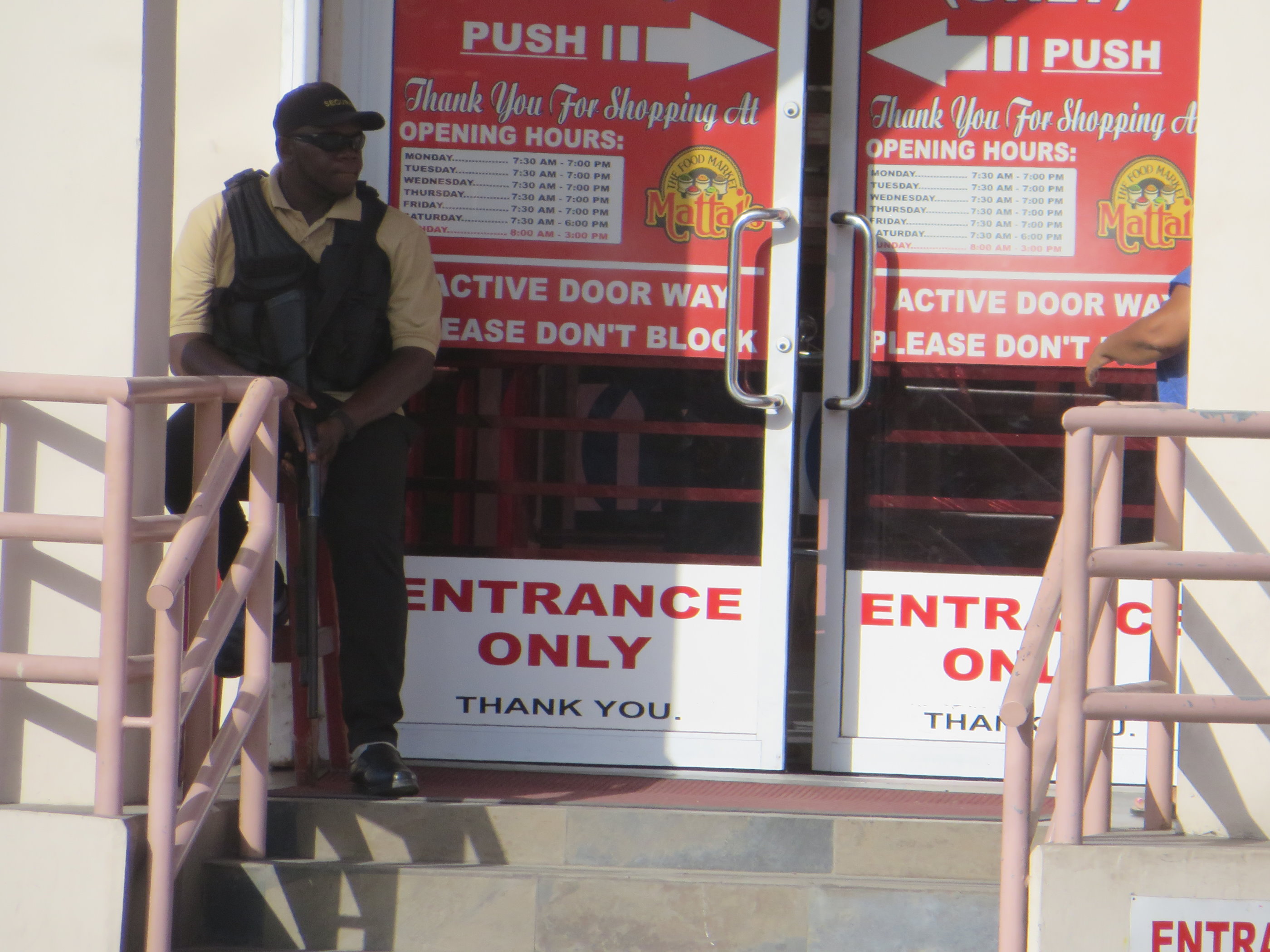
Day 50
5 March 2019
St. Ignatius is a quarter in the south of Lethem. To go there, you have to cross one of those wooden bridges that have planks like tracks to drive on for the cars. Like the rest of Lethem, where the road, although consisting of nothing but red dirt, is as wide as a motorway, yet empty, St. Ignatius is a rather desolate place. The wind howls and makes bent signpost rattle; apart from that, it is quiet, and the sun burns down on you. Yesterday someone said the benab of St. Ignatius was situated next to the Catholic church. I did not see any church there, but only a kindergarten in front of the benap. The benab itself consists of a huge wooden construction, impressively large and with a high, peaked, thatched roof. It could apparently hold quite a number of people. But the driver said yesterday that it was only used about twice a year for some festivities.
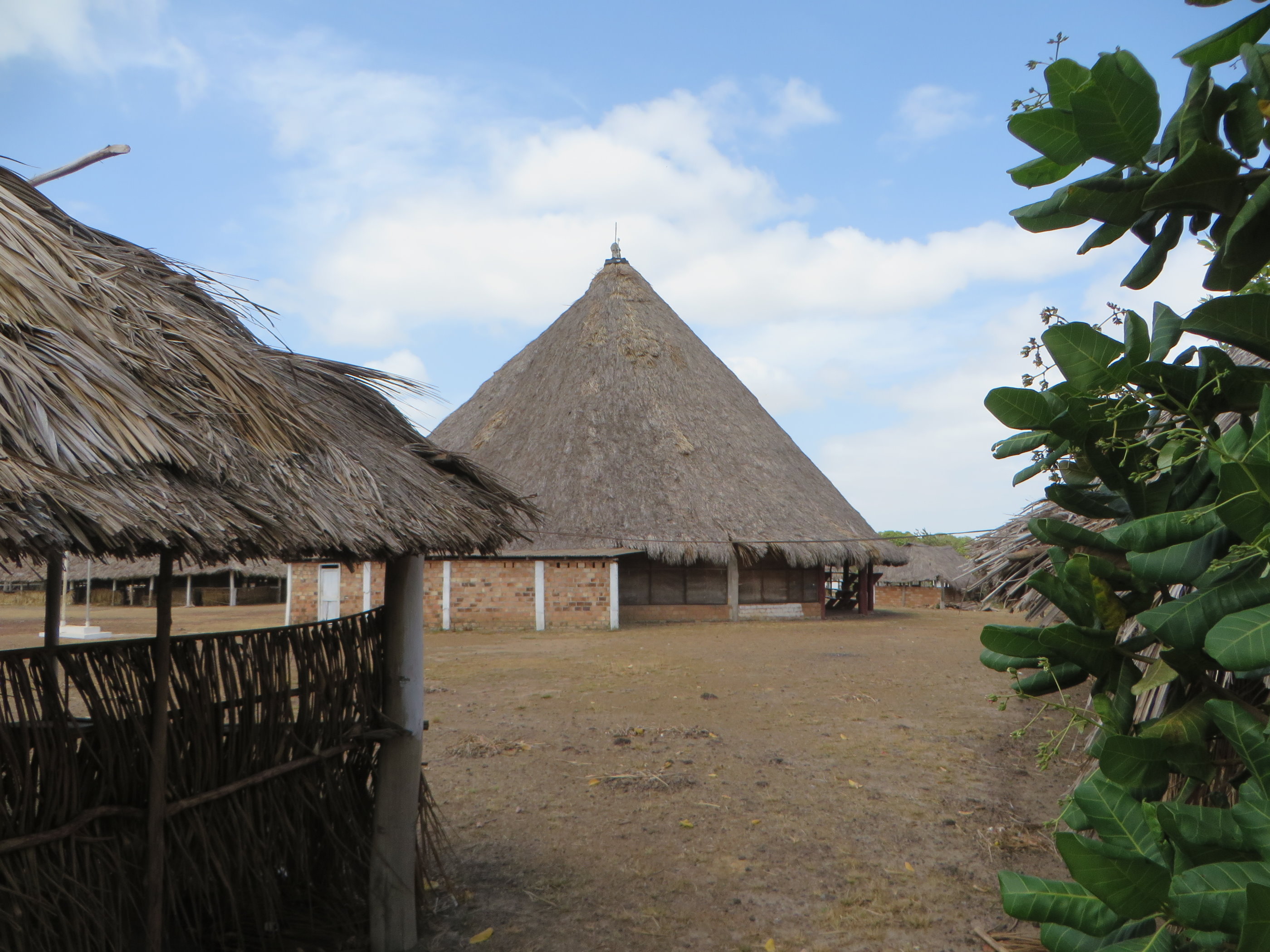
Day 49
4 March 2019
We took a collective taxi to Bonfim, the Brazilian border town with Guyana. When you cross over to Lethem, the little town on the Guyana side, a flyover takes you to the left side of the road, with a tunnel underneath, which does the same with vehicles going to the opposite direction. There is not much to see in Lethem, the roads are wide, consisting of red dust, with some larger Chinese stores at the town entrance and an airstrip right in town. There are two ATMs, which don’t work with chipcards, which means that people from the so-called First World cannot use them. Outside the town, there are settlements with predominantly indigenous population. These people are called Amerindians over here. Their assembly buildings, called malocas in other parts of Central and South America, are called benab (pronounced like „banner“) here in English-speaking, formerly British, Guyana. There is such a benab in St. Ignatius at the southern edge of the town. With a driver from Trinidad, perhaps of south Indian descent, we went to the foot of the mountain chain, about 15 kilometres inland from Lethem. The driver told us that there were illegal mines further inside the mountainous area. That land belonged to the indigenous peoples, and therefore, mining companies were not allowed in. He took us to Kumu, where there are nice waterfalls in the jungle. It is on the plot of a family with predominantly Wapishana background; the man guided us through a not-so-easy-to-be-found trail to the highest of the falls and told us some of his family history.
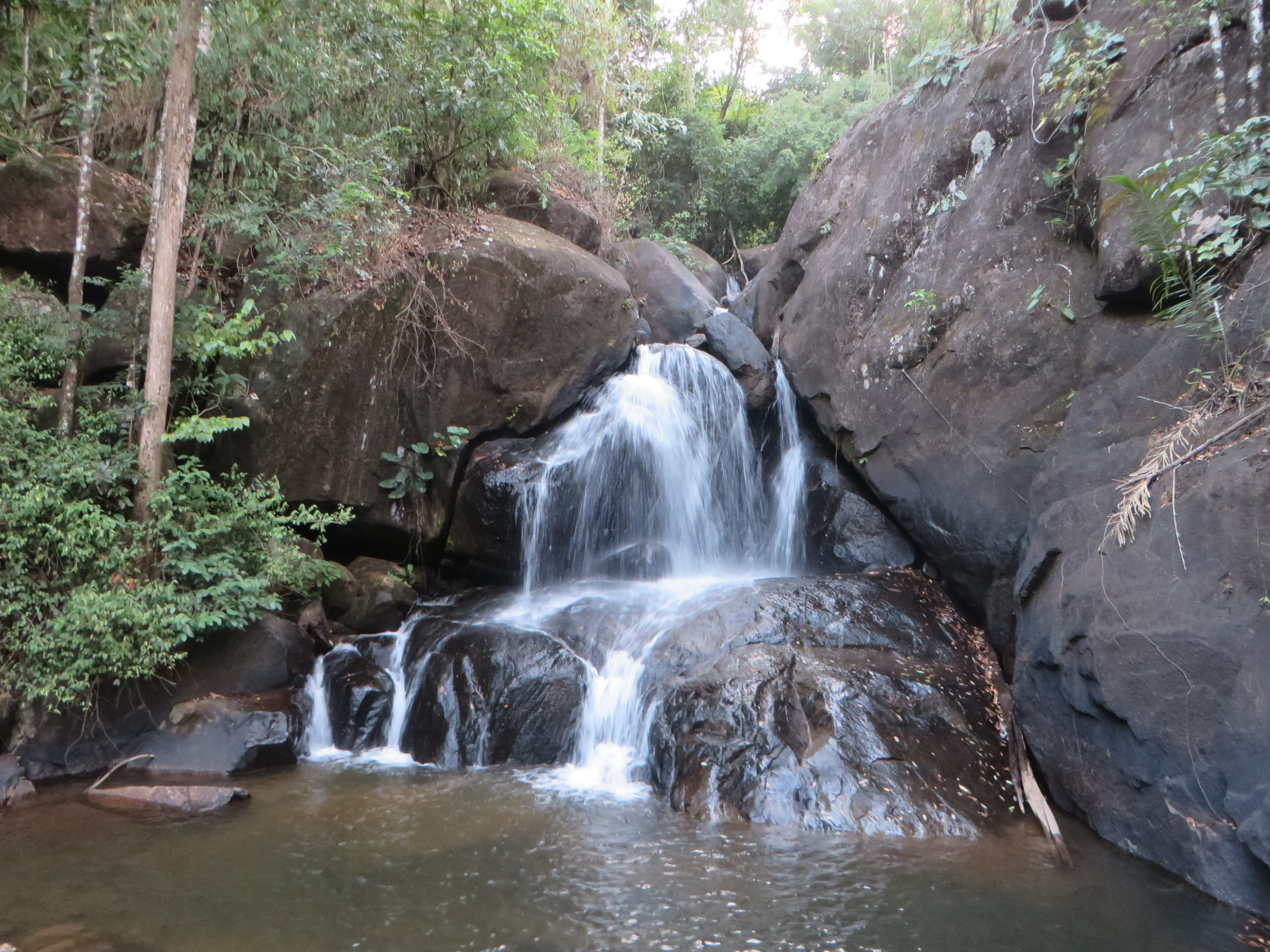
Day 48
3 March 2019
Several locals had assured us that the carnival
of Caracaraí was very nice, that it was better than that of Boa Vista, and yes,
that it was even considered to be the best of the federal state of Roraima, in
which there were just two carnival cities, Boa Vista and Caracaraí. Allegedly, so
many people went to Caracaraí that the hotels there did not have enough
capacity, and therefore people came to stay in Boa Vista, from where they went
the more than 100 kilometres over to the Caracaraí carnival and back, to sleep
in Boa Vista. So, after having attended the Boa Vista carnival already the
night before, we decided to also have a look how they do that in Caracaraí. We
went to the bus station and found that there would be no bus back to Boa Vista
that night. But, so we were told, there was another terminal with shared taxis,
which we could try. O.k., we took another Uber over to that other terminal. Those
shared taxis only leave when there are six passengers. We almost had that
number, but still, it was all but sure that we could return the same night. We finally
gave up and decided to give the Boa Vista carnival another try. Well, it is
quite different to what I had seen in Rio as a student. It was a bit better,
though, than the night before. More people in costumes (like us) and
accompanying the trucks with the music groups called blocos, which means walking in front of it, sort-of dancing,
separated from the people on the sidewalks by a rope. There were three trucks,
slowly going round and round, up and down the avenues alongside a rectangle of
several hundred metres, in which there are stalls with food and drinks, as well
as a stationary band playing. Depending on where you find yourself, it can
happen that three different sounds from the trucks and the band almost blow
your head off. Loudness seems to be what matters most. Without earplugs, it
really hurts. But people seem to like it, they grow up with it. Mothers are
breastfeeding their babies right in front of the oversized loudspeakers that
make your body heavily vibrate with their basses.
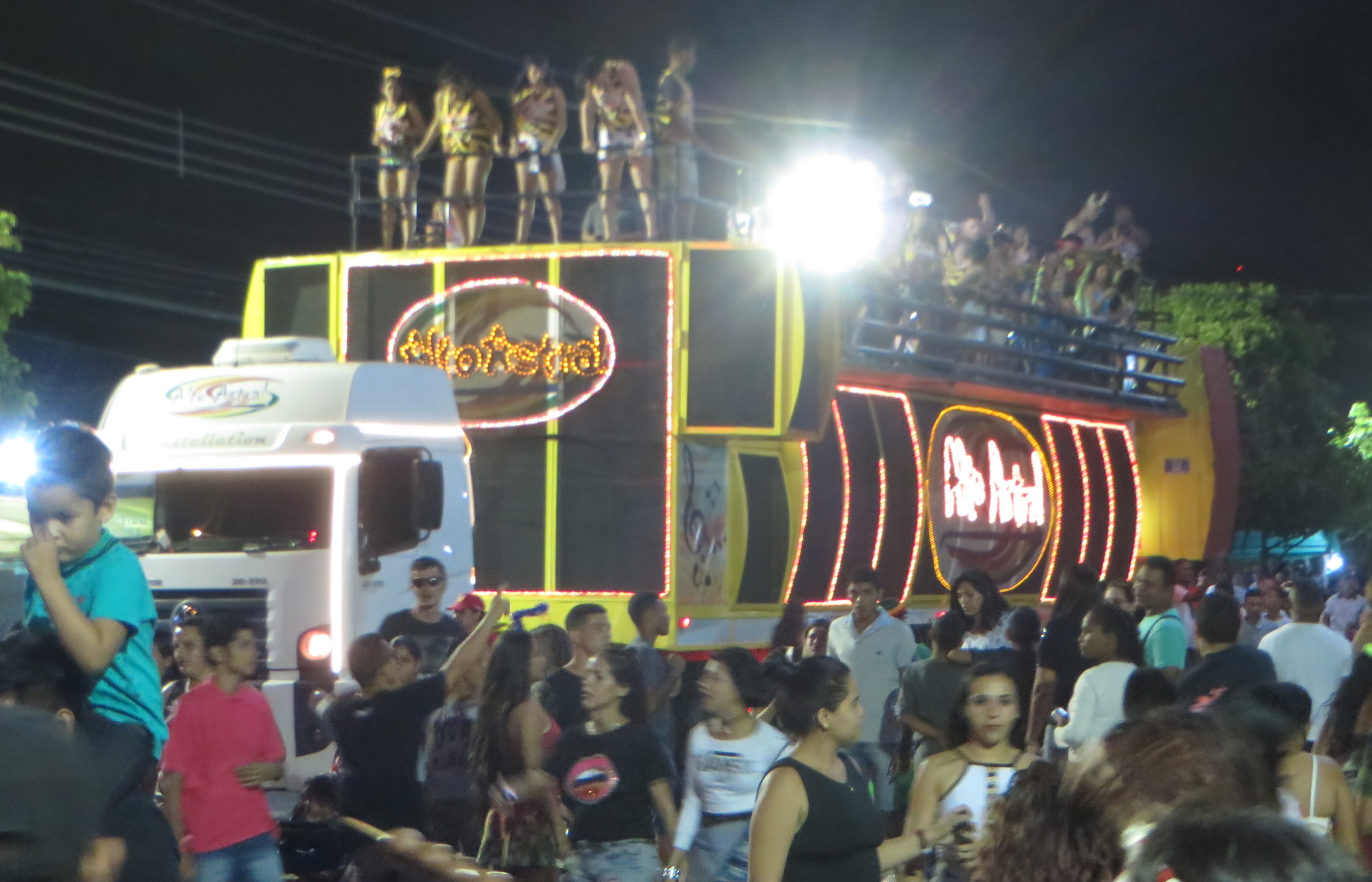
Day 47
2 March 2019
In the three-frontier region of Venezuela, Guyana and Brazil, there are a number of table mountains, so-called tepuis. One of the famous tepuis is Monte Roraima. Although the name giver for the Brazilian federal state of Roraima, it is situated at the border with Venezuela, from where it is only accessible (at least officially). But as Brazil has closed the border to Venezuela, we had to give up our plan to see it. We could not even get close enough to Monte Roraima to take a picture of it. So, we had to pursue plan B, which, in this case, was Serra do Tepequém. It is actually a chain of more-or-less table mountains. On the way to it, we saw a group of Venezuelan refugees walking on the road towards Boa Vista, waving bottles and signalling that they were hungry. They were carrying almost nothing, and we were feeling really bad that we were of no help, as we did not have much water of food with us on this short trip to Tepequém. However, we saw other refugees queuing in front of the UNHCR tents in Boa Vista at the bus terminal, where also a number of small tents was pitched, apparently of refugees who had decided to stay in that city for a while. The region around Boa Vista is savanna, and the closer we got to Tepequém, the greener the countryside became. Nevertheless, it is dry season now, and the waterfall, to which we climbed after having been at the edge of the top rim, carried only little water. According to the fern and the moss, it must be quite moist at other times of the year. Back on the plain, we stopped at a little stream with adjoining pools, all of which were quite shallow. Strangely, there were some flooded spots along the way with rotten palm trees in it. A typical palm of this region is Buriti, Mauritia flexuosa, the fruit of which are highly favoured. This palm species can easily be identified by its tousled look.

Day 46
1 March 2019
Whereas in European graffiti, religion is hardly ever thematised, and if so, then probably in rather cynical ways, this is quite different in many other parts of the world. Expressions of faith cannot only be found among the sprayer scene; rather, religious statements of various semiotic levels are made by virtually all segments of the social spectrum. Shops are given respective names, buses and cars carry inscriptions and stickers, people wear T-shirts and other garment with religious imprints. Several times, we saw persons with a shirt or a cap on which the word “fé”, faith, was written in a cross-shaped design. Taxi drivers often have rosaries and pictures of saints at their rear-vision mirror. However, it is not all Catholic. There is a large variety of denominations, with their buildings often side-by-side. This is very similar in Africa, by the way, as well as in so many other countries. In cross-cultural comparison, the European detachment from religion, which is treated there like something embarrassing, is quite exotic and untypical with regard to normal human communication and social systems.

Day 45
28 Feb. 2019
Another famous building of Manaus is that of the so-called “rubber baron” Karl Waldemar Scholz, hence also called the Scholz Palace. Scholz built it in 1903. Its interior bears typical German features, like other private buildings of upper-class Germans of that time. Yet, like the Teatro Amazonas and Manaus in general, there was an abrupt end of its glory due to the sudden end of the rubber boom. Though forbidden by threat of death penalty, some British had managed to smuggle seeds of the rubber tree, Hevea brasiliensis, out of the country. In the following, rubber plantations were founded in Malaysia, and Brazil’s rubber monopoly was broken. Now, there are rubber plantations in many parts of the tropics; for example, I saw one upon my last visit to Cameroon. After the decline of the rubber boom, the Scholz family returned to Germany, and the palace became seat of the government of the state of Amazonas, then being called Palácio Rio Negro, until 1995, and was then transformed into a museum.
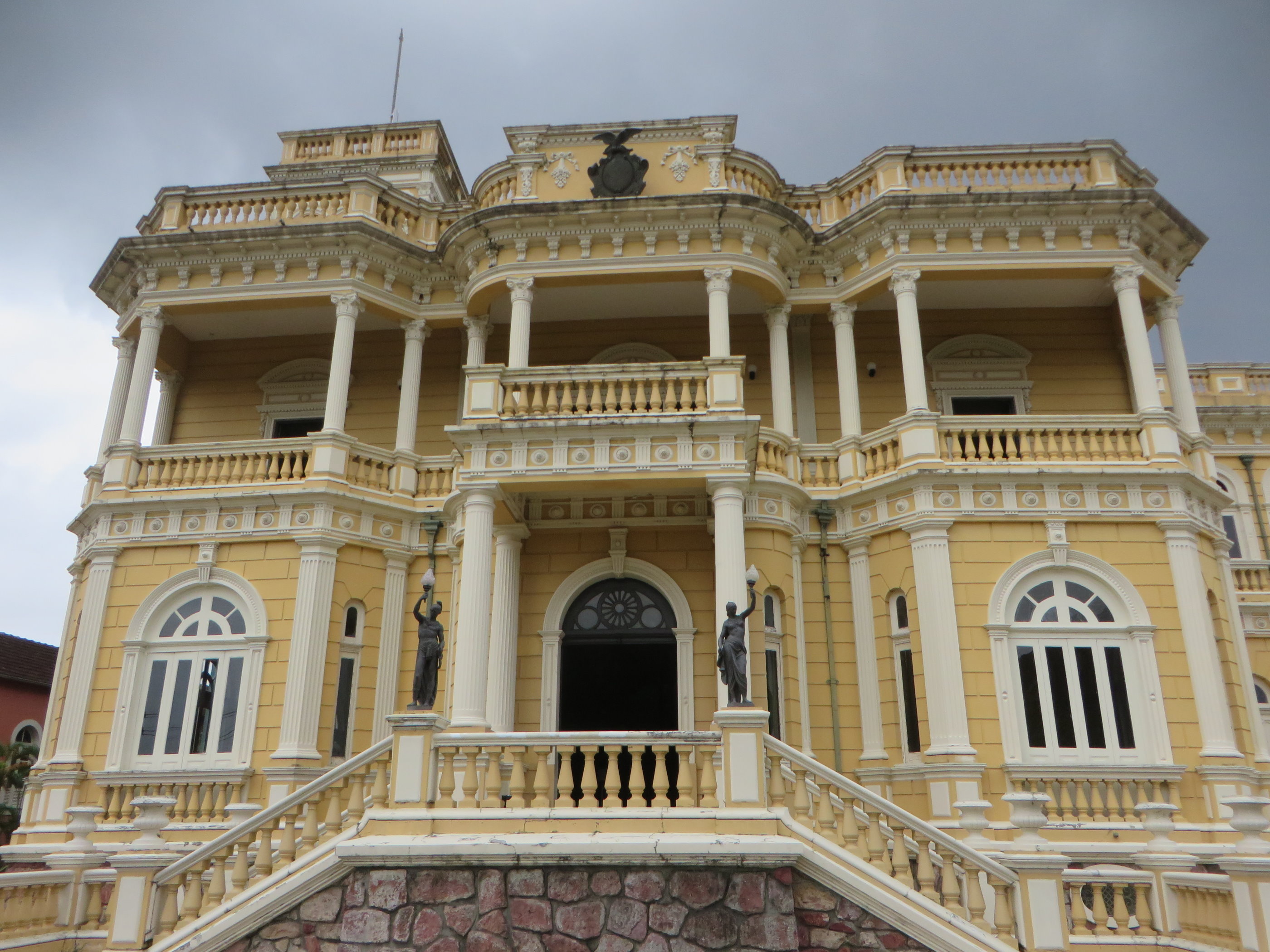
Day 44
27 Feb. 2019
We visited Tuyuka people, who live in a village near the south bank of the Amazon river. After obtaining consent from the chief, I explained the indigenous rights and informed about other indigenous peoples. We then carried out some studies. The Tuyuka seemed especially interested in our cross-cultural investigation on the emotional rating of sounds. To cross over to their village, our little boat first went through the black waters of the Rio Negro, at the northern bank of which Manaus is situated, just before it merges into the Amazon river; then the water became somewhat muddy-brownish, and remained that way until we reached the Tuyuka settlement at one of the adjoining waters.
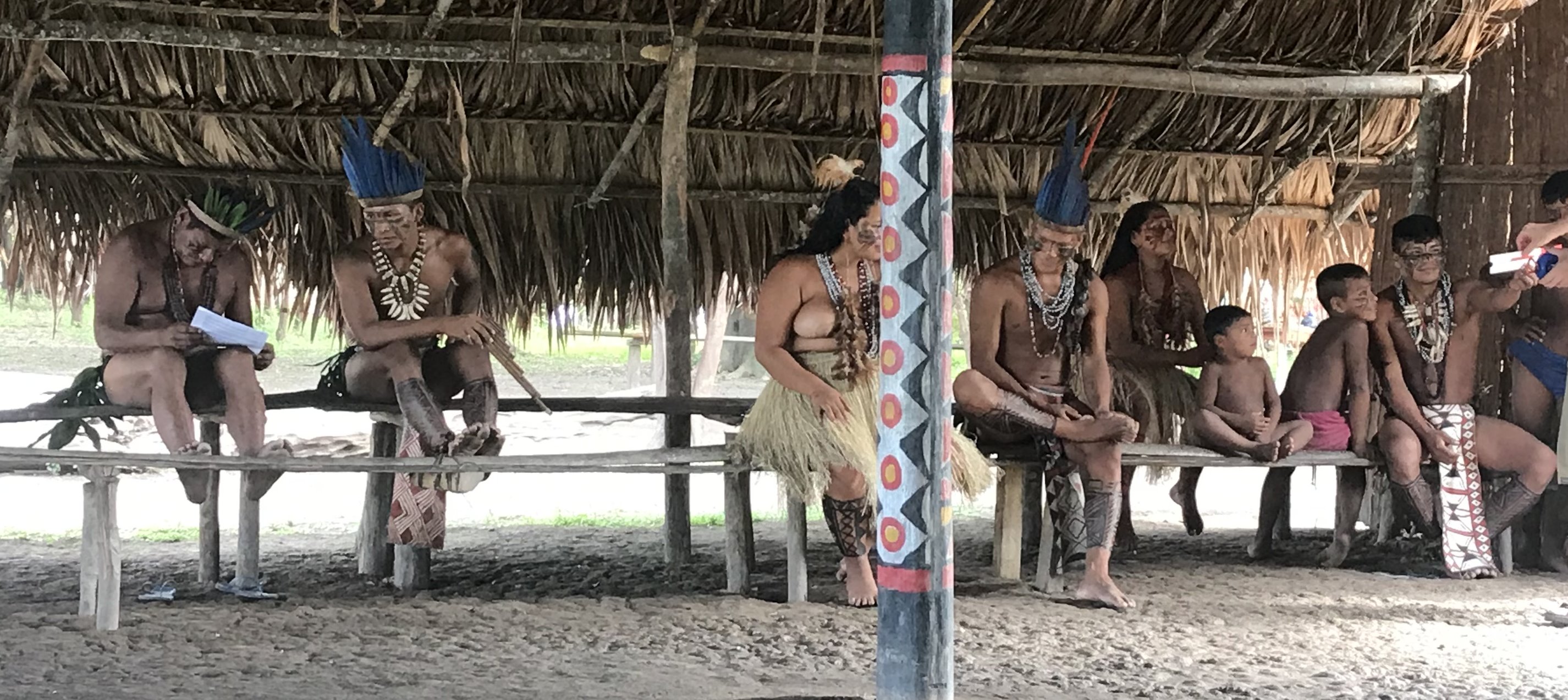
Day 43
26 Feb. 2019
Teatro Amazonas, the opera house, probably is the most famous building of Manaus. It stands, paradigmatically, for the rubber boom that led to the rapid growth of the city, and on which its prosperity was based. Its interior reminds a bit of Milan’s Scala, although it is much smaller. While the Scala can host about 2000 persons, the Teatro Amazonas can host only about 700. The ceiling’s painting tries to convey the impression of standing right underneath the Eiffel Tower. When I was in Manaus in 1982, the building was under renovation. After being active for only ten years, from 1897 to 1907, the Teatro Amazonas was dormant for several decades until its reopening in 1990. Now, we were lucky to attend a performance of classical guitars and vocals this evening.
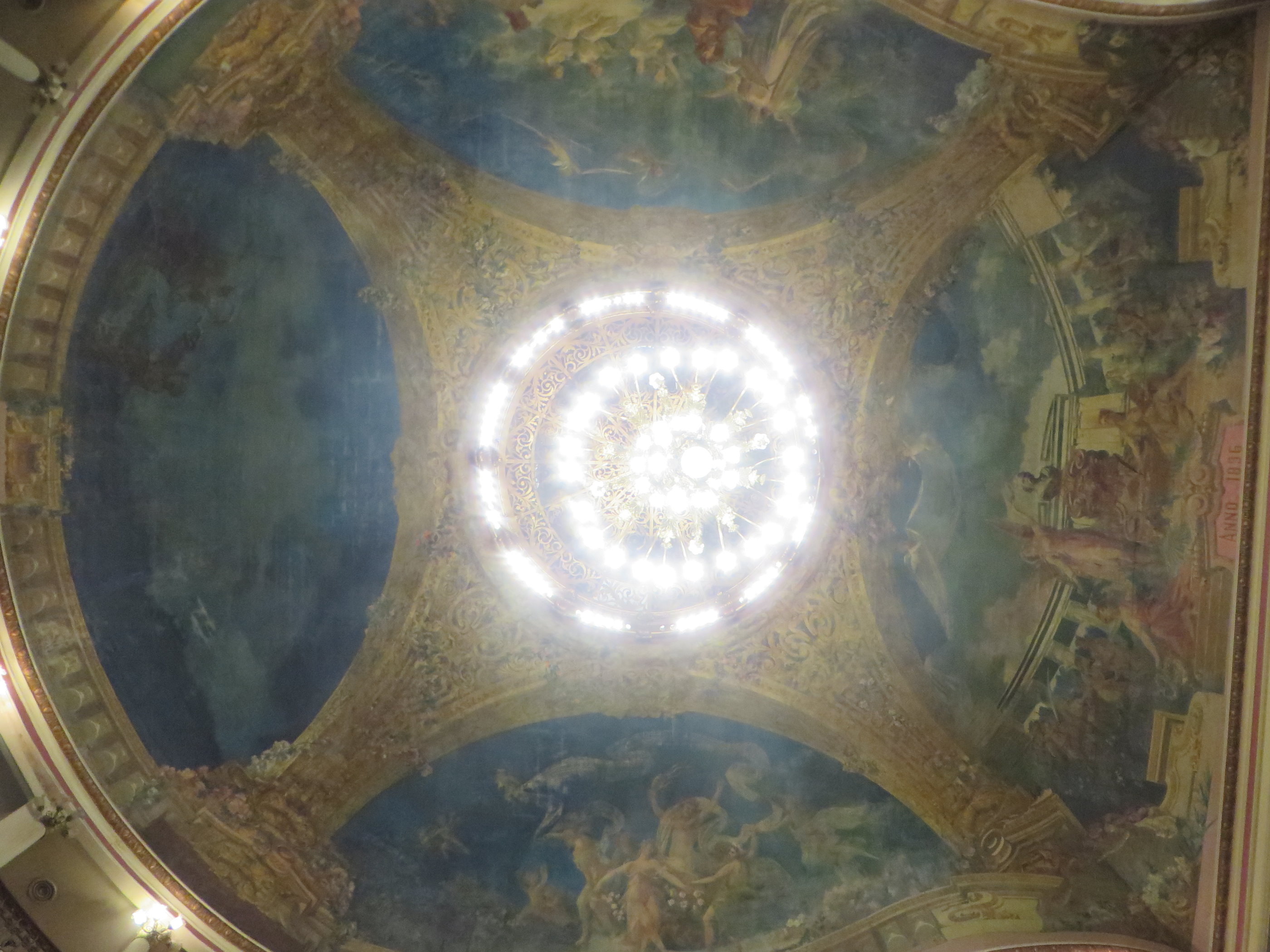
Day 42
25 Feb. 2019
This evening, we saw one of the most incredible sunsets ever. It was extremely colourful, a magnificent scenery of the sky with the setting sun, the water surface and the silhouette of the forest, albeit some of the clouds might have originated from condensation trails even in this part of the world. According to weather records, cloudiness has risen to 300 percent during the 20th century. As for the explanation that this has been caused by aviation, the effects of the three-days flight ban over the USA after the attacks of 11 Sept. 2001 indicated that there is such a connection indeed. The global clouding actually causes an increase of the albedo, and thus, it is part of the global dimming, which, along with other effects such as increased snowfall in subarctic regions, reduces the effects of global warming. Particles in general, like those from industrial pollution, not only contribute to global dimming, but can also cause particularly colourful sunrises and sunsets. Nevertheless, we enjoyed this evening’s play of colours on the sky over the Amazon very much. We joined with some other passengers at the stern of the ship for a sundowner ‑ a nice opportunity for exchanging travel experiences ‑, until the stars came out, which we then tried to identify by using the smartphone app Sternatlas.
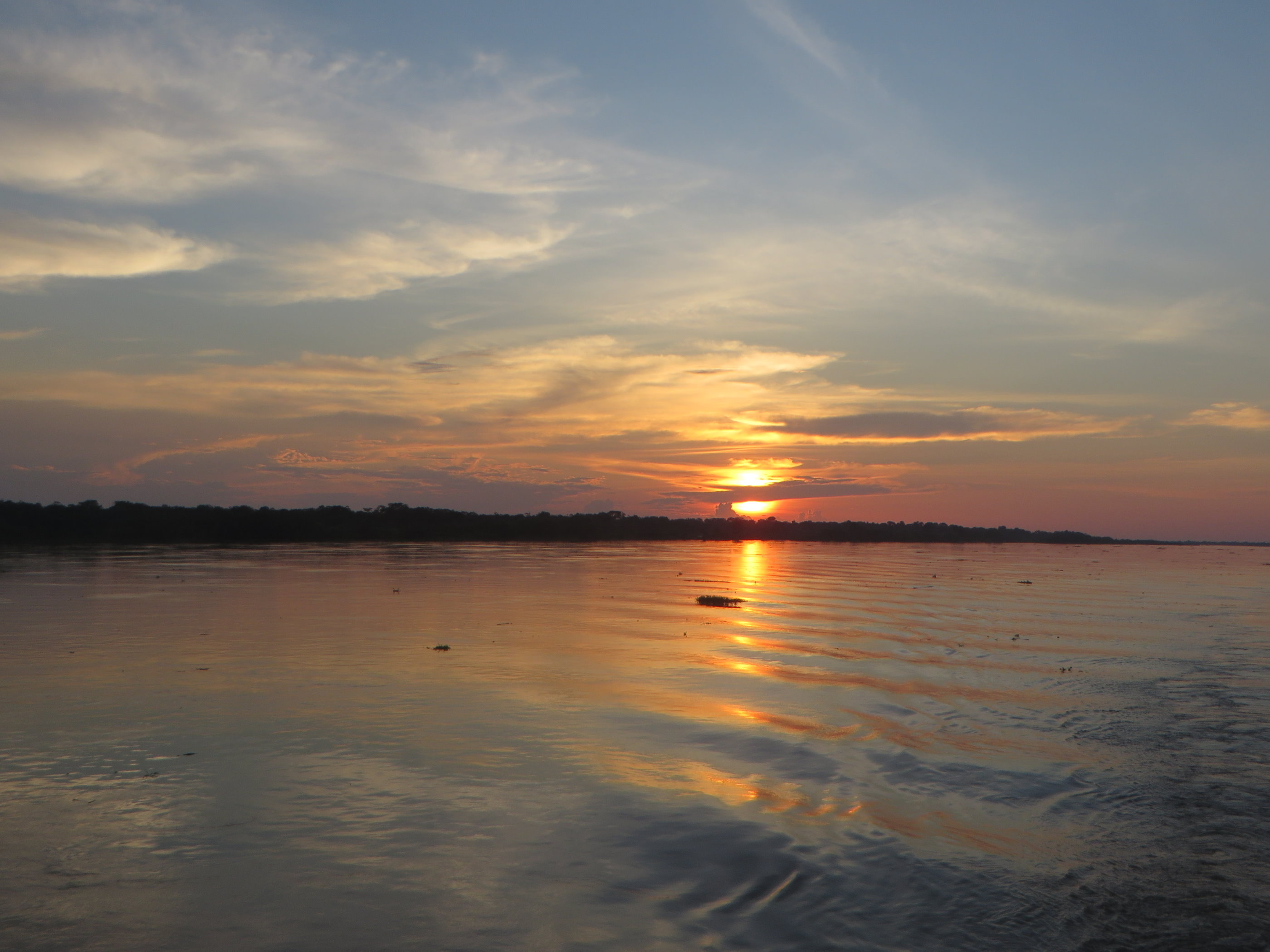
Day 41
24 Feb. 2019
On this three-day trip down the Amazon, we are directly witnessing some of the mechanisms of weather, which are part of the mechanisms of climate. Sunshine is followed by rain, after which the forest is steaming, producing clouds that rise up to rain down again elsewhere. The river, which the Brazilians call Rio Solimões upstream from Manaus, does not have one defined bed. It changes its course over time, being less large in dry season and wider in rainy season. As rainy season has started, the captain is taking shortcuts on this trip through areas that fall dry in other times of the year. Sometimes, we are close to the jungle, other times we are far away from the shore, almost like on the open sea. I am missing the sweet smell that I remember from the Amazon when I did another boat trip as a student, from Belem up to Manaus. Most of the forest that we see now is no virgin rainforest, but secondary, and the riverside is washed away, along with the trees, at most of the stretches, contributing to the brownish colour of the Amazon river. Calling this forest one of the “green lungs” of our planet is a metaphor, which only partially covers its significance. The point is that in plants, carbon (C) is stored, as it is likewise stored in coal and other fossil fuels. This C is taken from CO2, as plants crack it by photosynthesis into C and O2 (oxygen), using the C for their structures and releasing the O2. Without this, we would not have oxygen to breathe. We should do our best to maintain as much forest and other biomass, and to leave fossil C where it is, in order to ensure that there is as much free oxygen as possible. There are indigenous people over here who know how to do that, as they have lived in, with and from the forest for millennia. Yet, instead of appreciating that, the industrial culture is eager to civilise them until all participate in globalisation’s destruction of planet Earth.
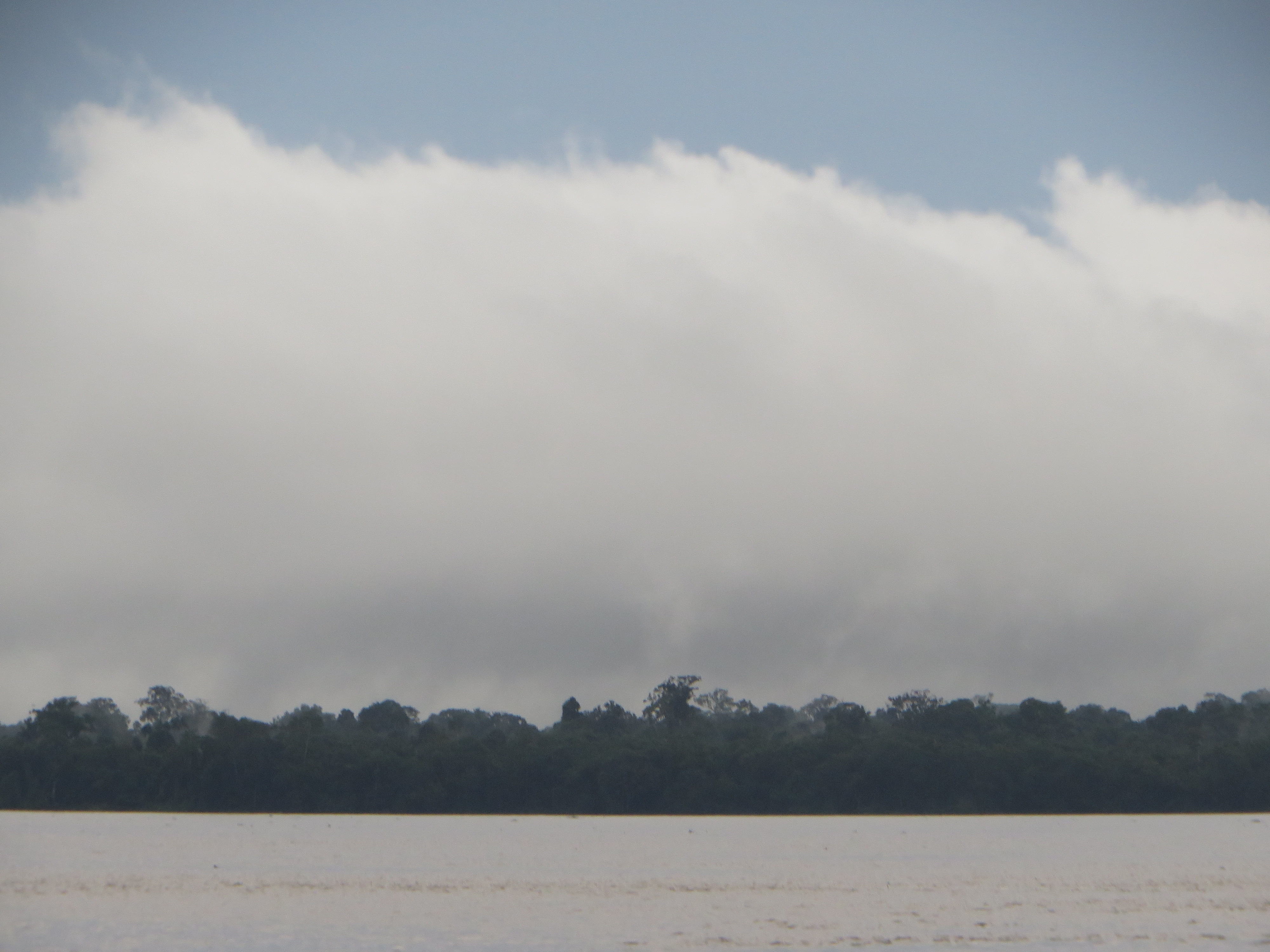
Day 40
23 Feb. 2019
To take the big boat down to Manaus from this town that exists like Siamese twins, one has to formally obtain an exit stamp from the Colombian migration authority in the part called Leticia, then go to the Brazilian part, which is called Tabatinga, to receive an entry stamp to Brazil. Then, one can embark at Tabatinga, where the luggage of all passengers is sniffed by a dog for drugs (the dog went mad at some passengers’ luggage, which was then searched, though without any consequences). The boat crosses over to Benjamin Constant, where it takes more passengers, who seemed to board directly from the street, without further checking. Anyway, in Tabatinga, we came across a wall on which it read in huge letters “CASA ISRAEL”, and next to it, there was a building with the sign “TEMPLO DA FÉ”, which I had already noticed the before. In Benjamin Constant, there is a building with the Hebrew Tetragram (the Lord’s name). Already in Mompox, we had seen large Magen Dovid and Menorah on the sidewalk in front of an institution that had a Bible with a cross at its emblem and “CRUZADA ESTUDIANTIL Y PROFESIONAL DE COLOMBIA” written at the walls. We also heard of a Colombian pastor, who had been to Israel, and after his return, had aligned his congregation towards Judaism. On the other hand, it seems like at least some Latin American Jews are not too well informed about the content of Judaism. Apparently, Christianity and Judaism seem to merge in this part of the world. This is certainly a better choice than the hostility that has prevailed through centuries and millennia. And after all, it seems so irrational that both had been separated in the first place.
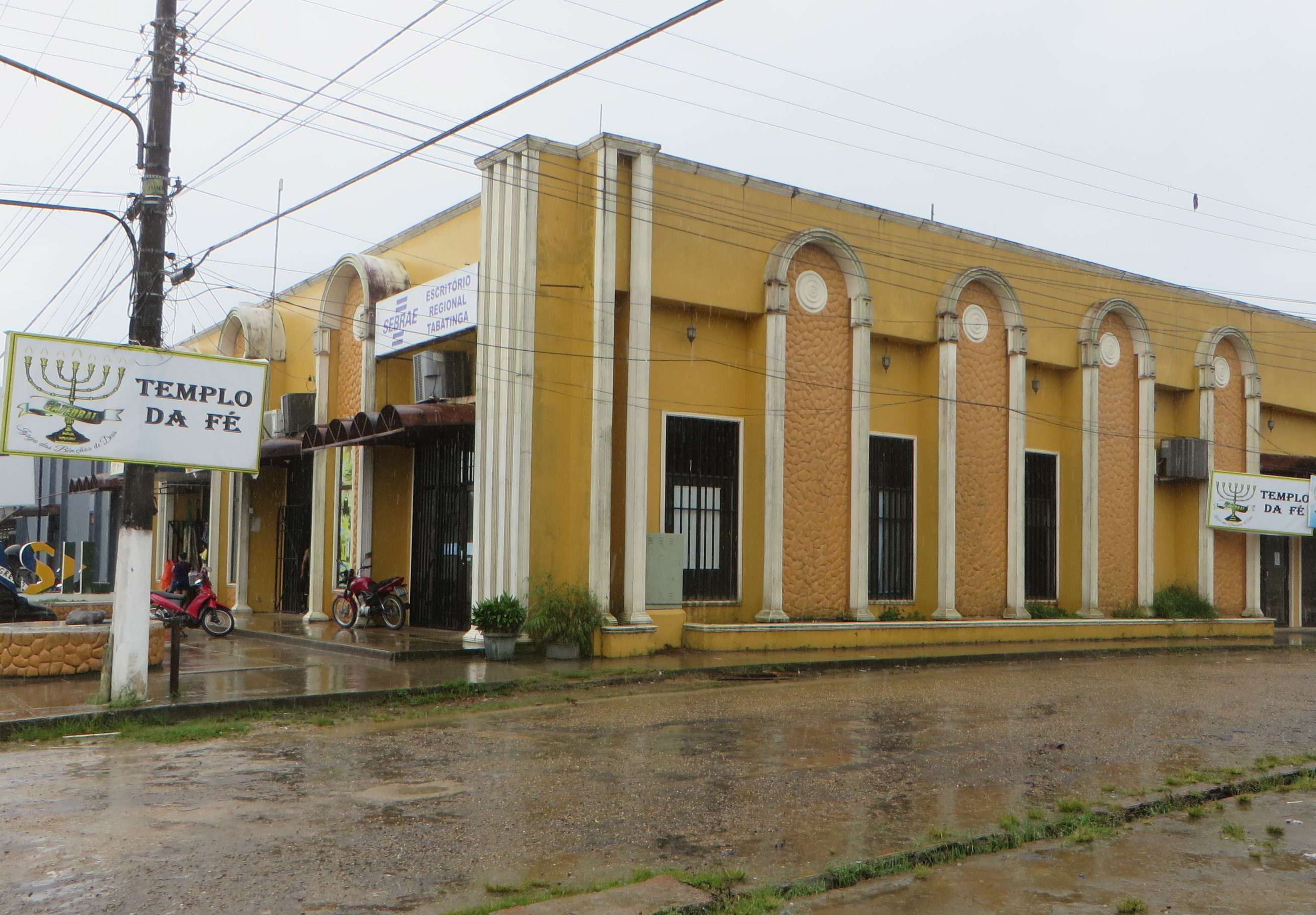
Day 39
22 Feb. 2019
We followed the recommendation we had received in Santa Rosa the other day regarding indigenous peoples near the Isla de los Micos (which had been a good recommendation), as well as in Atalaia do Norte. The same informant had also said, by the way, that mining companies wait until an indigenous people is gathered for one of their festivities, and then they use that opportunity to invade their land. Anyway, when we reached Atalaia, we asked about the Marubos Cazeteiros as recommended. There was a guide, a Cocama called Carlos, who only knew about Marubos Cazeteiros living far away, but who said he could bring us to Marubos (non-Cazeteiros) only a few kilometres away from Atalaia, to which we agreed. At the maloca, we first spoke to the chief and obtained consent to give the usual workshop. There were visitors around, an Italian family. I explained our objectives to them and said if they wanted, they could participate in the workshop, but then they should minimise their invasiveness like we did, which in particular meant taking off clothes, as otherwise, it would not be credible to explain to indigenous peoples their rights according to the UN Declaration, which is directed at respecting traditional culture and even grants the right to revitalise customs (Article 11). They immediately agreed, as they were interested in indigenous culture anyway. On the way back, we were cheated by the taxi driver, who did not pick us up as agreed, although he had received some advance payment. It was a weird situation; we only had small hand luggage with us, as the rest was in Leticia, and the last boat would leave from Benjamin Constant at 5:30 p.m. There was hardly any traffic, so we could not hitchhike. In such a moment, you can only pray. And indeed, all of a sudden, there was a police car that gave us a lift right to the port.
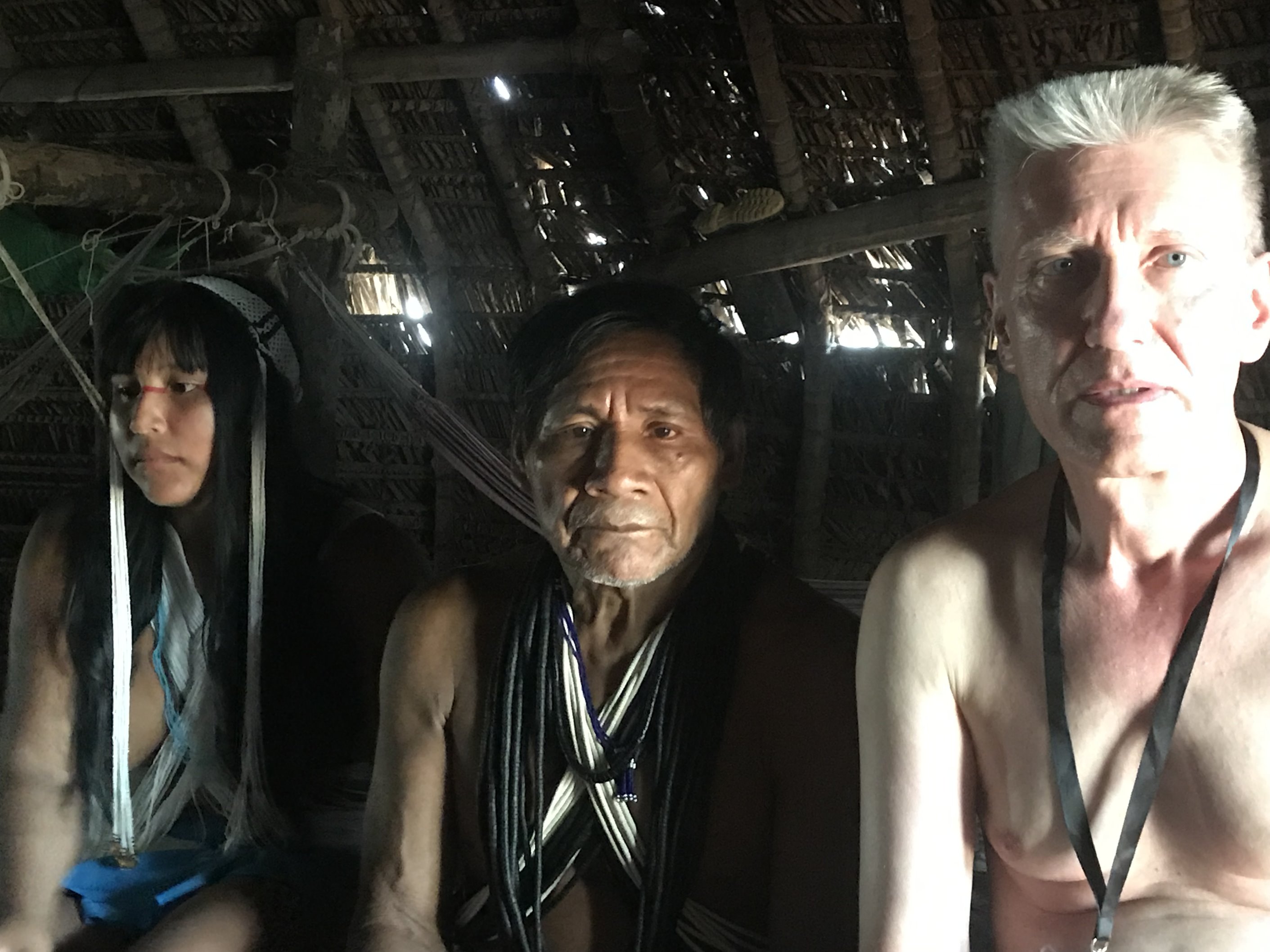
Day 38
21 Feb. 2019
I spoke with colleagues at two universities, with regard to contingent future cooperation, first at the Universidad Nacional de Colombia of Leticia and then at the Universidade Federal do Amazonas of Benjamin Constant. While the former is Colombian, the latter is Brazilian. When you go from one to the other, you take one of the many speedboats, which connect places in the Amazon region, functioning like local buses in our towns and cities. On the way from the Colombian town of Leticia to the Brazilian town of Benjamin Constant, one passes by the Peruvian island of Santa Rosa with its settlement. The trip takes about half an hour. In Benjamin Constant, there are no tuk-tuks, so I had to hop on a mototaxi, i.e. a motorbike that functions as a taxi. The two universities are quite different from each other. The one in Leticia is nicer, consisting of well-maintained bungalows situated in a garden-like, though small campus, while the one in Benjamin Constant is bigger, yet rather grey and sober, with an interior directed at plain functionality. In the whole region of those three frontiers, you can move freely, and you only need a visa if you go deeper into one of the countries.
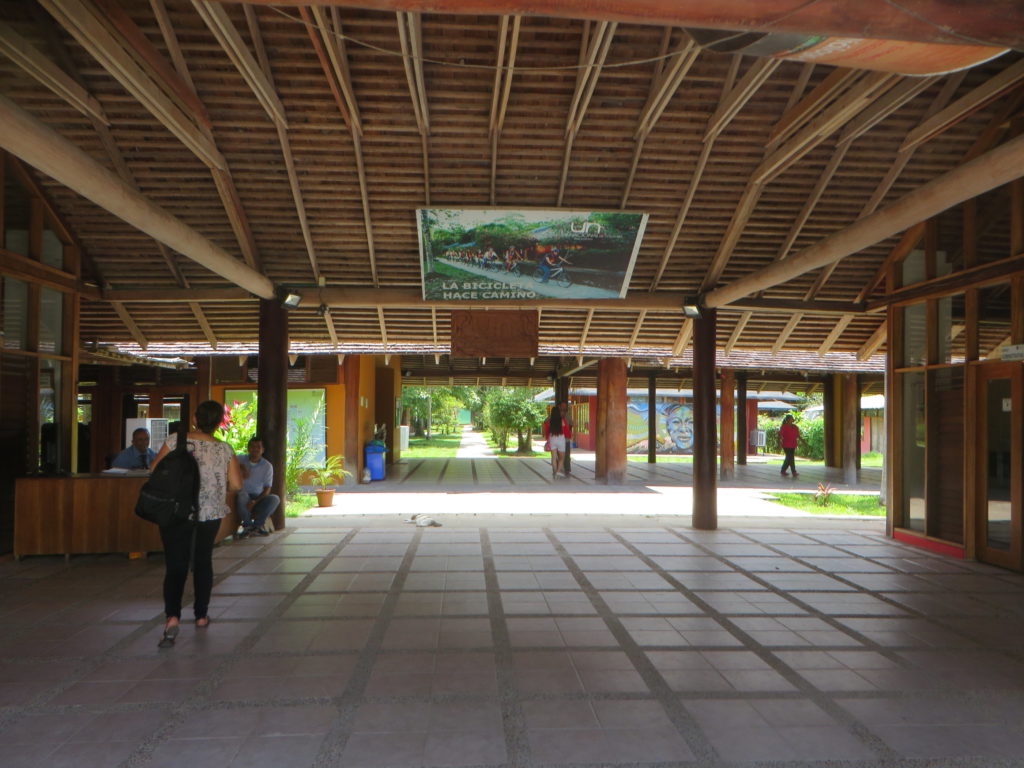
Day 37
20 Feb. 2019
On the way back to Leticia, we stopped over at the Isla de los Micos to meet Yagua people. I explained them about our work and offered to give a workshop. They brought us over to their village ashore, where we first spoke to the chief, who then assembled his people for the workshop, which we of course gave in the minimally-invasive rescue work manner, as usual. After that, some of the village people participated in our studies, and two of them also gave a short statement for a video clip to be provided to Survival International. This was the second time we worked with Yagua people after our first visit to a village of this people in Peru in 2015. The Isla de los Micos itself, from where we were picked up by the last boat to Leticia after previously paying double price for reservation, is a tourist spot, full of naughty monkeys, and a place where the sell-out of indigenous culture takes place. Fully dressed tourists watch and film topless indigenous people like animals. As for the UN Declaration on the Rights of Indigenous Peoples, this is an infringement of Article 8:2(a), as in the long run, this behaviour of the tourists has the effect of depriving the indigenous people of their cultural identity. Like indigenous people integrate into globalised culture when they go to town, the globalised visitors have to integrate into traditional culture when they go to indigenous places – that is the only acceptable way of intercultural encounter. The dominant behaviour of the globalised visitors already has the effect that the Ticuna women on the Isla de los Micos now cover their tops with bark. The UN Declaration is aimed at preventing such identity-relevant modification. But as things like this happen despite international agreement, it seems that the end of cultural diversity is nigh.
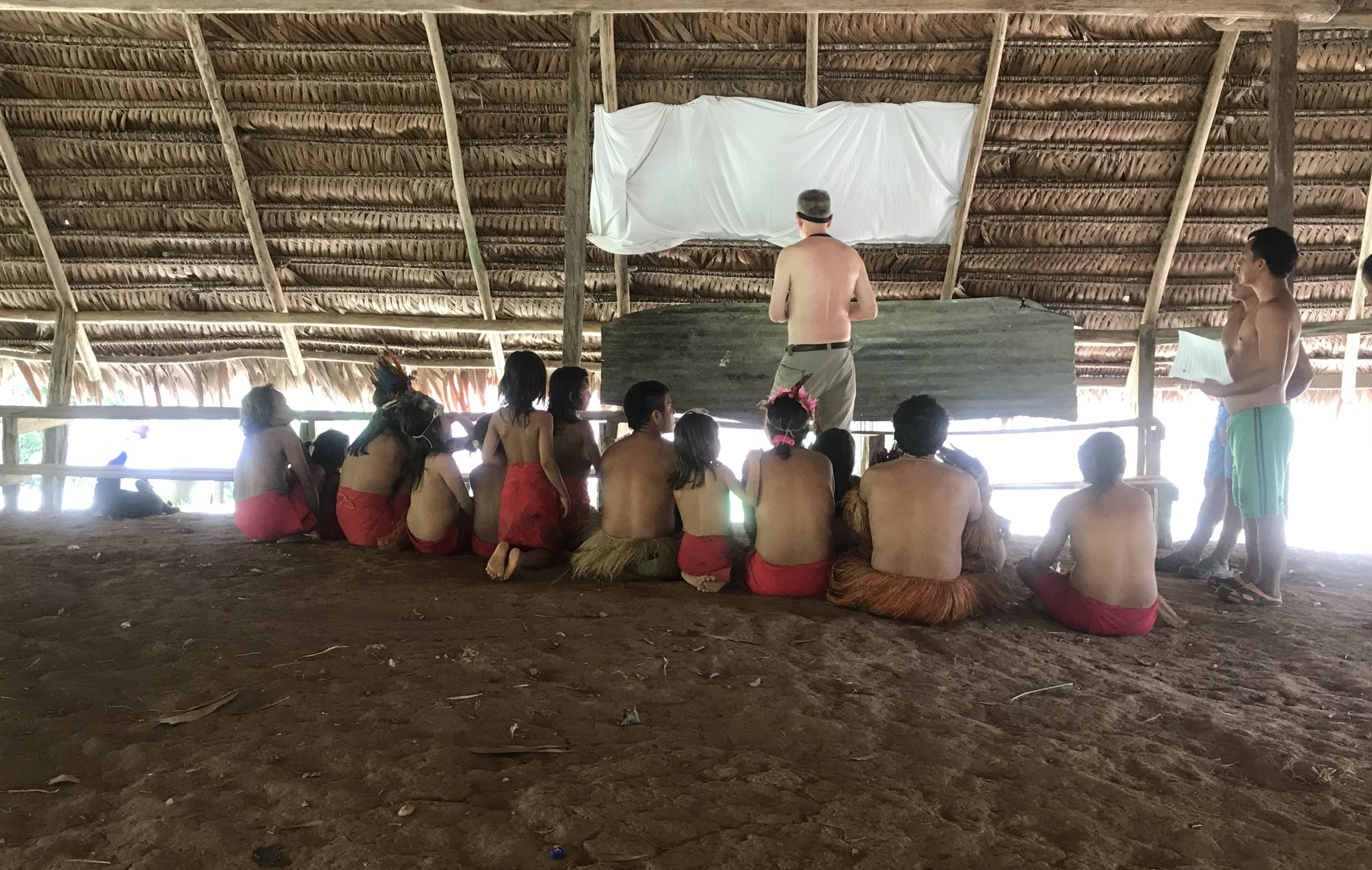
Day 36
19 Feb. 2019
We walked through the jungle with a local guide,
José, a Cocama with enormous knowledge about plants. He is originally from
Peru, but both of his parents died from snakebites when he was a little child.
Now, he is married to a Ticuna wife. He said that caimans usually came out at
night, but he brought us to a place where we could look down into a pond, and
after some waiting, a caiman came up to the surface, where it remained for a
while, so that we could take pictures of it. José said that not long ago, when
accompanying a French lady, he had killed, with his cutlass, an Anaconda, which
had just eaten a calf. Killing the snake had been easy because it had been lazy
after that meal. I told him about the schoolboy that had been eaten by a snake in
Borneo about the time when we were there (a German couple had shown us the
picture of the dead boy cut out of the snake). I asked José what people do when
they find a calf inside a snake. He said that when the meat is still good, they
eat it, which they won’t when it had already turned bad. Snake itself tasted
like chicken, he said.
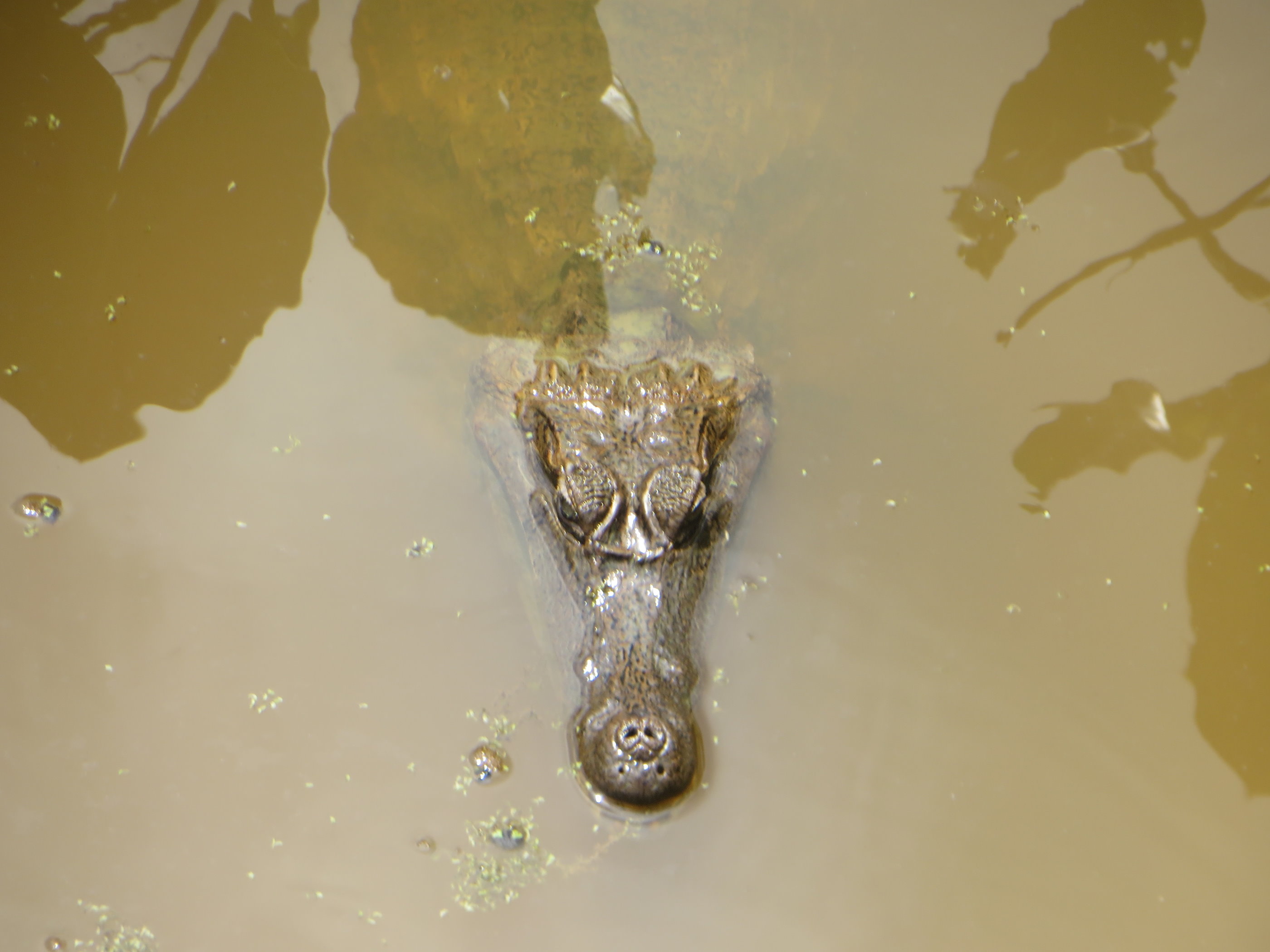
Day 35
18 Feb. 2019
We went upstream to Puerto Nariño, where we saw
dolphins just off the harbour, and even more of them when we had a look around
the adjoining waters with a little boat. These Amazon river dolphins are not as
pink as generally depicted, but grey on top, and that is the part that is
visible when they come up to take a breath. The water level is so high at the
moment that we could go through a swamped forest by boat. The dolphins were
topped by a sloth, which we saw in a treetop right next to the water, and which
even slowly turned its head towards us after I was whistling. Usually, they
cannot be spotted as easily as dolphins. When we came back to the village, we
stopped over at a sort-of supermarket, where they sell second-hand clothing.
That seemed rather absurd in this tropical climate, which is fine for the human
body as long as there is shade from real forest and the skin is not hindered to
adjust the temperature by evaporation. The coverage imposed by globalisation is
something very uncomfortable, yet it has become strictly standard in the towns
all over the tropics.
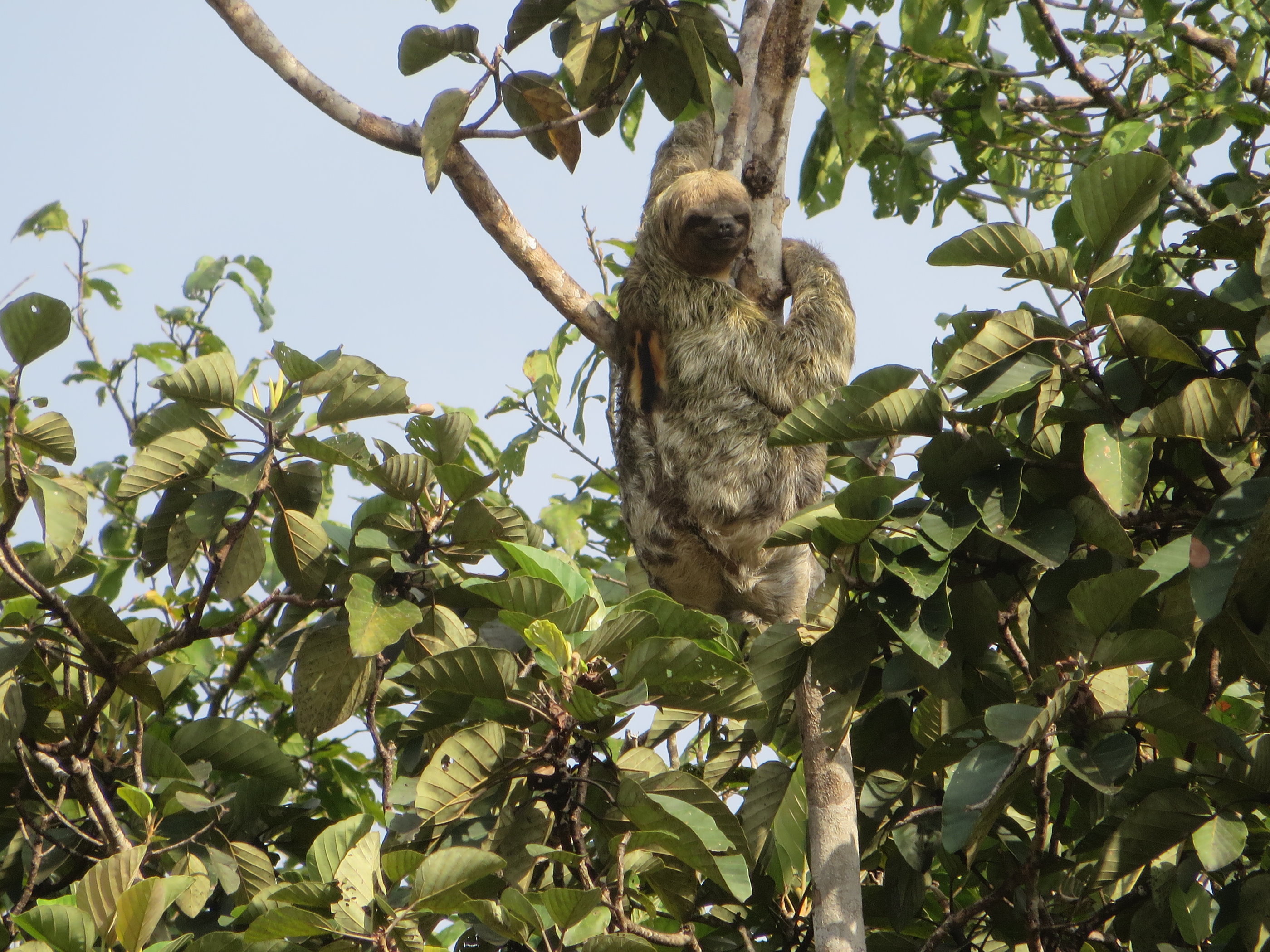
Day 34
17 Feb. 2019
It has been a hot day, despite the short, but heavy rain shower. We crossed
over to Tabatinga, the Brazilian part of this town, and then we crossed the
Amazon over to the Peruvian island of Santa Rosa, which was partially flooded. Here,
you can see three countries within half an hour or so. Back in Leticia, we took
a look at the Victoria regia pond,
and as expected, the flower we saw last night had withered. I spoke to a local
vendor lady about the birds, as we had heard them yesterday being quite noisy
up in their sleeping trees, with sudden pauses, strangely enough, before they
continued. She said we should come back at 5:45 (p.m.) if we wanted to see them.
So we did, and even before we arrived, the noise of the birds was extreme; in
the park itself, it was almost deafening. There were parakeets by the
thousands, scurrying over the sky and to the trees in flocks and swarms. Most
of them were hiding under the leaves right after landing, so that they were
hardly visible. The vendor lady recommended that we climbed up the steeple, and
indeed, we could see people up there. So, we went to the church, but there was service
going on there, and the verger said we would have to wait until some other people
had come down. After we were allowed up, we could see the scenery in different light,
literally, because now, the birds were not just silhouettes against the evening
sky, but we could see their colours better, at least for the moments when they
had landed on a tree.
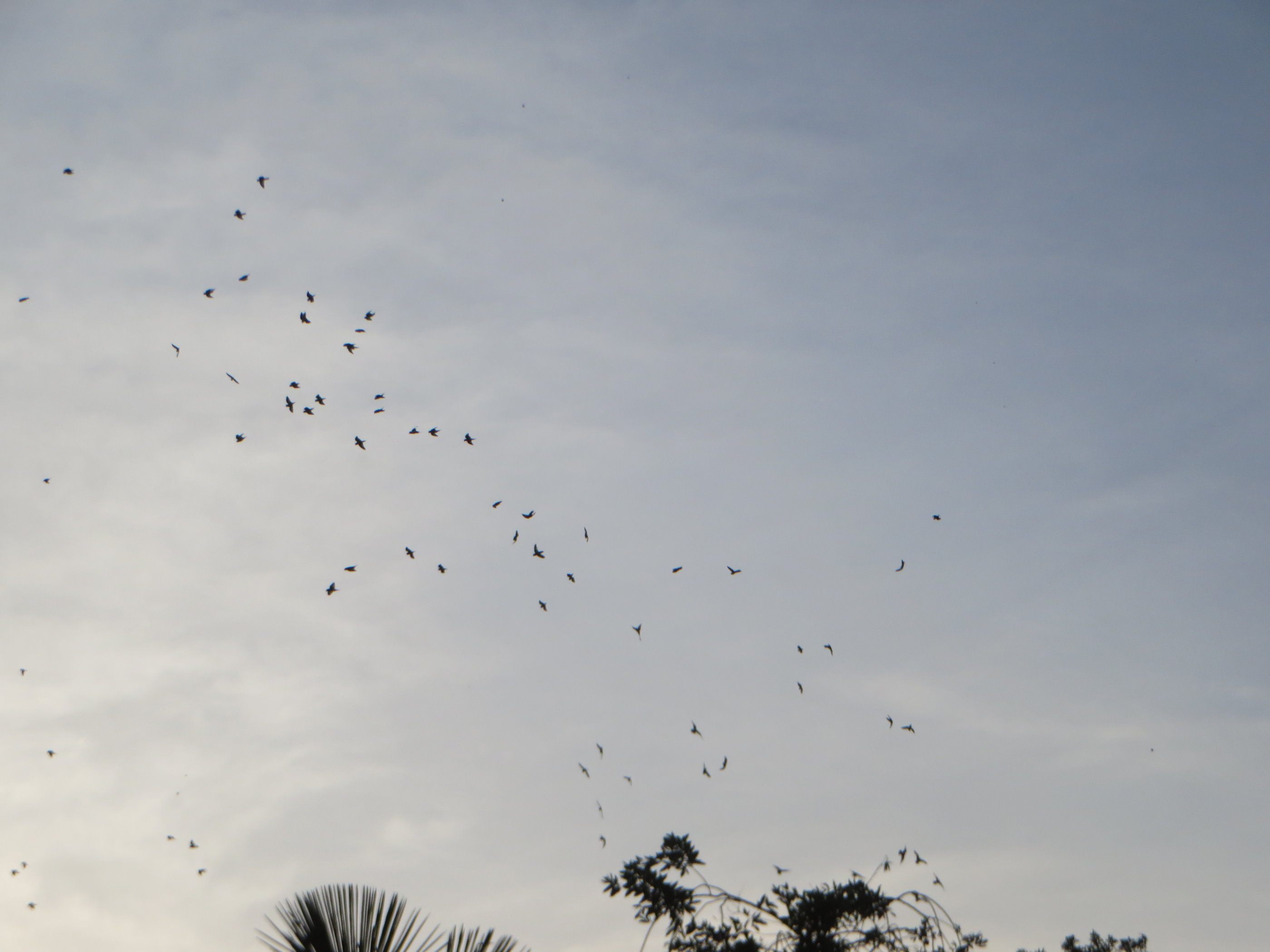
Day 33
16 Feb. 2019
Victoria regia is the world’s largest waterlily. Its floating, circular leaves have edges, and it is said that little kids, up to two-year-olds, can sit on them. But don’t try to touch these leaves from underneath, they are covered with extremely sharp thorns, presumably to keep fish away. Their large buds open up to blossom for a few hours of one night only. When this happens at the Berlin Botanical Garden, they have special opening hours for such a particular night, so that people can attend that spectacular event. Here in Leticia, they offer tours to places at the Amazon river where people can see these water lilies. The more we were astonished when we took a walk after nightfall, to find a Victoria regia pond in the main park of this town. And more than that: We found one blossom! We had never seen this before, not even in Berlin’s Botanical Garden.
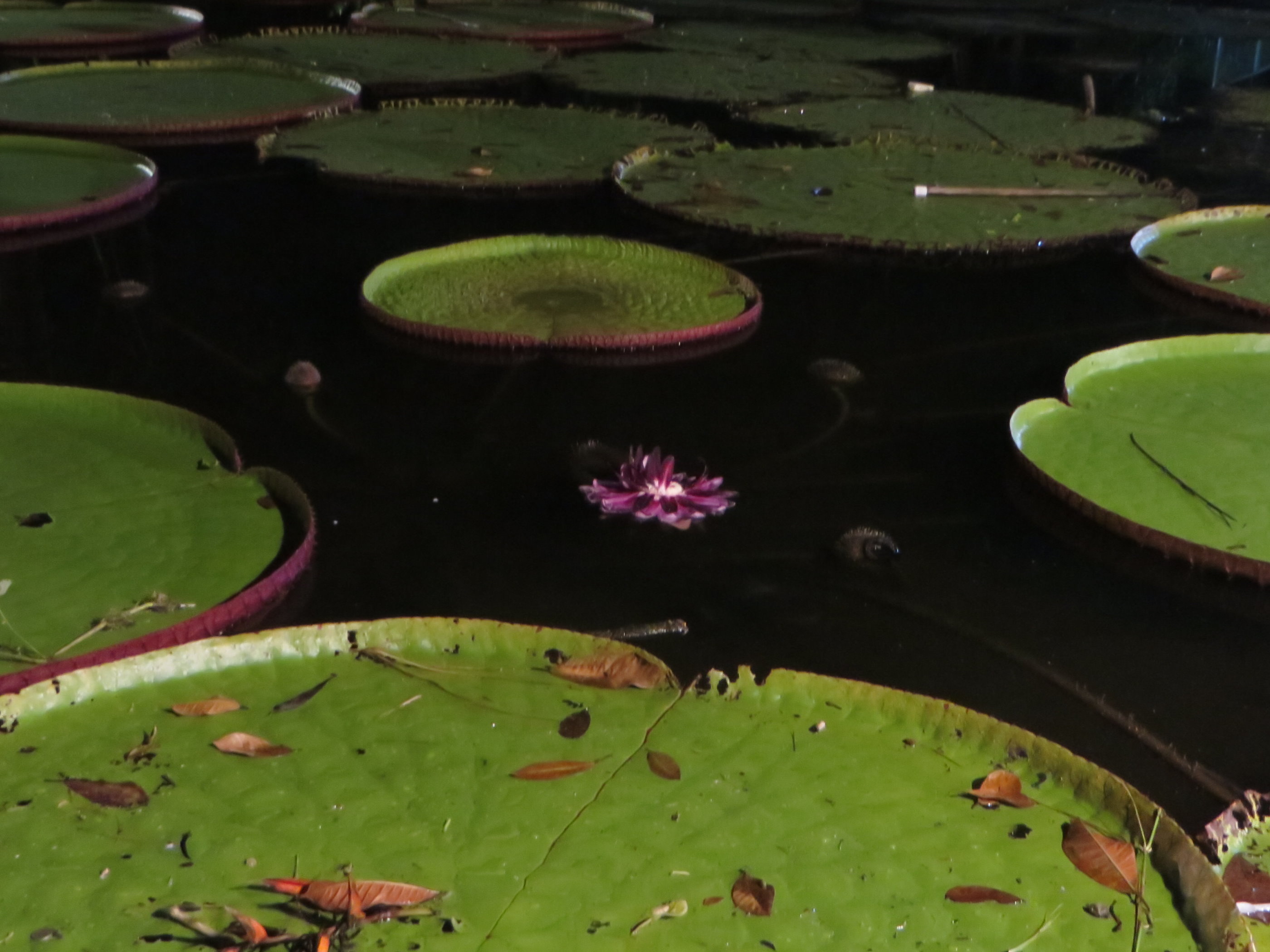
Day 32
15 Feb. 2019
I was going to write about Bogotá’s gold museum, which
is very impressive indeed, with many exhibits from pre-Columbian cultures. But
then I saw something in a coffee-shop on the lower floor of the museum that really
surprised me. It is an installation by which cold coffee is produced without
applying any heat. From a glass container on top, drops drip down very slowly
into a glass cylinder, which is filled with ground coffee. From there, dark
brown drops of cold coffee extract emerge below. That is quite simple, but I
was told that the final product has a higher content of caffeine than usual
coffee. A cup would cost 7.000 COP, which is a bit more than two Euros.
However, it cannot be obtained there right away, but it has to be ordered in advance,
as the process to produce one cup of this cold coffee extract takes eight
hours.
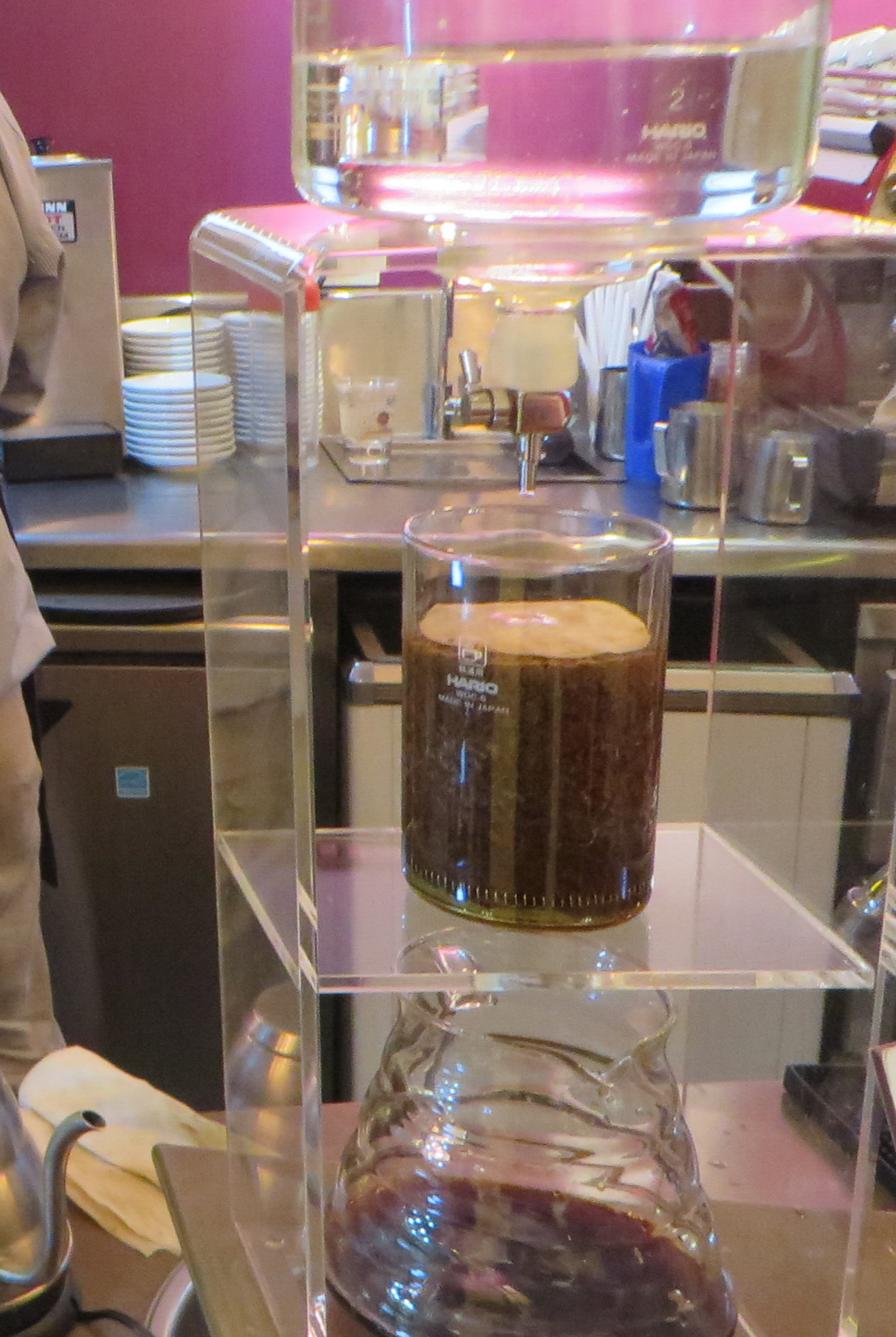
Day 31
14 Feb. 2019
Despite its altitude, Bogotá is surrounded by
green mountains. Whereas in so many other places, deforestation has left hills
and mountains barren, exposing them to erosion, there are lovely sights all
around this megacity of about 9 million inhabitants. On two prominent hilltops
next to each other, there is a statue of Christ on the one, and a monastery on
the other top. The monastery is called Montserrat; it is accessible by cable
train. There had been a cable cabin as well, but that had been closed down last
year, as there was an accident after 25 years without any such problem. Even
inside the city, there is a little national park, though not only with native
trees, but also with Eucalyptus, which is highly estimated as cold remedy.
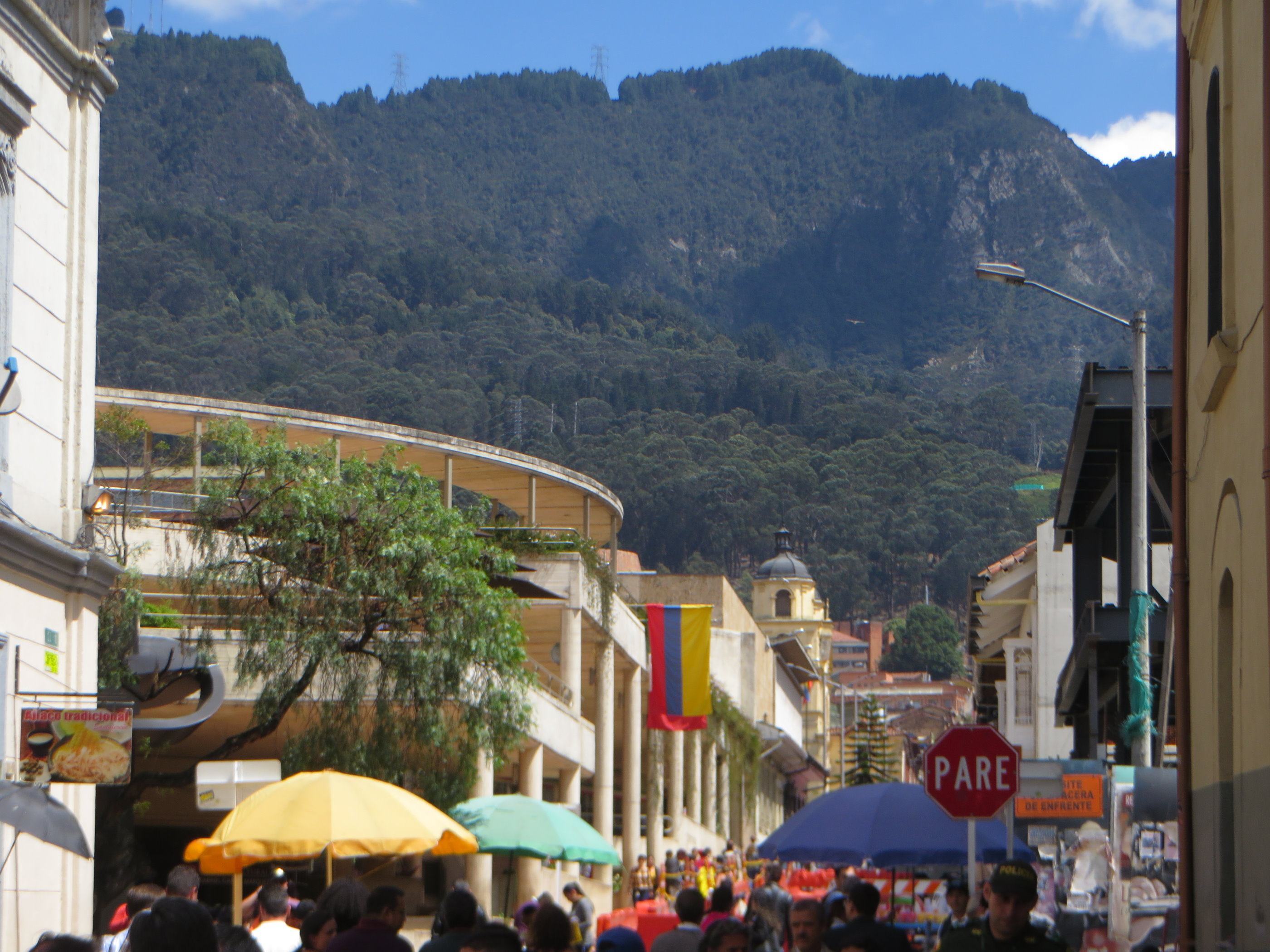
Day 30
13 Feb. 2019
We had to go back to Medellin, as we had to
leave part of our stuff here during our trip to the Chocó. This time, we stayed
in El Poblado, a hilly quarter interspersed with green, some of that along
streams running down in cascades, which certainly do a good job contributing to
the city’s macroclimate, or rather counteracting smog, as the exhaust of some
vehicles seems to go uncontrolled as black fume. Anyway, the integration of
botany into modern life seems to be quite advanced and successful, so that
other cities could – and should – learn from it. Besides providing nice
surroundings, Colombia tries to impress not only foreign visitors now with
increased security. There are armed police and soldiers all over. After decades
of violence, especially committed by drug cartels and guerrilla groups,
Colombia is trying hard to gain back reputation.
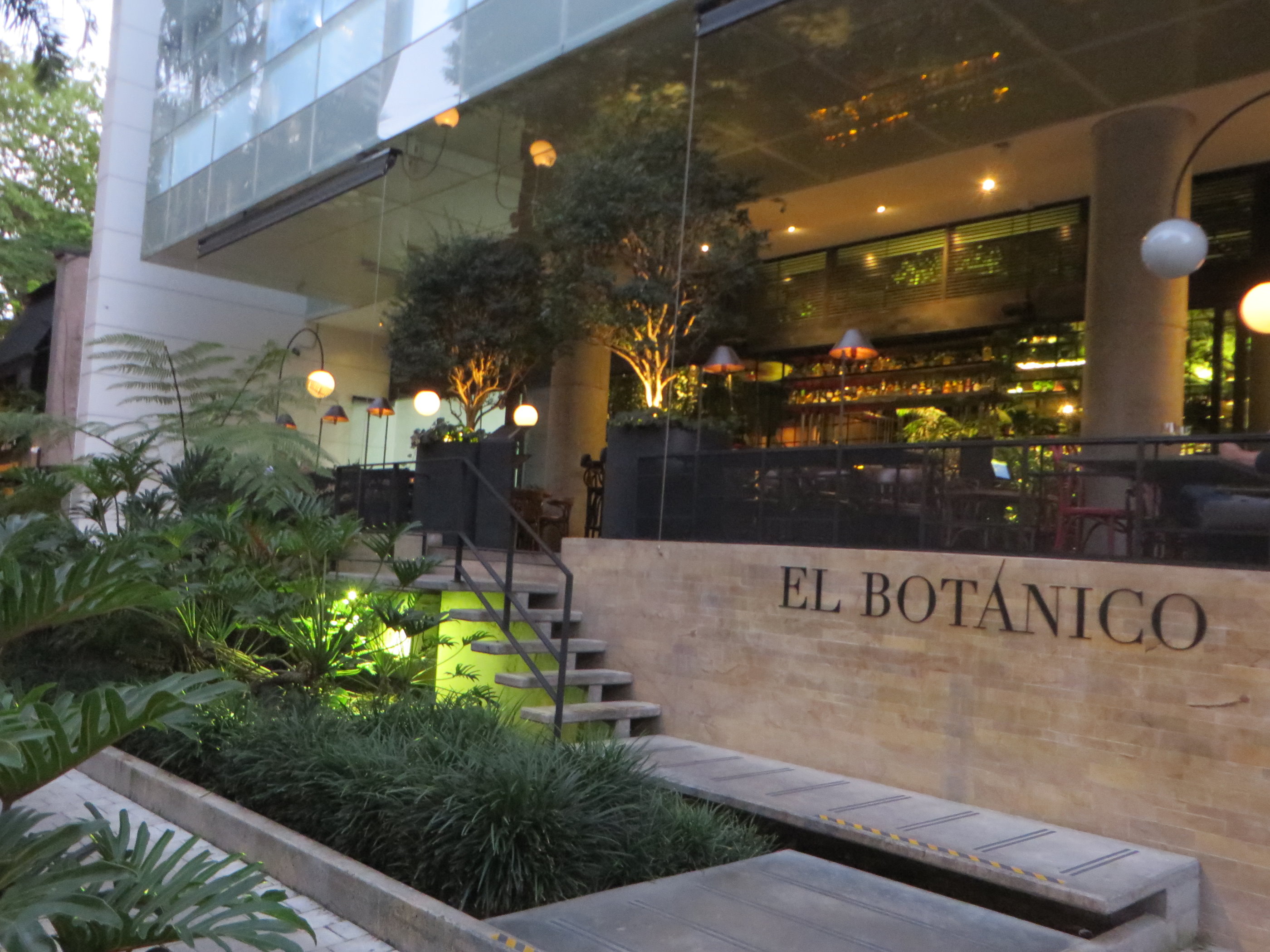
Day 29
12 Feb. 2019
Across the small Airport of Bahia Solano, there is a
small path, between fences, leading away from the road. It would almost go
unnoticed, would it not be signposted. After a few metres, it branches, and we
first took the wrong direction, uphill, but were then told by a local to follow
the river. Well, there was no river at that time, but just an empty bed of
gravel, and even that was curving and splitting around little islands of green.
Then, all of a sudden, there was water running, yet disappearing under the
gravel. As we followed it up, it became a little, gurgling stream with tiny
cascades. We were almost to give up, thinking that was all about falling water,
when, after a few bends and after a small gorge, we found it. The waterfall is
really nice, the water beneath it is crystal-clear, tempting you for a skinny
dip, a most welcome refreshment in this tropical heat.
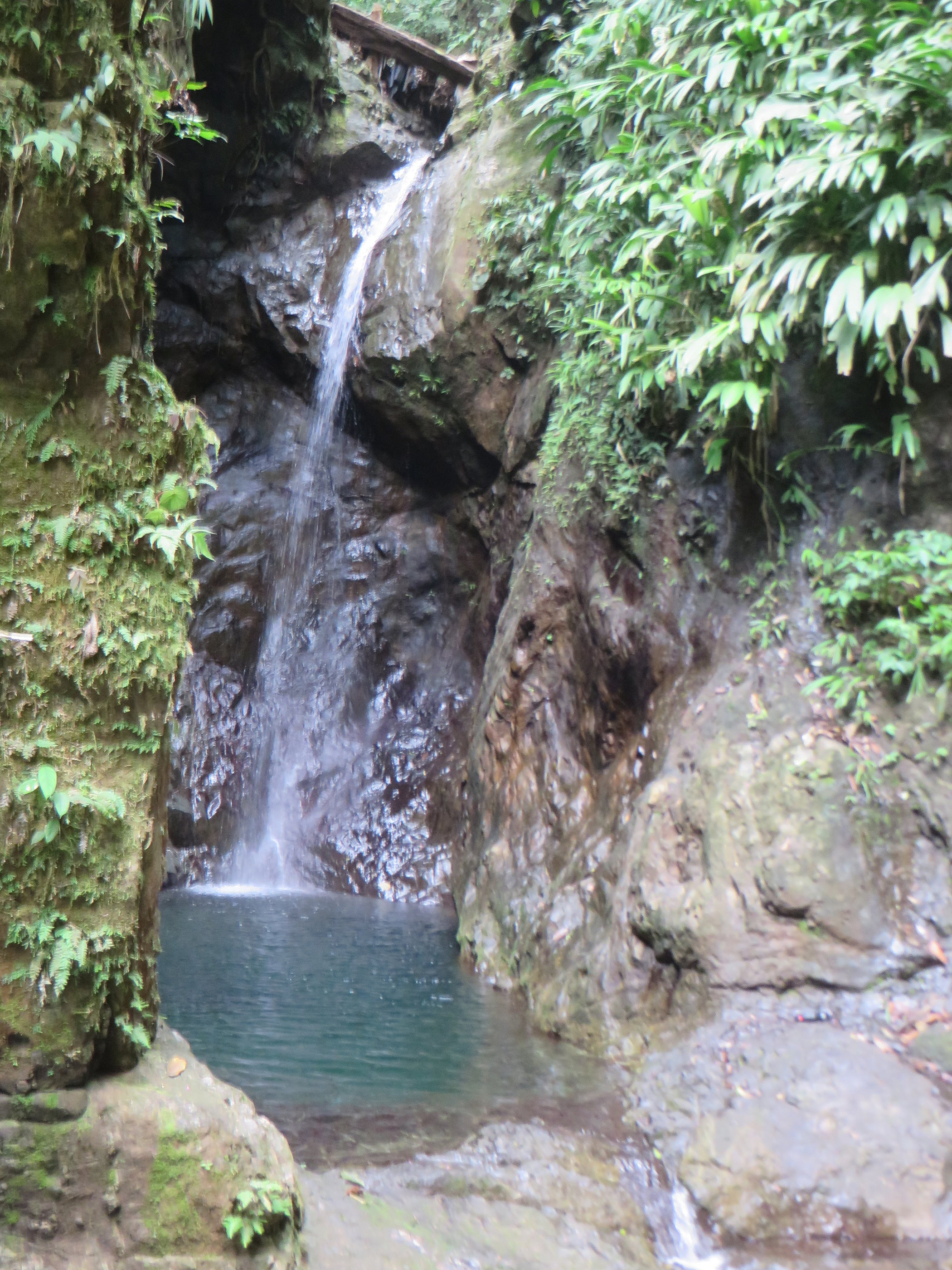
Day 28
11 Feb. 2019
This morning, still in the Emberá village, the
chief was gone to another indigenous meeting. I asked who would be willing to
give a little statement about their problems, be it land issues or those with
Afrocolumbianos, which then could be provided for Survival International. First
they said this could not be done without authorisation from the chief. But the
chief, upon his leave, had installed a vice-chief, who was now in charge by
proxy. So, I asked if he would authorise it, but they still were reluctant. I
think they were scared of consequences following to any criticism. This is very
understandable when we think of the recent incidences (see previous blog
entry). After completing our studies, we went downstream back to the coast, and
after a short stopover in El Valle, took the rough road, in a tuk-tuk, through
some lush green forest, to Bahia Solano. We saw many different kinds of ferns
along that way, as well as so many plants unknown to us, that even that stretch
made clear that the Chocó has one of the highest, if not the highest, density
of species on Earth.

Day 27
10 Feb. 2019
We went to an indigenous Emberá village upstream,
in a dugout canoe. After obtaining consent from the chief, who is called gobernador here, we gave a workshop and
also carried out some studies. I was invited to a meeting of the village people
that was taking place in the evening, where I gave a presentation on the rights
of indigenous peoples according to the UN declaration, as well as on their
brothers and sisters in Panamá, with whom we have been working since 2014, and
on indigenous peoples worldwide. The cultural dominance of globalisation is
quite evident in this village. There is electricity, and there is a school;
both are factors which are very efficient to eradicate indigenous culture. Less
than half of the villagers appeared in somewhat traditional style, most of them
women. Of course, we tried to encourage their cultural self-confidence by
orientating our own appearance towards the traditional style. However, we
noticed a number of differences as compared to the Emberá villages in Panamá.
While there, they have fried bread for breakfast, they semi-crush a cooking
banana here and then fry it. Also, the people are not generally body-painted as
the Emberá and Wounaan are in Panama. Furthermore, they don’t have a toilet
here. Whereas in Panamá, they have simple kinds of toilets, though without
water flush, deliveries have to be done here in the water stream. Not just
going wee, also the bigger business. Due to the streaming water, into which you
are immersed, you are washed clean right away.
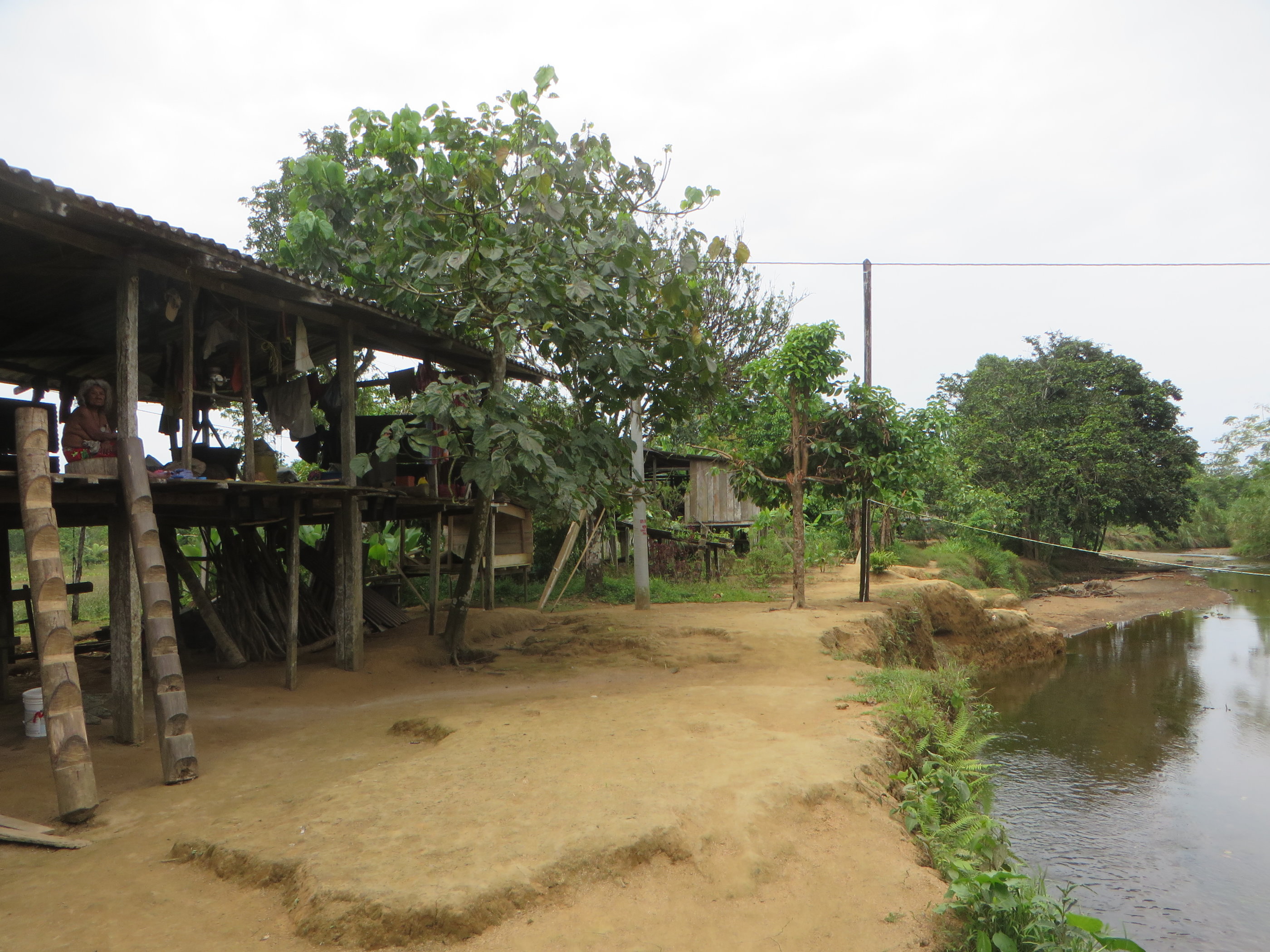
Day 26
9 Feb. 2019
There are some intercultural tensions between
the Afrocolumbianos, who live in the Chocó in large communities, and the
indigenous inhabitants. A few weeks ago, indigenous boys, who were believed to
have committed some shoplifting, were tied to a pole an whipped by Afros. From
a psychological perspective it can be said that this has a very negative impact
on indigenous identity, because by this, nudity is associated with humiliation.
A semi-Afro lady reported to us that the indigenous folks, when they go topless
or carry any culture-specific accessories, are mocked by the blacks. This is
the socio-psychological mechanism of deleting indigenous culture. That kind of
social pressure, by the way, is also at work in the globalised culture, and its
effect is that of standardisation.
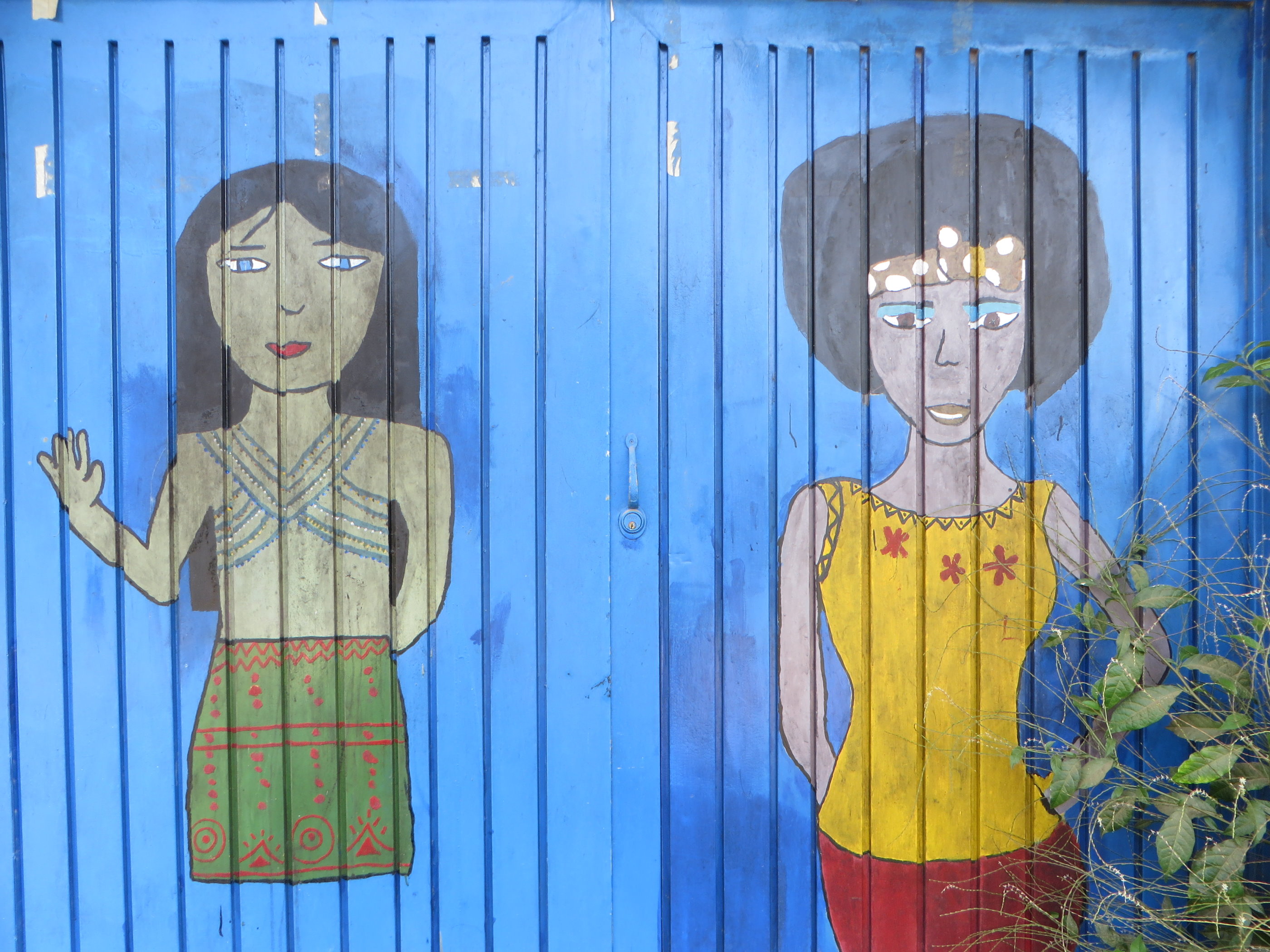
Day 25
8 Feb. 2019
The beach here is wide and open. At first glance, you don’t see much life. But then, when you look down, there are crabs all over, running swiftly sideward from hole to hole. The beach is littered, mostly with driftwood, but unfortunately with plastic, too. At S.A.C.S., we had the idea to use such marine plastic from the Pacific for the production of fog-catching nets that can be used in the initial phase when fog-harvesting trees have been planted (see our Intervention Projects site). Here in El Valle, those who own plots at the beach are responsible by law for keeping that stretch clean. So, they collect the wood every one and then and burn it. I think this is not very useful, as the wood itself is a carbon sink, and burning it means to just take precious oxygen from the air and couple it with carbon, thereby producing CO2. If it would be shredded, it could fertilise degraded land, or if at least charcoal would be made from it, then the logging of living trees for the purpose of charcoal would be prevented. Regarding the collected plastic, people don’t know what to do with it, as we heard.
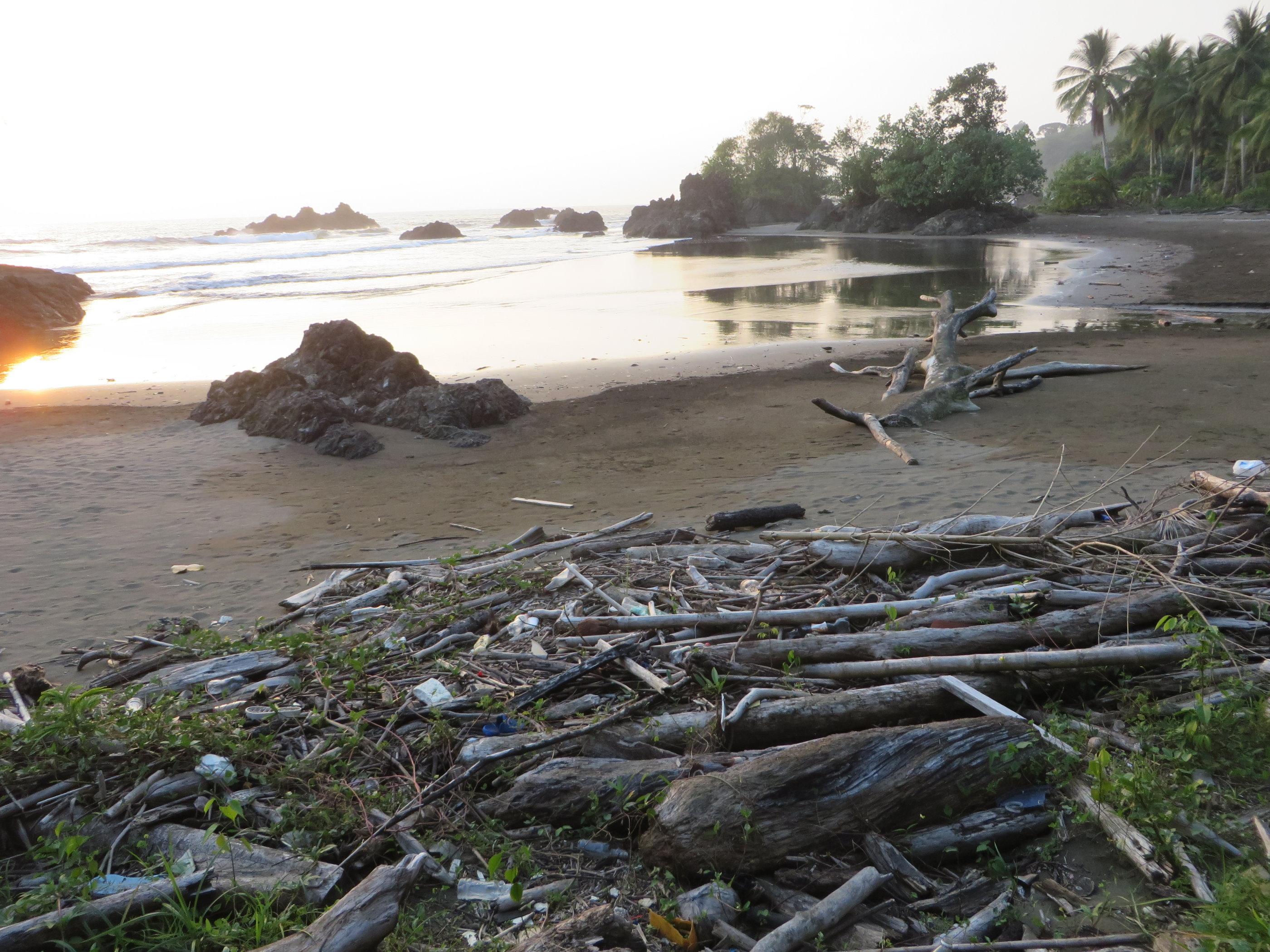
Day 24
7 Feb. 2019
I have never seen so many pelicans at once. Here, at El Valle beach of Chocó, you see them mostly fly in large formations. They fly over the water or over the beach, mostly along the coastline. Either in line or in V- or 1-shape, steady and calm. From the beach, these pelicans can hardly be spotted at other activities. They usually don’t flock around on any of those numerous rocks. Only once, I saw them landing on at tree, almost at the edge of the immense green that stretches inland. I think it was in Cairns that I saw them squatting what seemed to be their sleeping tree. Over her, though, that might just as well have been a stopover only. For fishing, they apparently fly far out to the open sea.
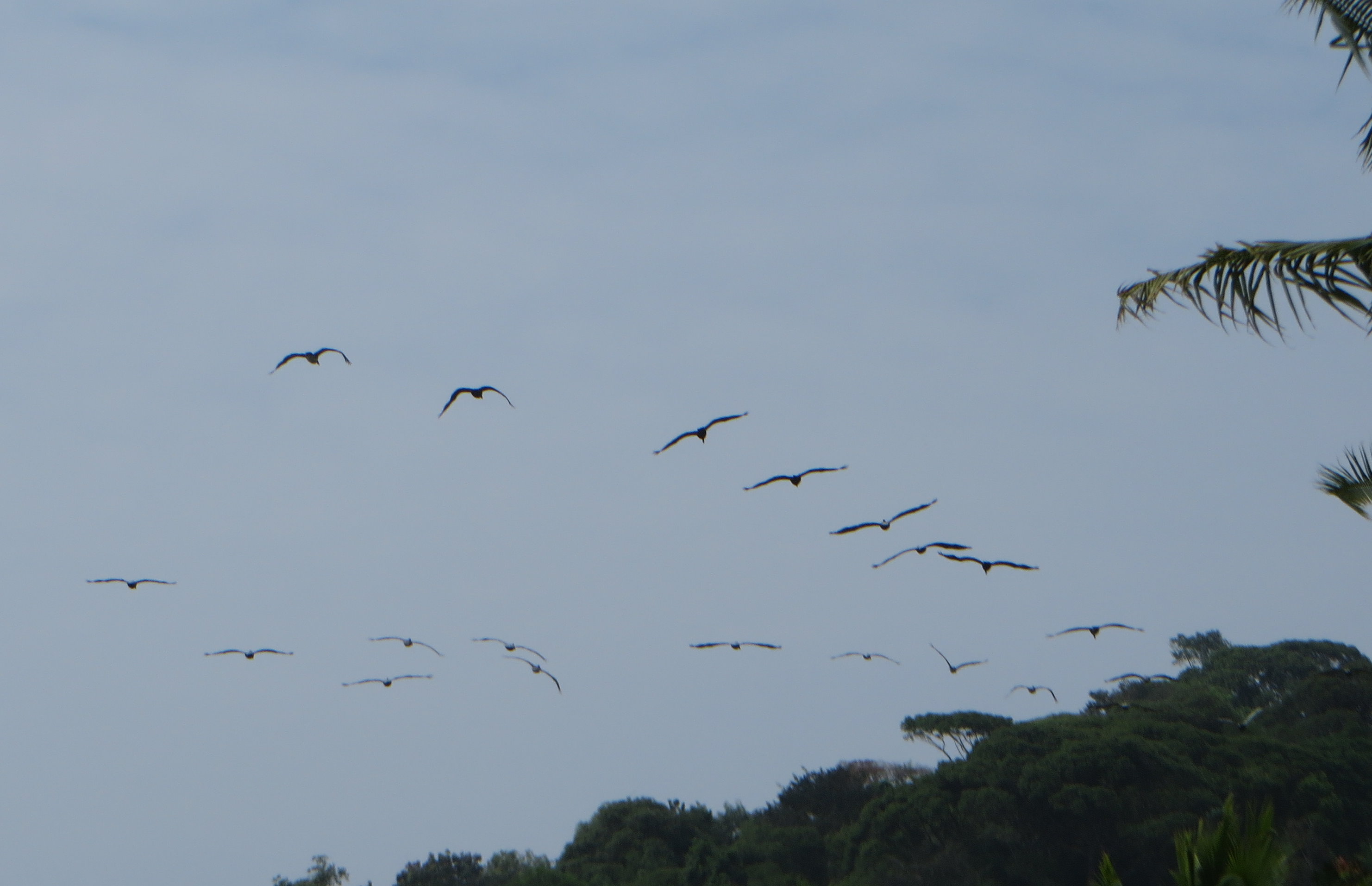
Day 23
6 Feb. 2019
The wax palm, palma de cera (Ceroxylon quindiuense) is native to the humid Colombian highlands. It is the wold’s tallest palm tree, as it can reach a hight of 60 m, if it makes it to an old age. The stem is slim and whitish, the top with its fronds is almost spherical. In former times, candles were made from the resine, hence the name. On the way from Perreira to Medellin, we saw quite a number of them today. In their natural environment, they start to grow in the undergrowth of the forest. The more or less solitary wax palms that one can see today are often leftovers after the woods have been cleared to make room for farming grounds. But when the underbrush and the shady forest are gone, the seeds have hardly a chance to make it up to a tree, the more so as the cattle eat the germlings. Without intervention, this palm would therefore be doomed to extinction. Luckily, Columbia has decided to declare it their national tree. It is now raised artificially and planted on haciendas and other places.
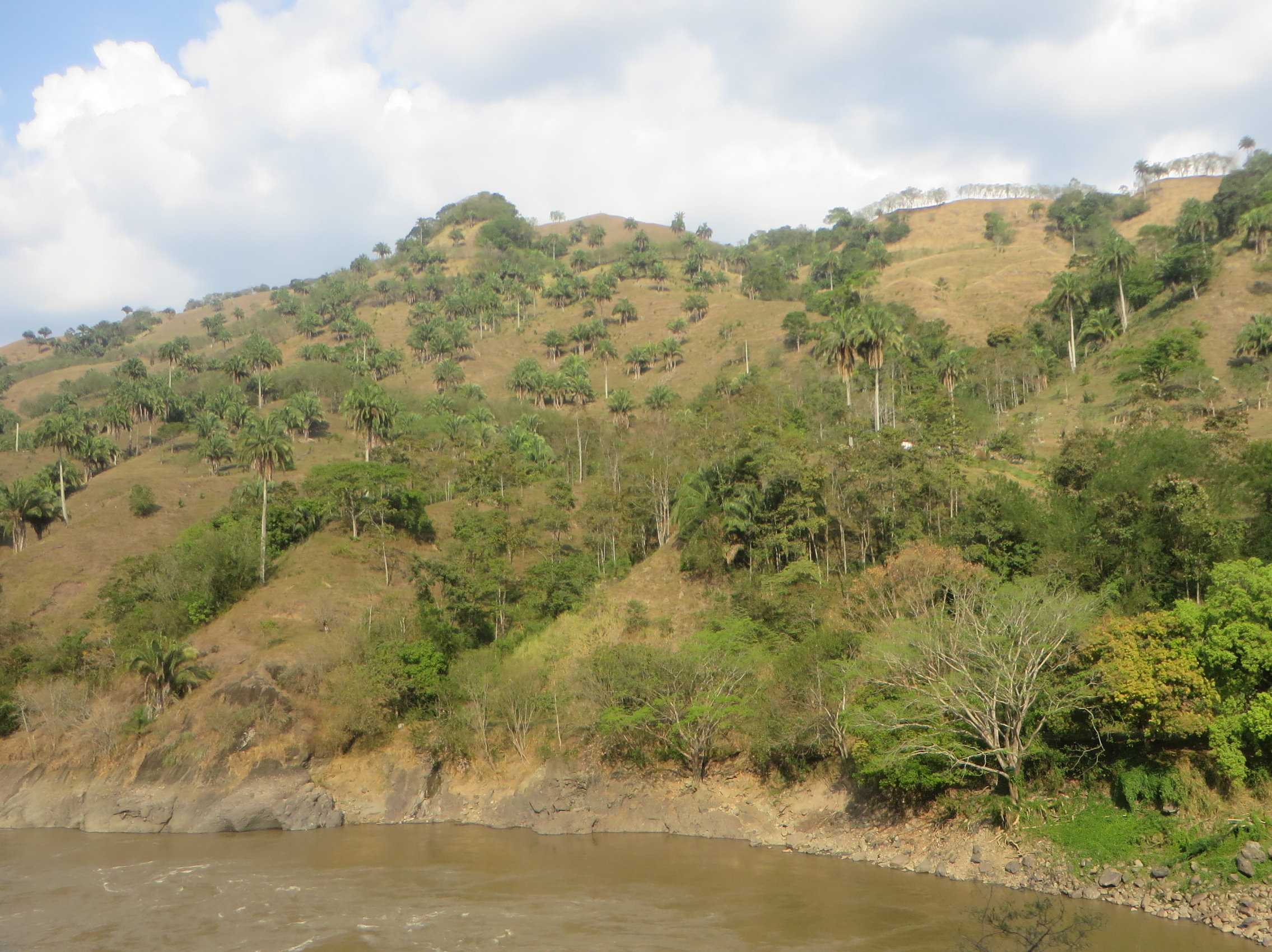
Day 22
5 Feb. 2019
What at first sight seem to be just bushy hills in the vicinity of Perreira are, upon a closer look, coffee plantations. Colombia is the third-largest coffee producer in the world, concentrating on Arabica. We just happened to meet one of the coffee importers for Holland, who told us that it is difficult to find real organic coffee, as it is common that the farmers dedicate a relatively little plot to organic coffee to once obtain the licence and then carry on by certifying coffee as organic which really isn’t. Interestingly, there are banana trees planted between the coffee plants; alledgedly, the bananas are there for the coffee pickers, so that they can have them during their breaks.
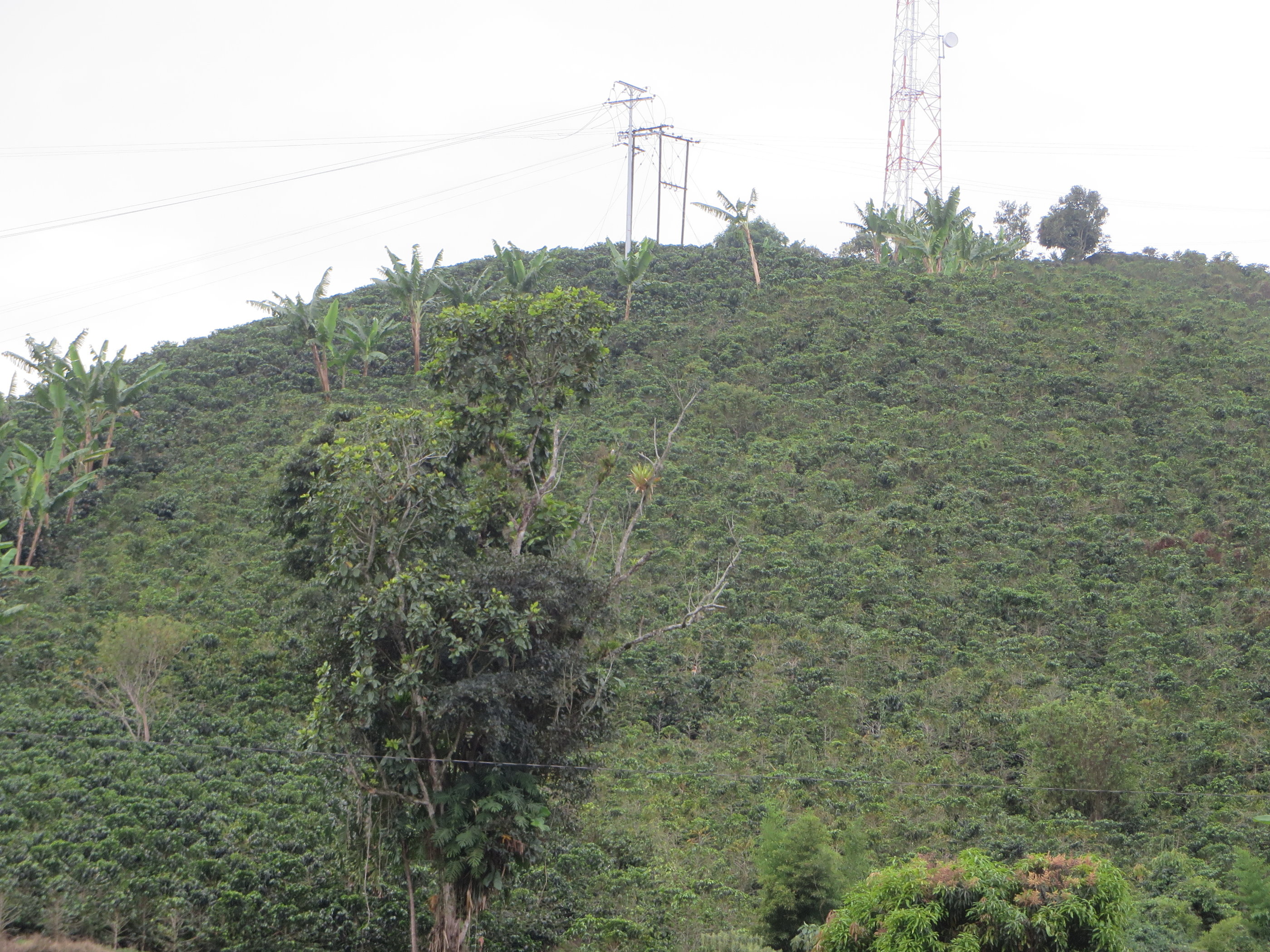
Day 21
4 Feb. 2019
When people migrate, they have a tendency to settle down in places that resemble their regions of origin in terms of climate and landscape. And once they have settled down, they often adapt that new environment to what they used to have before by modifying particular characteristics. Even in tropical regions, near the equator, people of European descent have concentrated in areas of hight altitude, where the climate is closer to that of Europe. Consequently, large cities like Medellin, where we still are right now, or Bogotá, or La Paz in Bolivia, are situated in the highlands. Instead of integrating into the already existing cultures, the immigrants have designed these places to an extent that they do not quite differ from Europe anymore.
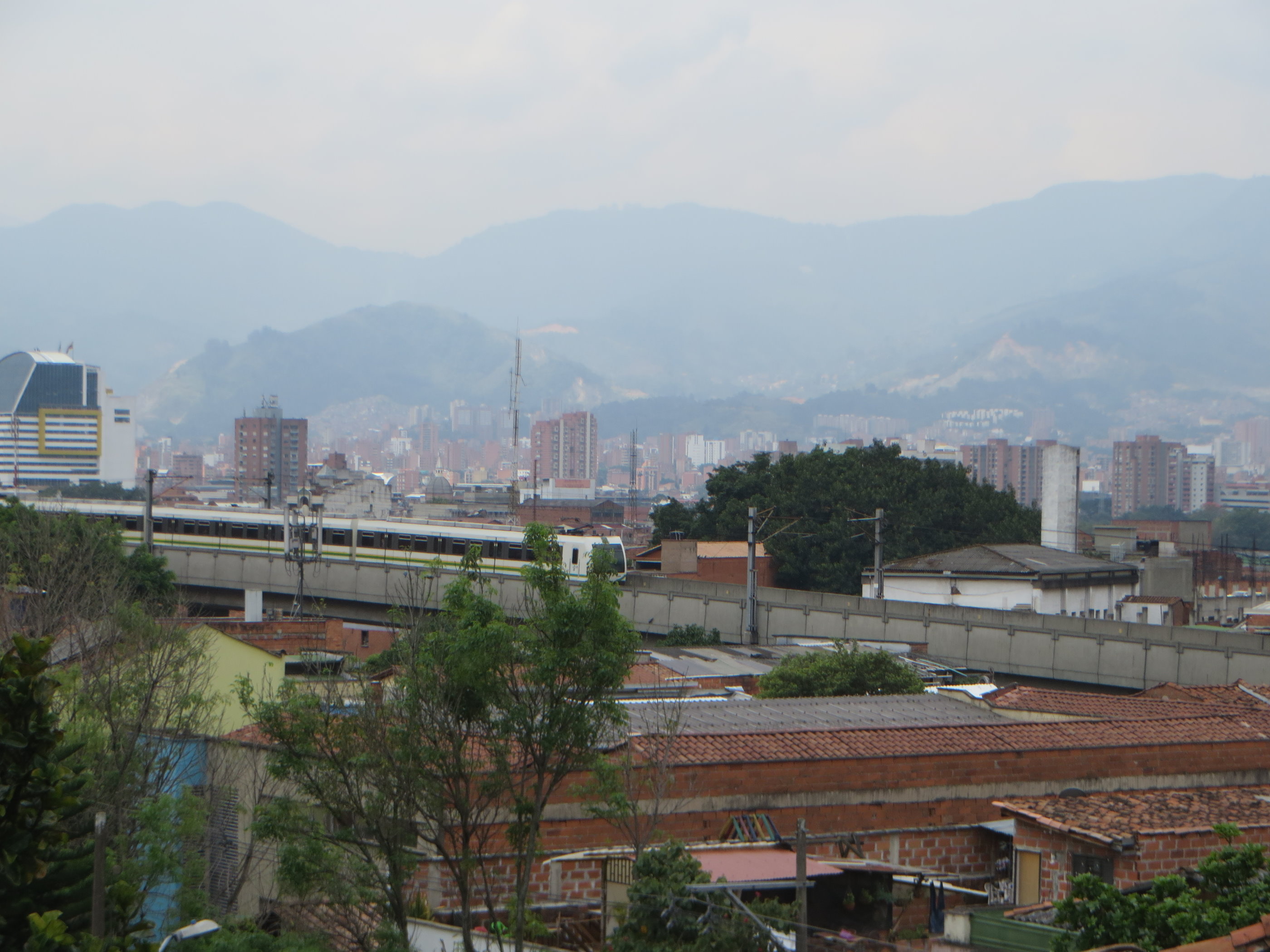
Day 20
3 Feb. 2019
Medellin’s Parque de Las Luces is one of the city council’s several attempts of transforming the hitherto rather problematic image towards one of modernity and progress. A symbol for that has been electric light ever since the 1920s appraisals of big cities, as they are preserved in early b/w films and that time’s contemporary art. Parque de Las Luces, situated next to the modern architecture of Biblioteca EPM, was opened in 2005. It consists of four arrangements of poles that are 20 m high and which contain light-bands. The arrangements are separated by a central alley and by two clusters of bamboo. Starting at 6 p.m. sharp, the four groups of poles are illuminated one after the other, so that at 6:30, all four are shining. However, this symbol of modernity and progress contrasts sharply with reality. Medellin is full of beggars and homeless people, who sleep on the bare ground of the streets. Many of them are scarred by drug consumption. Like in many parts of the city, it is recommended not to walk outside in the dark around the park. Yet, watching the illumination from the library front seems pretty safe, as that is patrolled by a security guard with his dog.
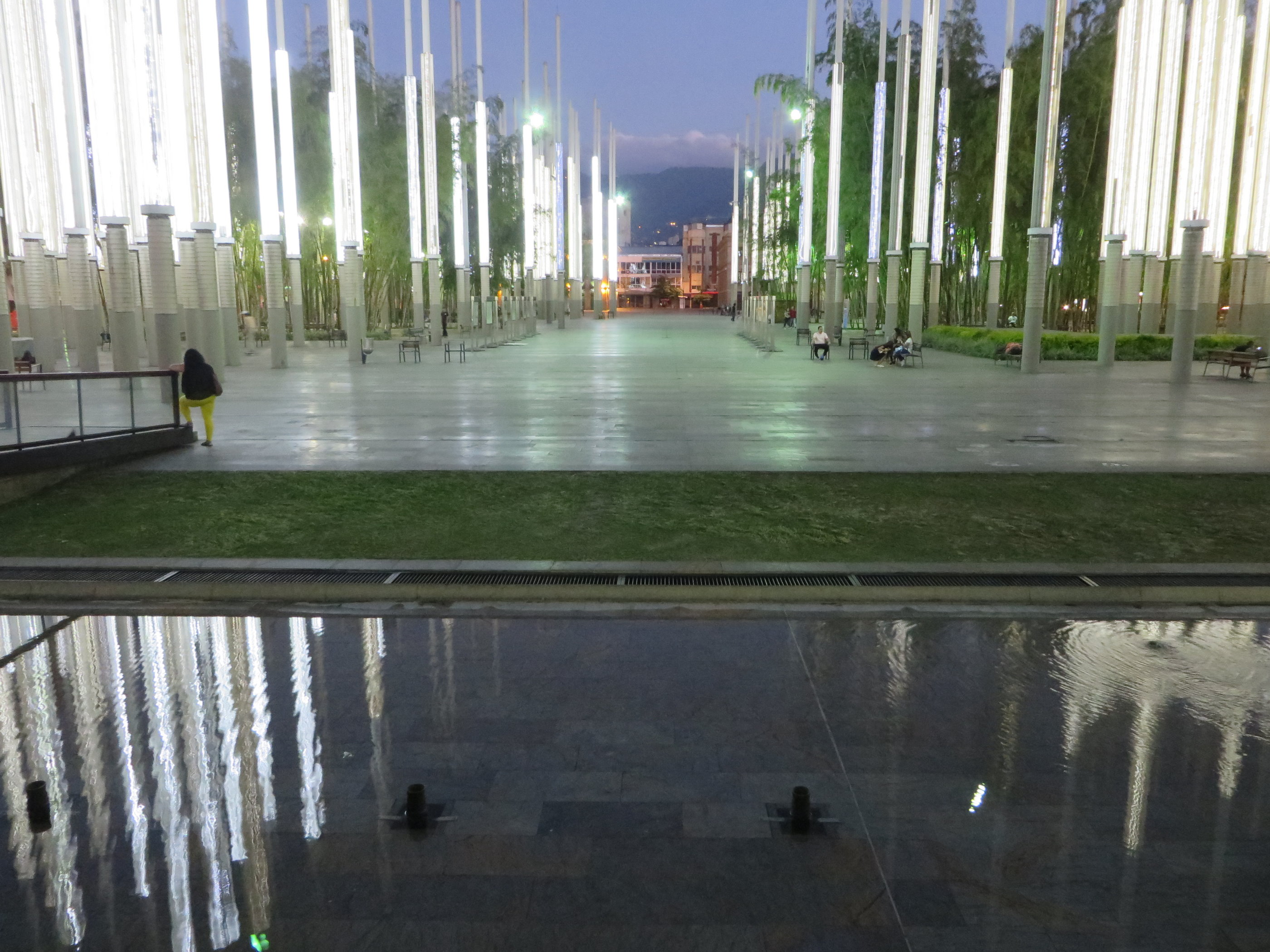
Day 19
2 Feb. 2019
Comuna 13 used to be the most problematic quarter of Medellin. It attracted Colombians, who had fled from the north-west of the country to escape violence. Since many of the housings were established illegally in Comuna 13, the police expelled those unregistered settlers. But they kept coming back, and after the third time of unsuccessfully expelling them, the police gave up and did not even dare to go into that quarter anymore. Comuna 13 became a hub for drug trafficking and a hiding place for guerillas, who made friends with the inhabitants by stealing goods elsewhere and distribute them to the people. There were a number of military operations against the guerillas from 1998 to 2002, until finaly, with „Operation Orion“, in which a tank and two helicopters were fielded, the military gained the upper hand. To finally clear it from anyone who further sympathised with the guerillas, paramilitary was employed, in in consequence, more than 140 people have disappeared and are believed to be dead. There is a memory wall with coloured canisters, containing plants and inscriptions by the families of the dead and missing. In the process of „transformación“, the government has built a library with internet access to keep the kids occupied, a road, and a line of escalators up the steep hillside to incorporate the inhabitants in civil life.
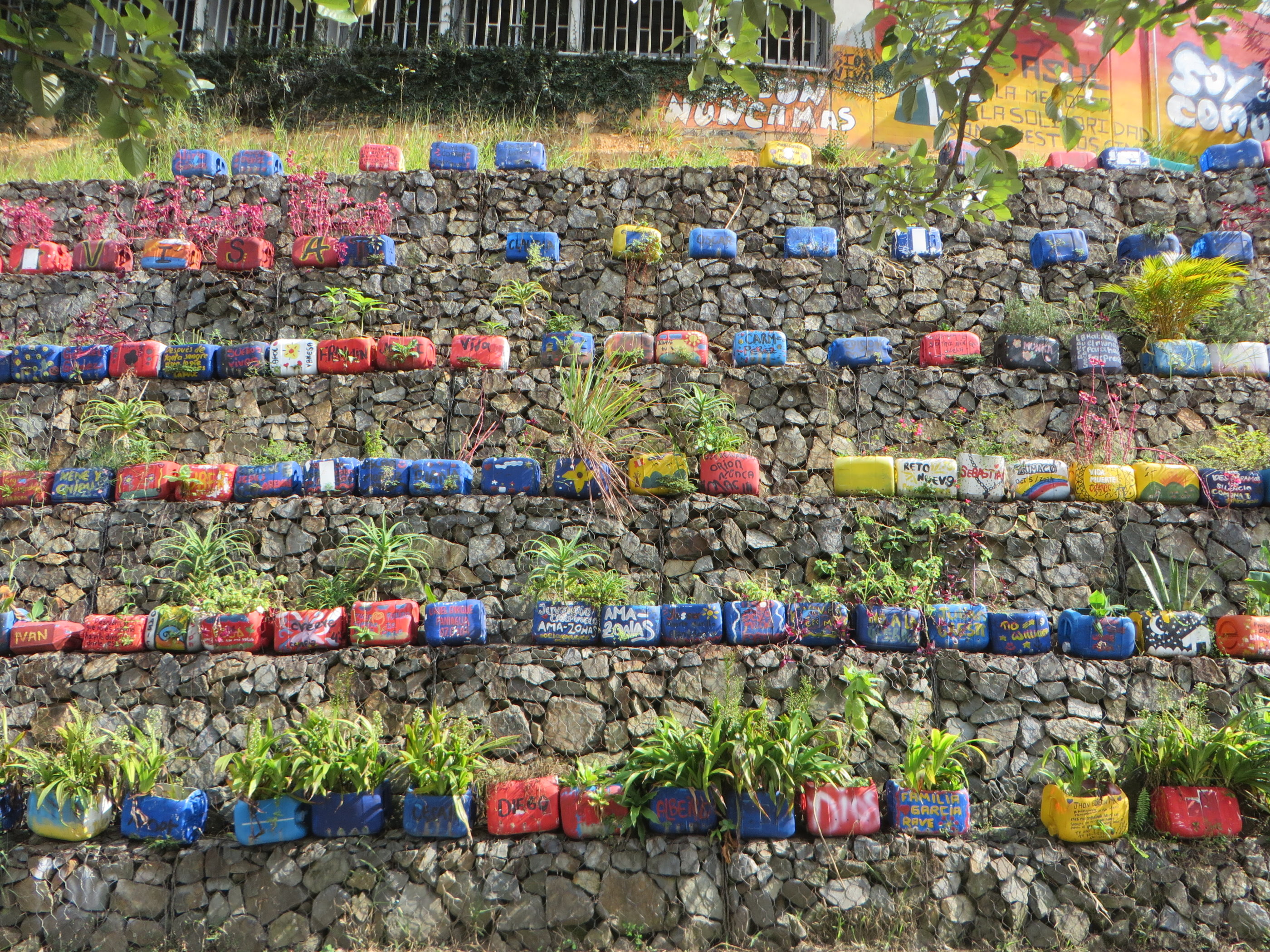
Day 18
1 Feb. 2019
The drug baron, politician and member of congress, Pablo Escobar, also reputed as criminal, terrorist and mass murderer, had a number of exotic animals brought to his Hacienda Nápoles, among them four hippopotamuses. After Pablo, as he is simply called in his hometown, was shot in 1993, the hacienda was confiscated and the animals sold, except for the hippos. They multiplied, and some of them escaped. Meanwhile, the population is estimated to be about 50. Some of them have already reached Rio Magdalena. The issue is a matter of controverse discussion. On the one hand, hippos are the deadliest land mammals of the world. When we once were in Rwanda, there were some casualties, for example two persons who were killed when a hippo bit through their inflatable dinghy, and I remember that an Italian barely escaped being bitten through by jumping into his car. On the other hand, there have been no such reports in Colombia so far. Those in favour of the invasive species say that these were filling a niche left blank by extinct large animals. Today, we saw at least ten hippos at the Hacienda Nápoles. When we walked past the bushes along the lakeside, we heard two more grunt from that direction, and we were actually happy not to meet them directly on land. The guides told us that those hippos outside the hacienda only come out at night and hide during the day. By the way, one of the guides proudly presented us his smartphone wallpaper, taken one month ago and showing him together with Pablo’s son.
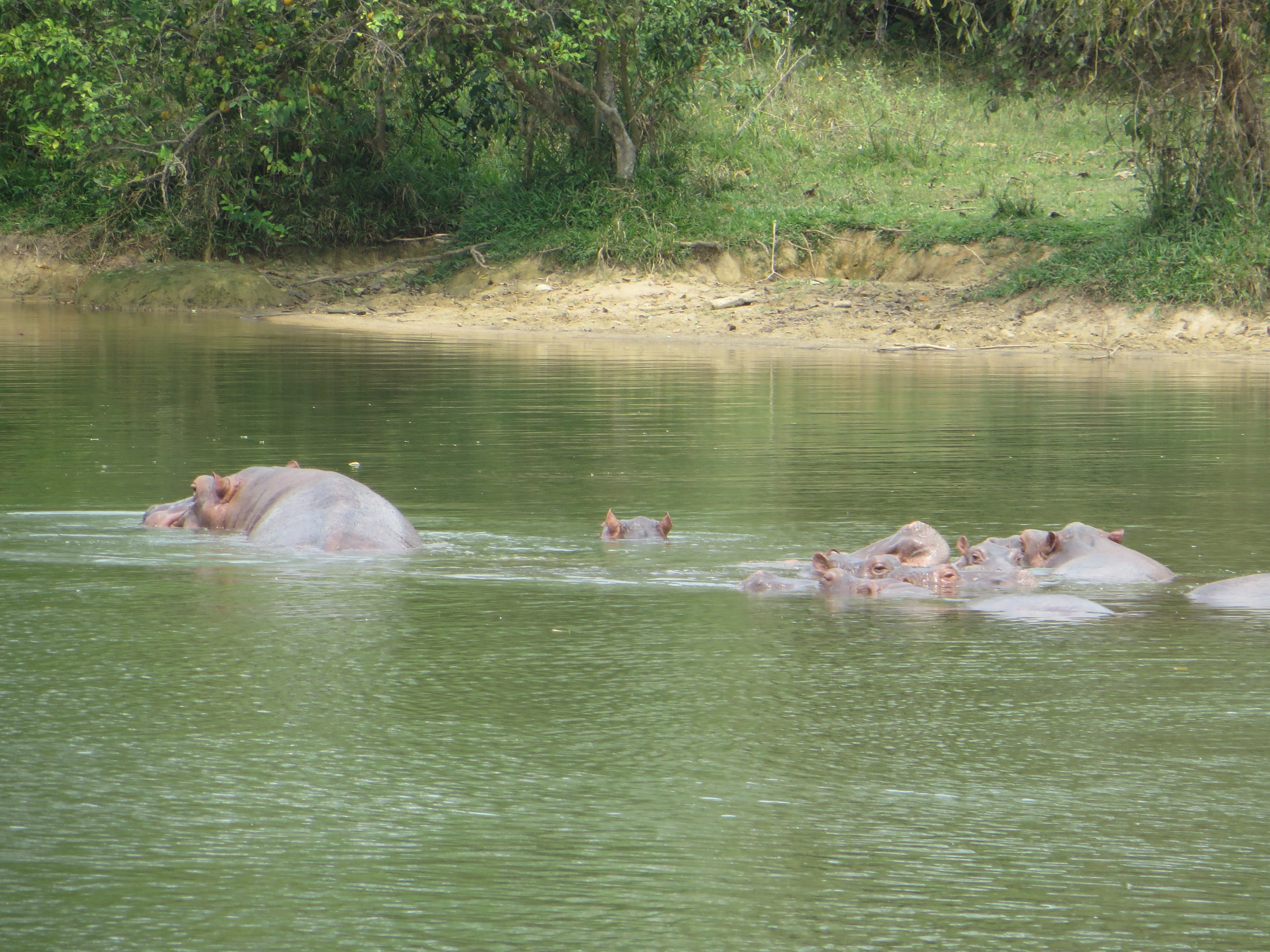
Day 17
31 Jan. 2019
On the way from Bucaramanga to Barrancabermeja, there is a dam with an enormous reservoir, filled with the waters of Rio Sogamoso. Dams, in general, are a two-faced issue. Which of the faces prevails depends on the location of the dam. The cons are given by the fact that by the flooding of an area, plants and animals are eliminated. When people are living in that area, they will be displaced, and if these are indigenous communities, it is likely that this will be detrimental, if not fatal, to their culture. The probably worst of the present dam cases is Belo Monte in neighbouring Brazil. As there was not even a river to fill the reservoir where the dam has been built, it was decided to divert the Rio Xingú for that purpose. The Xingú area is one of the world’s indigenous hotspots, with 13 different peoples living there. The diversion of the dam will cause devastation of the ecosystem, so that the indigenous inhabitants will be forced to leave their homelands in order to survive, abandon their traditional lifestyle and try to find jobs in the new factories around the hydroelectric power plant. In the case of the Sogamoso dam, it might be cynically remarked that indigenous cultures have been extinct from that part of central Colombia, anyway. With regard to nature, it can be said that principally, the more arid a region is, the less species can be expeted to be affected. Yet, there are some pros of dams as well, as hydroelectricity is renewable energy. The problem is that electricity cannot be sent for unlimited distances through cables. After each kilometre, some electricity is lost. However, the vast amount of electricity produced at the dam itself can be used right there. Nowadays, there are technical solutions available to convert biomass into fuel, even into kerosine. It only needs huge amounts of electricity to do that. Therefore, that technology is very costly. Yet, locating it right next to hydroelectric power plants would make it feasible. So, here is a real alternative to fossil fuels, which would enable us to continue to use the meanwhile highly efficient engines of cars and planes with biofuels in a cyclical way (as only that is blown into the air what plants are taking up) instead of expanding the rather problematic battery industry for electro vehicles.
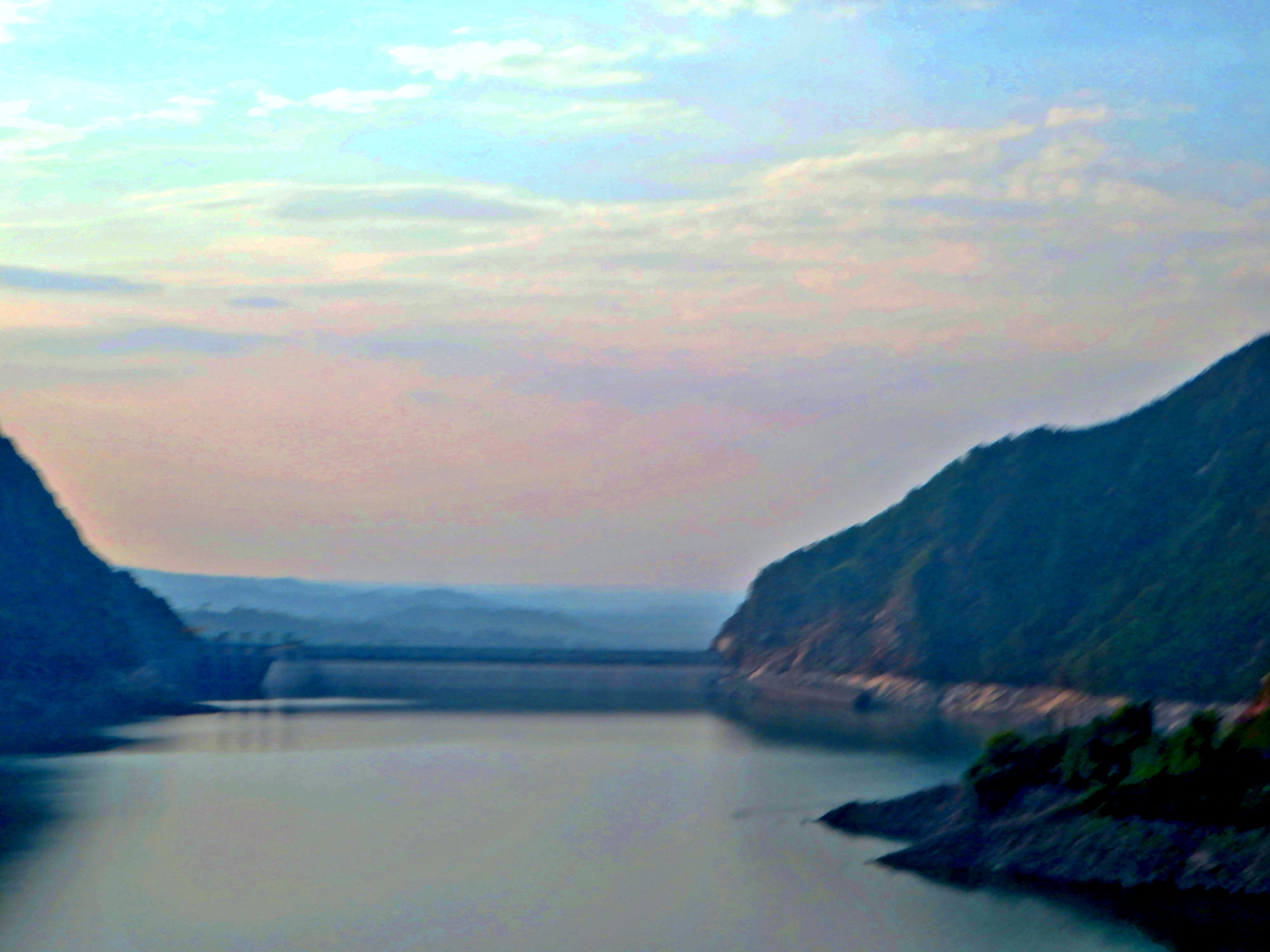
Day 16
30 Jan. 2019
There is a museum in the Parque Nacional de Chicamocha, dedicated to the Guanes, a people that lived in what is now central Colombia, at the time of the Spanish invasion. What struck my eyes right away was a pattern of the ceramic decoration, which looks like one that is typical for the Guanches, who were the inhabitants of the Canary Islands, and who also fell victim to the Spaniards. There is an anthropological theory according to which the Guanches belong to the Phalian type. These groups also settled in central Europe, and anyone, who is familiar with native Westphalians, will see the similarities with the descendants of Guanches that still live in a few places of the Canary Islands. When I learned today that the Guanes were very light-skinned and had European features, that struck me next. The proper name of the Guanches is seen , in linguistic terms, as being in connection with an Indo-European root, of which the Latin word gens, „people“, is also derived. It is typical that the speakers of an indigenous group call themselves simply „people“ or „humans“. Knowledge about the Guanes‘ language has been lost, and therefore, it does not make much sense to look for similarities of the term Guane in other indigenous languages. Most likely, it also meant something like „people“, „human“ or the like. But besides the phonetical similarity of the names, that semantic aspect would add to the Guanes‘ similarity to the Guanches. The archaeological finds related to the Guanes are dated from 10th to 16th century A.D. Then, that people ceased to exist. It is said that they died from diseases imported by the Conquistadores, and that those, who survived, intermarried easily with the Spanish due to their European appearance. Since there are Guane burial sites, future genetic investigation might perhaps enable comparative research with the Guanches. This would not be the first indication that there had been separate cases of pre-Columbian immigration to the Americas.
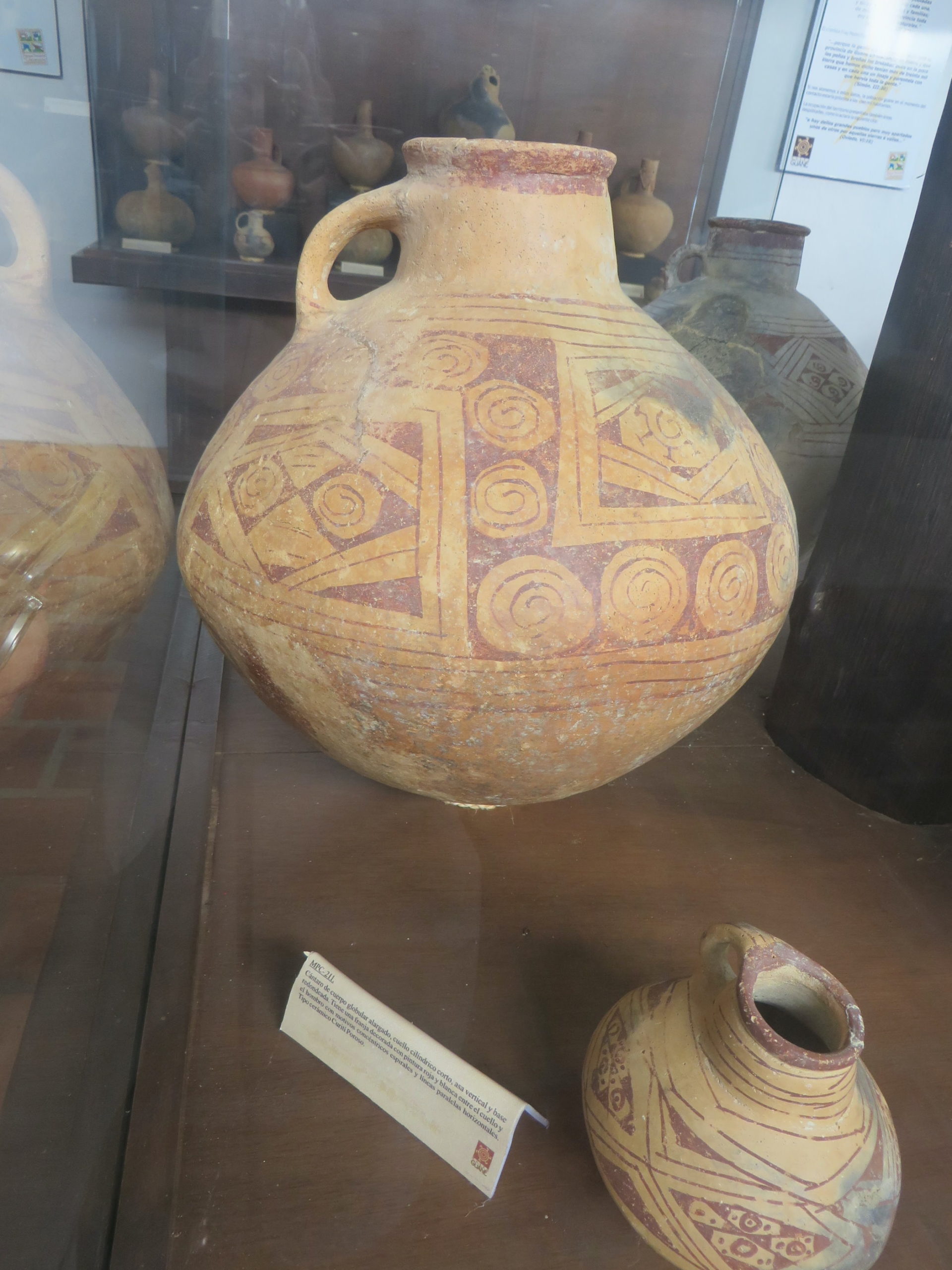
Day 15
29 Jan. 2019
In Bucaramanga and its surroundings, various graffiti call for a stop of mining. Indeed, the new political situation, which promises a bright future for Colombia, brings about some scaring side effects, especially for indigenous peoples, as well as for the environment. During the past years, many areas of the country were not accessible due to the activities of rebel groups. Concretely, this meant that a number of indigenous proples were left more or less uncontacted, and that mineral resources were left untouched. Now, with the new peace, all that might change. So far, there are vast areas of the country that have not been opened up by infrastructure. It can be expected that greed will prevail, although we should be grateful for each atom of carbon that is deposited either in fossil fuel or in biomass, as from all those C atoms, O2 has been split off by photosynthesis, so that it is now free and available for us as oxygen. Burning it means to dock O2 again to each of these C atoms, thus producing CO2, which can only be split into C and O2 again by photosynthesis. As long as we use renewable resources and really take care of their renewal, this is fine. But burning fossil fuels is just irrational. Therefore, indigenous peoples have a good reason to stand up against mining. There are huge unexploited petrol and coal deposits in Colombia, and in addition to those, fracking is threatening indigenous peoples. Even the UN Declaration on the Rights of Indigenous Peoples is somewhat helpless in this situation, as it can be applied as a tool to abuse the indigenous peoples by involving them as partakers. Duplicitously distributing their share will be the end of their culture, the end of their natural ecosystem – and another coffin nail for humankid.
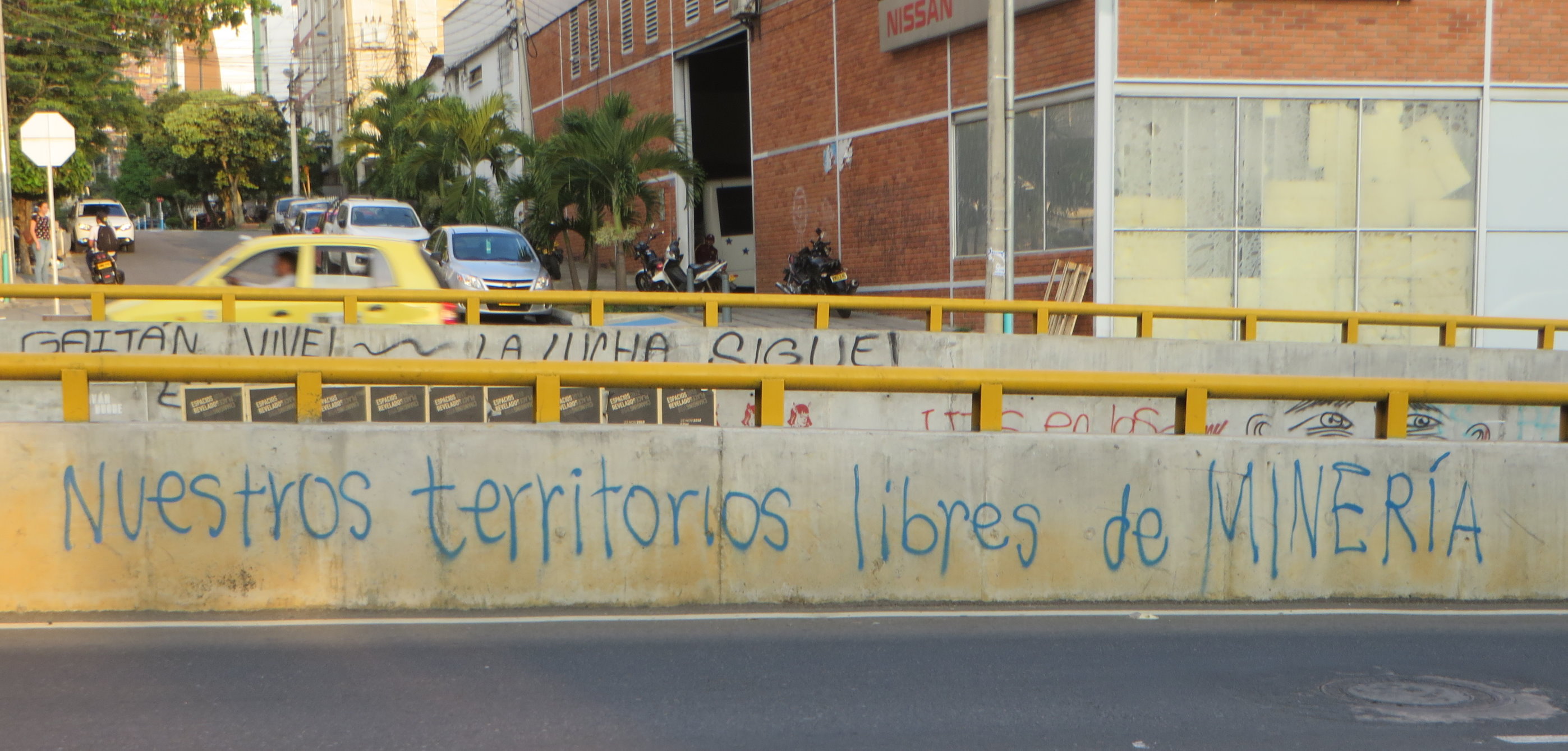
Day 14
28 Jan. 2019
Today, we went up the Rio Magdalena by boat from El Banco to Barrancabermeja. We saw thousands of birds, some in flocks, others in schools, flying in line, some flying single just at the surface, leaving double lines on the water from their flaps, and again others lined up along the shore like guards, in more or less equal distances of 50 m or so. Colombia is considered to have the world’s greatest bird diversity. Rio Magdalena is not just a river flowing in its bed. It is branched into many distributaries, and even these are huge, large and wide, forming a network with islands and sandbanks in between, on which there are temporary huts and thatched shelters here and there, presumably of fishermen. We also saw a few traditional huts of what might be indigenous dwellings. One reason for the river’s meandering is erosion. Once the primary forest is destroyed, the banks become unstable, as there are no more roots to keep the soil. Almost all along the way, we saw the edges being underwashed and breaking away. There are trees drifting in the water with their roots rearing up, there are also trees, lying in shallow water along the riverside, that have just fallen down. Others are tilting and about to fall, and then there are those of which the root system is already visible like in a cross-section. Morituri te salutant.
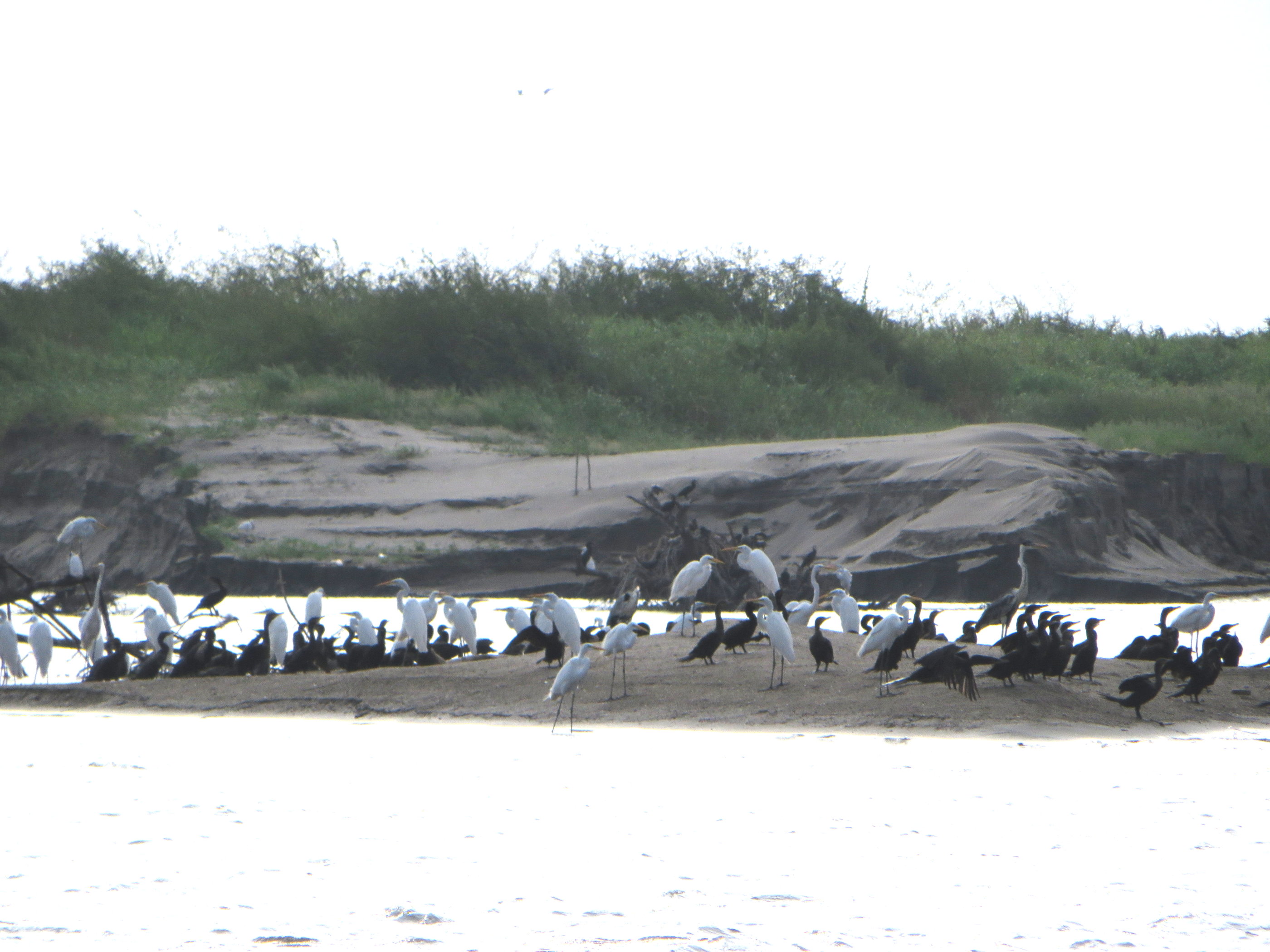
Day 13
27 Jan. 2019
There is a sleeping beauty in Mompox. The Botanical Garden is not maintained anymore. It still does exist, and hopefully, it will not be torn down, as it has been sold to a new owner. There is no more official entrance, and some people are living now at its edges. From outside, you would hardly know there is a Botanical Garden; you have to know in advance about it and then find a way to enter it . Other than the abandoned theatre, it is not just deteriorationg. Rather, it is becoming a piece of wild, untamed nature, right inside the town, surrounded by streets, walls and people’s plots. It is one of Mompox’s potentials that just needs to be unfolded.
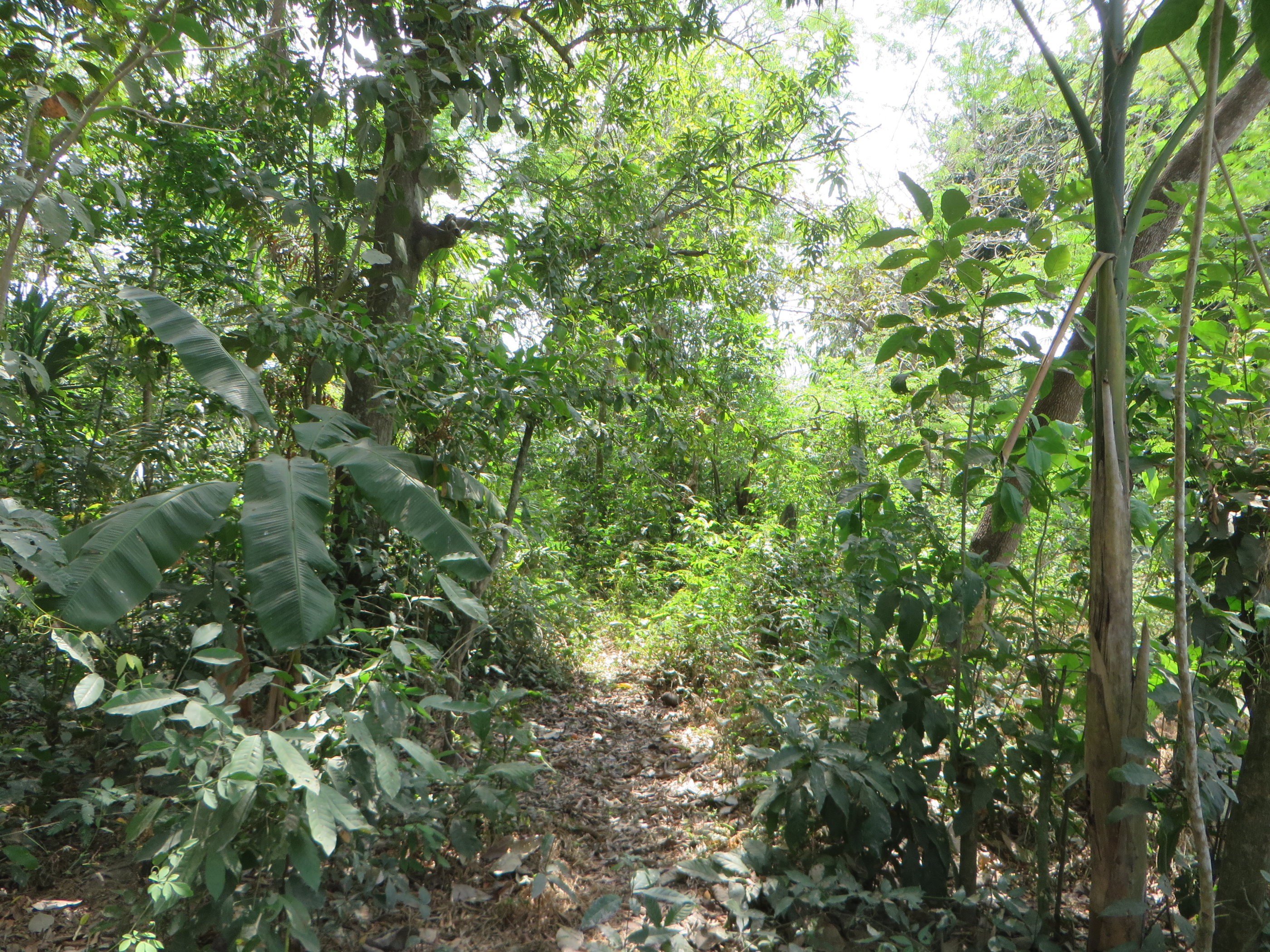
Day 12
26 Jan. 2019
Today we came across a really strange place. The Teatro Colonial in Mompox has been closed down decades ago. The front is still there, and we saw someone entering the door. Another person, who passed by, ensured us that we could visit the inside, so we knocked at the door. It was guarded by a dog, and a lady, who opened, told us to wait for a moment, because the dog had to be brought away. Apparently, it would not have let us pass. Then, we could enter and found the bizarre remains of the grand old theatre. There was no more roof, but the seats were still there, although all upholstery was gone. In the rear part, which was sheltered by still existing architectural structure, some people lived with their few belongings. A peculiar scene of deterioration and crumbling walls. Sic transit gloria mundi.
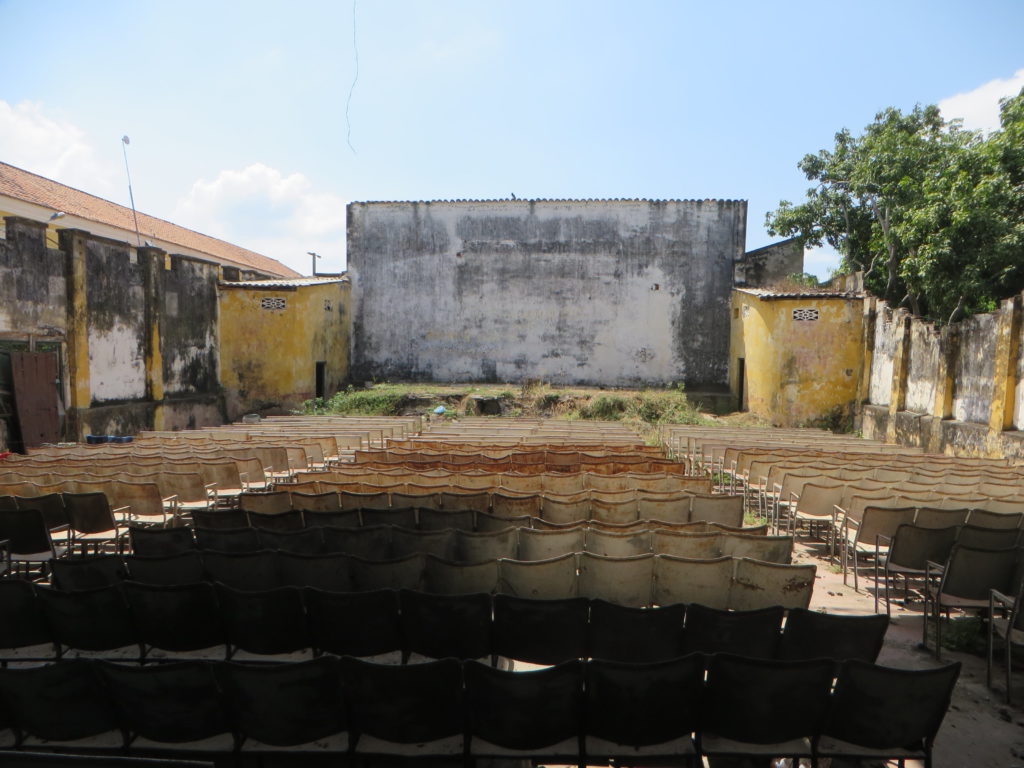
Day 11
25 Jan. 2019
On the way to Mompox we stopped over at a service area, where they had nozzles, which were installed along the edge of the projecting roof. These nozzles were spraying mist every minute or so. Since the weather was extremely hot and the sun very intense, this was really pleasant. A nice idea and perhaps a good example for future architecture.
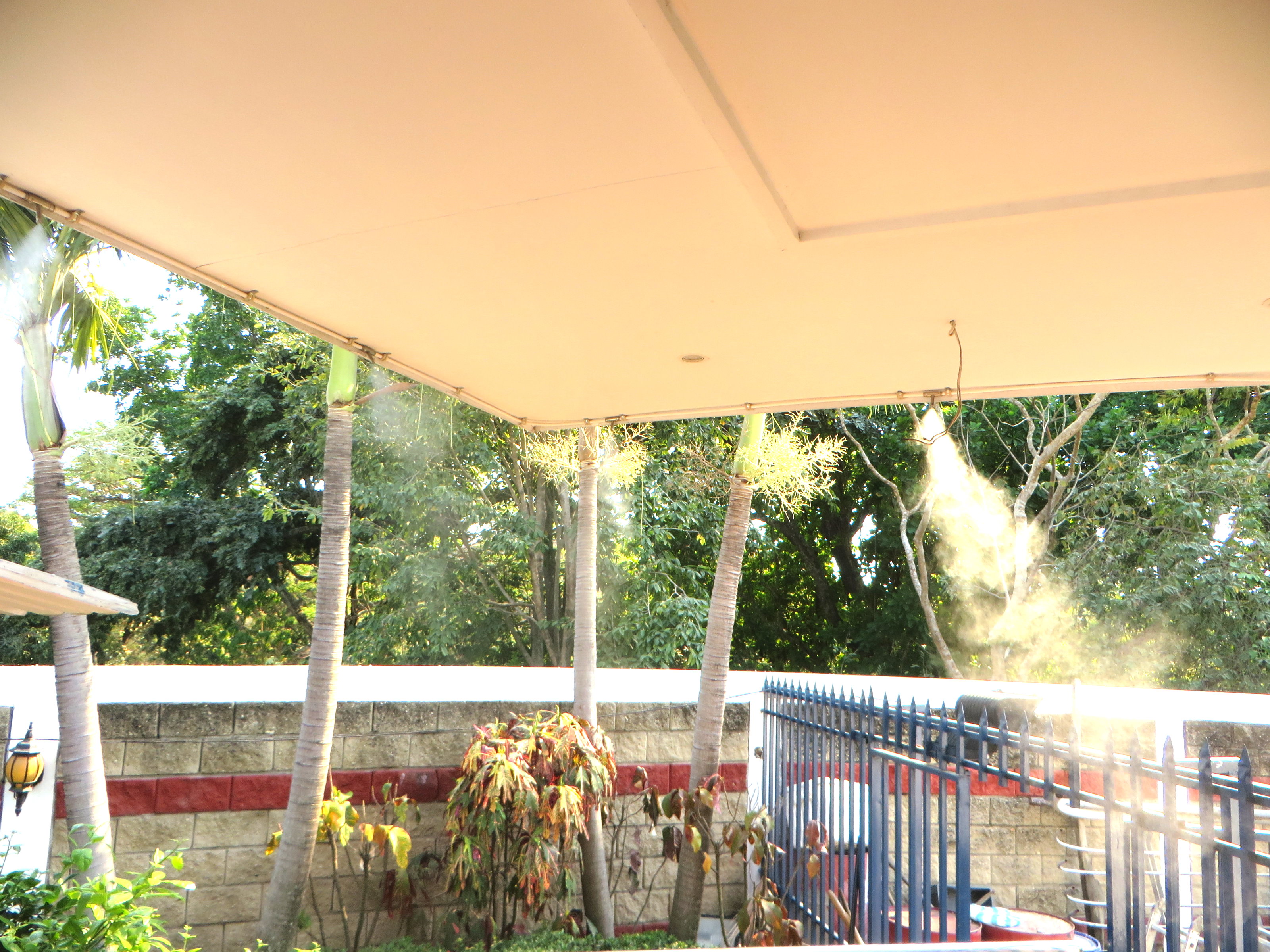
Day 10
24 Jan. 2019
„Congo Mama“ – that is how a lady with apparently African ancestry calls her sales cart at Taganga beach, where she offers fresh juice. Ethnic features are not a taboo in Latin America. Persons with Chinese background are addressed as „chino“ (male) ore „china“ (female). You might hear someone yelling „negrito“, little Negro, without anyone being embarrassed, or likewise „gordo“, fat one (male) or „flaca“, skinny one (female), when calling a person, referring to his or her bodily features. Well, as long as no-one has given them the idea to be upset, they don’t complain. Life seems to be easier this way, the persons concerned laugh and smile, they give the impression of being happier than those who scrutinize every word from dogmatic points of view. Maybe they are even proud of their features, like those who represent „négritude“ in francophone countries. Certainly, accepting things as they are with, a positive attitude, is much more pleasant than automatically starting to argue and fight when you hear certain keywords.
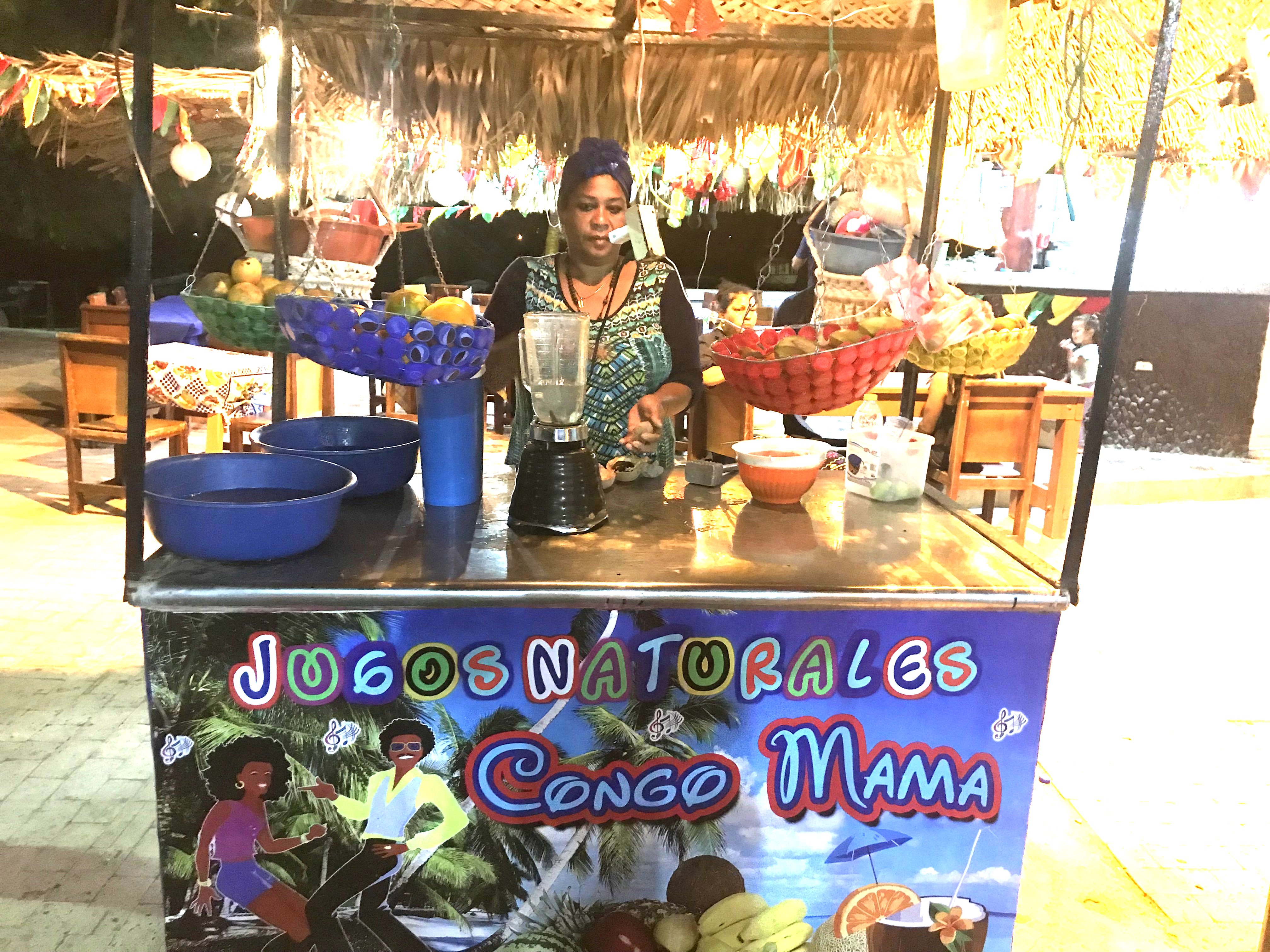
Day 9
23 Jan. 2019
The place where we have taken accommodation in Taganga makes strong references to indigenous cultures. The rooms are not numbered, but have names of indigenous peoples. For example, we reside in the room „Pijao“. Like in a museum, various tools and appliances are on display, as well as photographs and pictures. One wall painting does not only represent a people’s strong connection to water, but coincidentally or intentionally, a modern water dispenser is placed right in front of it, thus hinting towards the fact that the relation to water is culture-specific. This also reminds of the attempt of a certain Swiss global player to have water defined as food, and then to obtain the world-wide license for it. That would have meant that they could have asked all indigenous peoples of the world to pay for their water consumption. The good news is that they have not succeeded. Interestingly, the UN reacted to that with a special department, UN Water, as a sub-body of the Human Rights Dept., in order to clarify all humans‘ right to access to water. UN Water also involved S.A.C.S. (cf. reports at <https://s-a-c-s.net/uno/papers-and-reports-to-the-un/>).

Day 8
22 Jan. 2019
There is a wonderful naturist beach inside the Tayrona National Park, just west of Cabo San Juan. We had two options to go there today, one was on horseback and then wading a few hours through a swamp with deadly poison frogs, the other was taking a speedboat from Taganga. We thought it would be the smarter choice to go for the second option. Well, it probably was, sort of… As so often, the Carribean sea was extremely rough, the boat’s bow kept rearing up again and again, only then to hit the water very hard when it fell back onto it. Speadboats don’t have shock absorbers. When we reached Cabo San Juan, there were two guards sitting in the shade, who cashed about 20 Euro per person as an entrance fee plus an alleged compulsory insurance. So, together with the boat ride, the trip had cost us about 50 Euro p.p. However, once we were at the naturist beach, my wife and I concurred that it was worth it. We had to do a little bit of trecking through the beautiful nature of the Tayrona Park to reach our destination. There were relatively few people on the naturist beach, whereas the neighbouring textile beaches were relatively crowded. The return trip was much faster than the boat ride in the morning, it took only about one hour. One reason certainly was that we had a different skipper, who had a certain testosterone level, and there were some ladies on board, who were in a similar hormone state, and who, by ecstatically screaming, incited him to symbolically display his manhood by excessively using the engine. As an effect, all passengers were constantly exposed to heavy showers of seawater, so that we arrived in Taganga soaking wet and shivering, but happy and grateful for our survival.
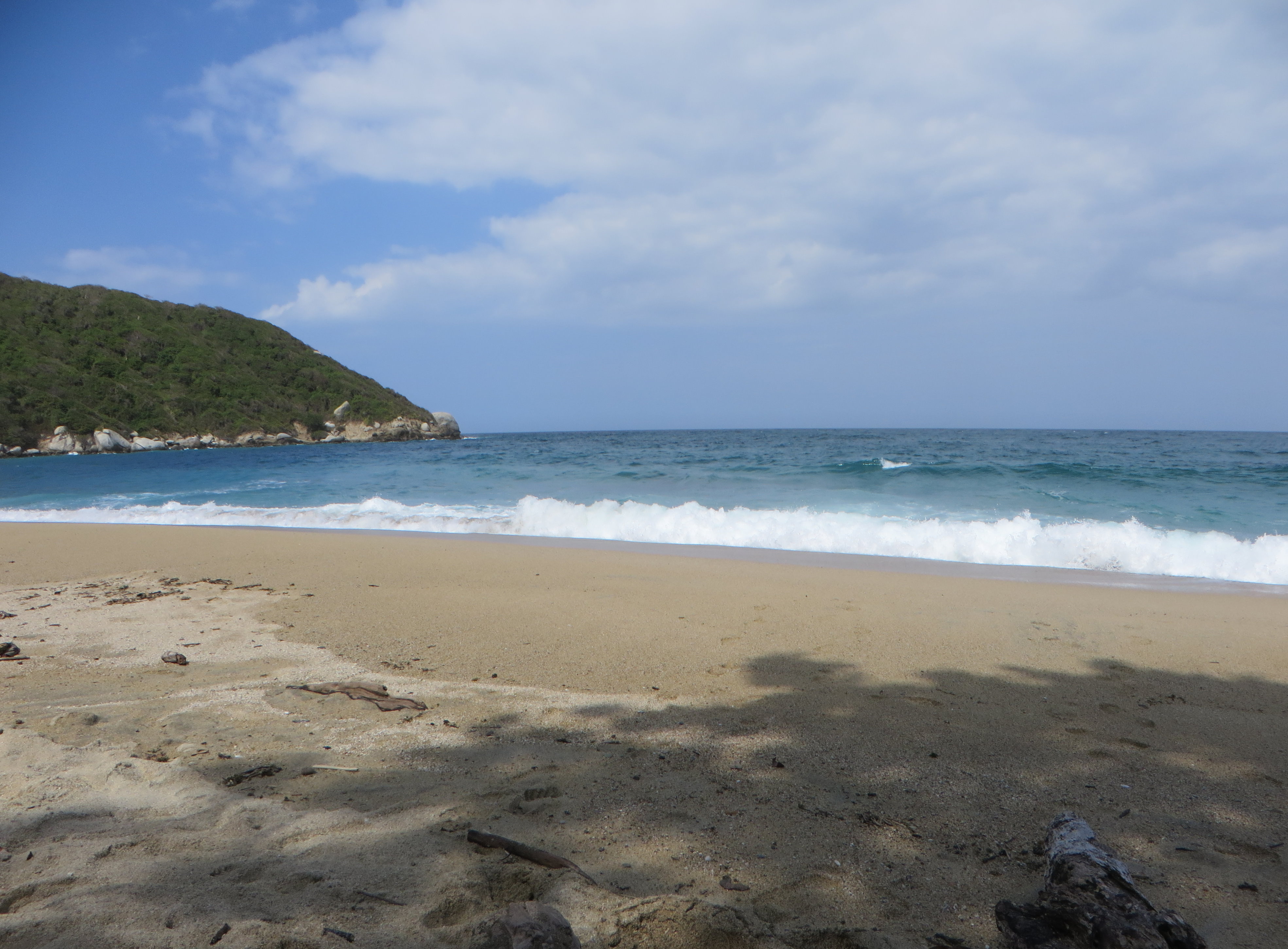
Day 7
21 Jan. 2019
Mermaids are cultural elements that can be found in many places of the world. As mythical figures, they inhabit not only the seas, but also lakes, like in the Alpine region; and rivers, like in eastern Europe. In Latin America, they are popular figures along the coastlines. Since centuries, it was clear within the cultural memory that they were human females from the waist up with a fishtail below the waist. That was it, nothing else. Myth did not entail textile factories at the bottoms of the oceans. Then, Disney started to cover their Little Mermaid’s breast, first with shells, which then mutated to bras. That was somewhat alarming, both from psychological and from semiotic perspectives. Firstly, if she really was that little, there were no breasts to be covered; yet, the paedagogic effect was immense. The cuteness of this seemingly harmless figure had a retroviral effect, as it was an outmost effective medium to implement a rigid standard, even at a very young age, that girls had to be ashamed of certain identity-relevant parts of their body, which previously had not been associated with shame. Regarding body concept and self-esteem, this had a devastating effect, which is still keeping on to unfold. Secondly, this was an irrational interference with the passing-on of cultural content. Due to the dominance of the particular medium, the respective traditions have been affected wherever they existed in the world. The new standards can now be seen globally. Even Alpine mermaids now wear bras. Despite Catholicism, Latin Americans had long been resistant to modifications of their mermaids. But tonight, in Taganga, we saw that the brave new norm has reached Colombia, as a mermaid figure at a mobile juice vendor’s cart is conveying the global taboo right here now.
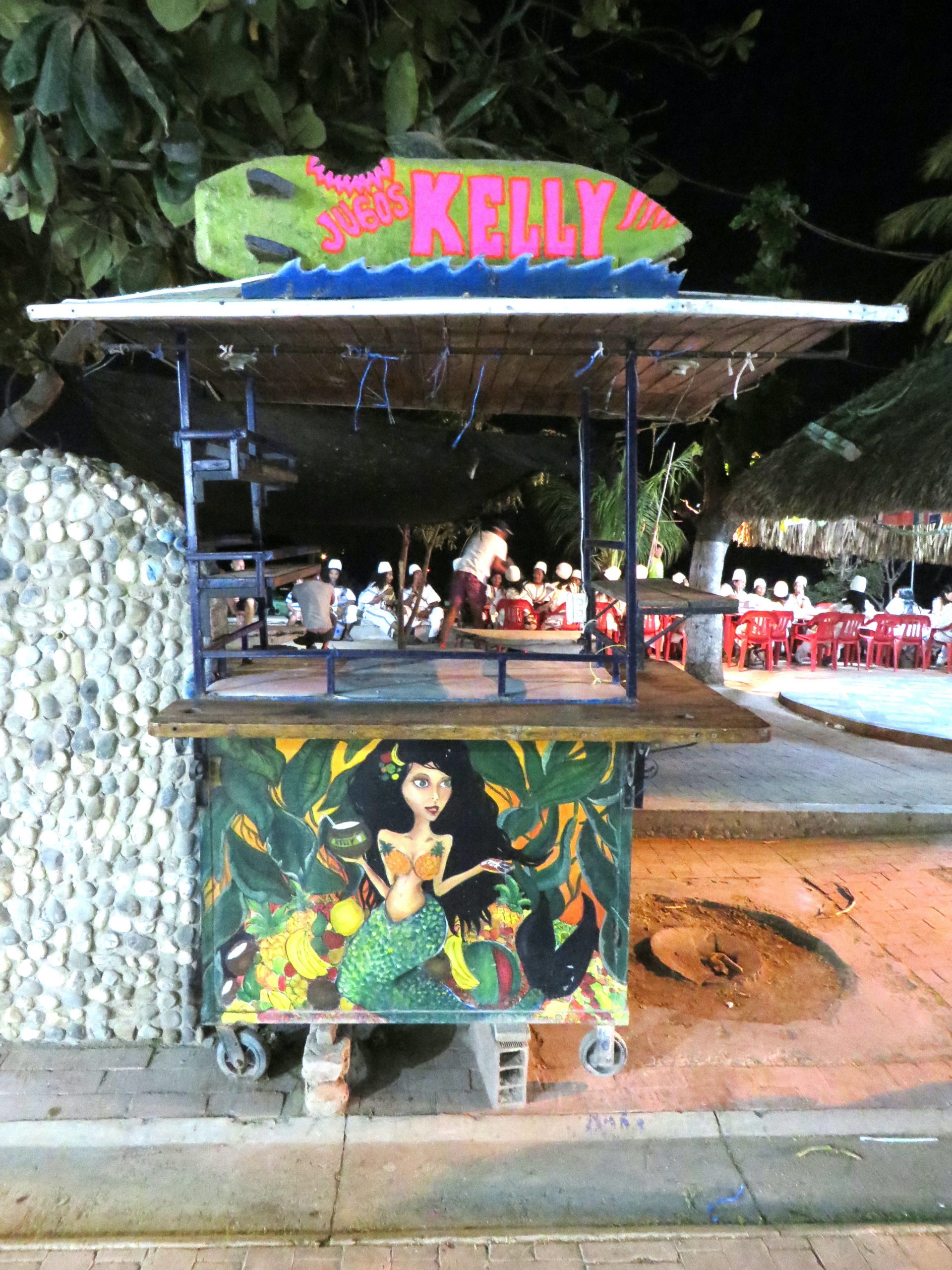
Day 6
20 Jan. 2019
I am not going into the eclipse of the moon, which is ongoing right now, as you can see that from many parts of planet Earth in this very moment as I am writing this entry. Here in Santa Marta, where we have arrived tonight, the waterfront is lined with statues commemorating the pre-Columbian inhabitants of this region. Such statues can be found in many countries of the so-called New World; they are actually an indication of the fact that the indigenous peoples have been either physically exterminated or at least culturally deleted. The statues are about all that reminds of the Arawak people over here. Like indigenous peoples all over Latin America, most of them lived free and uncovered until the arrival of the Conquistadores. Typically, they had some piece of garment that was not worn in everyday life, but used for special festivities only. The Europeans decided then that these were their traditional costumes, which they should wear all the time, unless they fully surrendered to European clothing style. The Arawak had a particular hat, and from this head cover, an entire body cover, a tunic of the same material, was derived and even today proclaimed to be the typical dress of the Arawaks‘ descendants. However, if there are any of these descendants left in nowaday’s Santa Marta, they would wear that only on folkloric or touristic occasions. Apart from that, you will hardly discern them from other Colombians, as not the European immigrants have integrated into the culture of the locals, but vice versa.
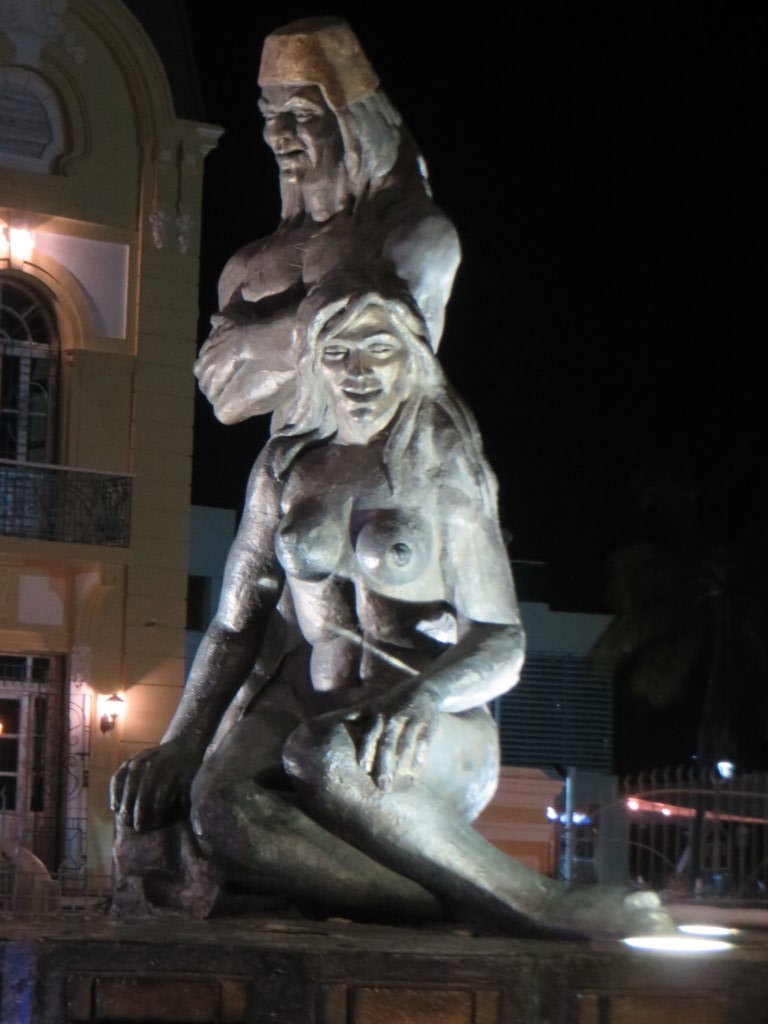
Day 5
19 Jan. 2019
The presentations of textiles as central elements of certain dances originally had a particular meaning that nowadays has largely been lost and forgotten. Weaving textiles was laborious in pre-industrial times, and therefore, textiles were very costly. In Antiquity, serfs and children, thus the majority of the population, went without clothes, and only the small upper stratum of the society more or less permanently used textiles, thereby showing their wealth. Later, in the Middle Ages, textiles became more and more available for common people, who were nevertheless reluctant to constantly use them; in the Modern Age, textiles were still expensive, and families kept costumes for special occasions. They were presented at festivities, and especially the women proudly showed their riches. Flamenco and related dances are typical examples of that. In the Sincelejo versions of the Fandango we saw tonight, the women presented their clothes, repeatedly swirling their skirts through the air during each dance, while each man had to hold a bundle of burning candles, which he also passed to the woman during the dance. This is an interesting division of roles, as taking care of the fire had been a female role since ancient times. But that had been shifted to the men here, so that the women could primarily concentrate on their textile presentation. Of course, fire symbolises passion, and presenting family wealth is a female role in many cultures; in some of them, women have to carry the family’s gold around their necks. However, today’s spectators of dances in which weight is put on the textiles hardly know or think about the origins, but nevertheless still enjoy the colours, patterns and moves.

Day 4
18 Jan. 2019
Bullfight is an archaic phenomenon, and Sincelojo’s Fiestas are based upon it. There were cults around bulls already in ancient Crete and Egypt. Cultural descendants still exist today, like the bull jumping ceremony in Ethiopia. Another descendant, the Mediterranean bullfight, overlapped with another particularity that existed in that region, the worshipping of femininity, which might date back as far as the ice age, when parity was vital for the survival of the community. It was later transformed into the cult of the vestal virgins, who had to take care of fire (a certain connection to the Phoenix cult of Persia), which was then superposed by the cult venerating Isis holding the infant Horus, which was then re-labelled to the cult of adoring Virgin Mary, the semiotics of which have roots in the Roman virginity cult, which, in turn, has roots in the prehistoric maternity – and this: fertility – cult (like the Persian Phoenix cult, which comprises symbols relating to that). Likewise, the cults pertaining to bulls were/are fertiliy cults. No wonder that these cultural elements go along together in festivities – bullfights and adoration of virgin mary. In the modern, carnival-like version of Sincelejo, there are dancing girls on the floats. People squirt water, beer and spume on each other, especially men on women – another fertility symbol. The masses go crazy, there are mounted police with truncheons, security controlls, heavily armed and harnessed police, for good reason: There were 500 fatal panic victims at one of the Sincelejo Fiestas a few years ago. Tonight, panic started when the crowds were wating for a concert. All of a sudden, people were running from both sides of the square, and so did we, taking shelter first behind a wall and then in a corner restaurant, where musicians right next to it were jamming, giving an alternative concert.

Day 3
17 Jan. 2019
Hundreds of people queuing in the blistering sun for hours in order to have a dip in the gray mud of a volcano… I had my doubts, though, because the just 15 m cone of the alledged Totumo volcano is stabilised with plastic fibres and wooden planks; also, it does not smell of sulphur as it usually does at volcanic sites. There is a 5 x 5 m, timber-framed pool on the cone summit, filled with that creamy substance. Buoyancy seems to be stronger than that of the Dead Sea, so that you float like a cork.
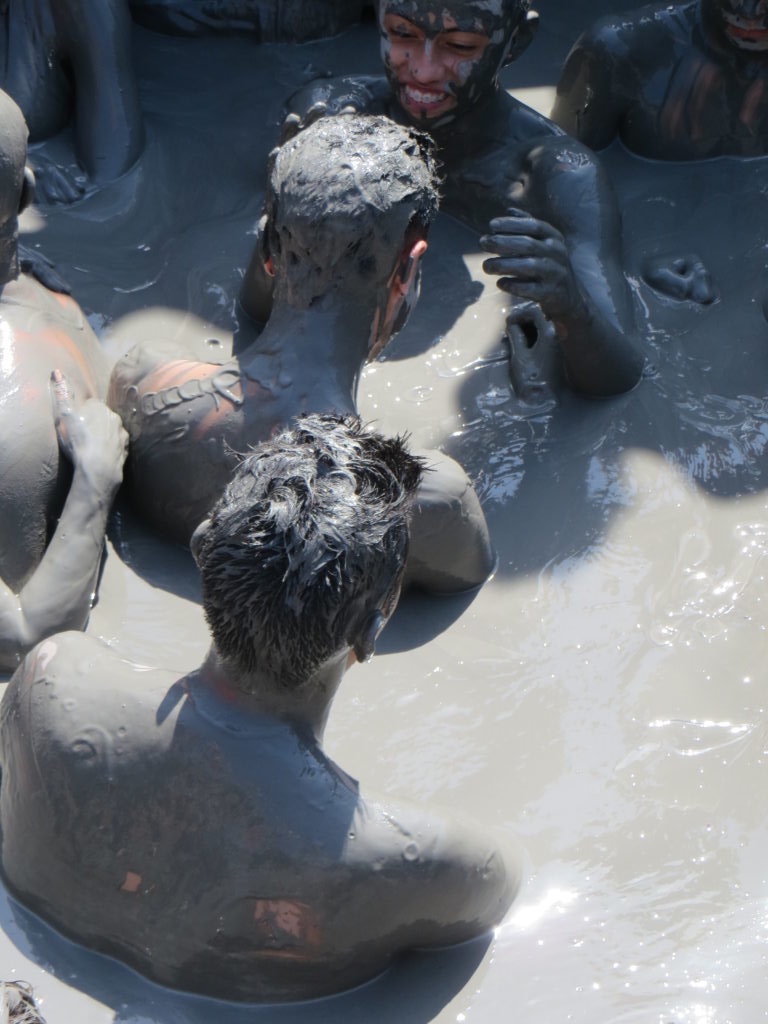
Day 2
16 Jan. 2019
Cartagena resembles to Panama City; some parts of it are also similar to Cuba, and so is its population. Caribian diversity and multiplicity of ethnic backgrounds, who all contribute to that blend of culture, or subculture wit its further subcultures. Yet, there is a paradox relationship of tourism and local culture. Locals try to please the tourists with the amenities of globalisaton. Today, we had breakfast in a „local“ restaurant, which turned out not to be so local at all. No local guests and dominant music, as you would hear it just as well in Europe, North America, Australia… This way, they are abolishing their authentic culture; consequentially, tourists will wonder why they should go to places that can be found by the thousands in locations that can be reached much easier… The solution would be here, as generally, to find ways of reinforcing authenticity.

Day 1
15 Jan. 2019
For us, that day had 30 hours. Berlin-Amsterdam-Bogotá-Cartagena. From German winter to tropical 30 degrees.


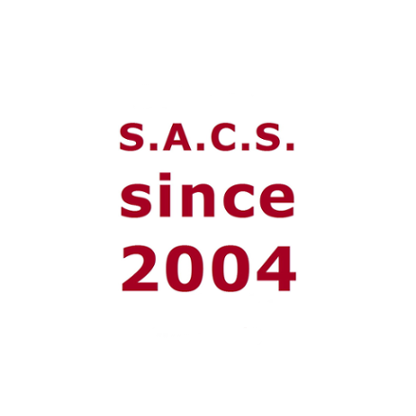
 Relevant for anyone visiting an indigenous culture
Relevant for anyone visiting an indigenous culture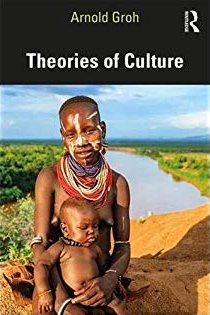 New textbook
New textbook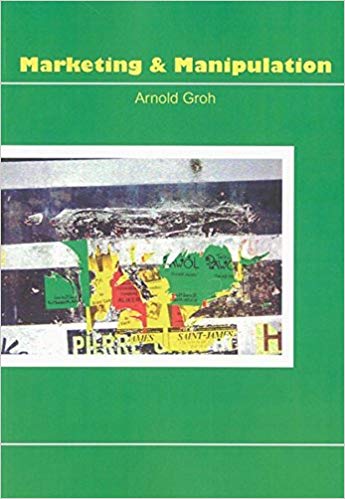 Textbook
Textbook